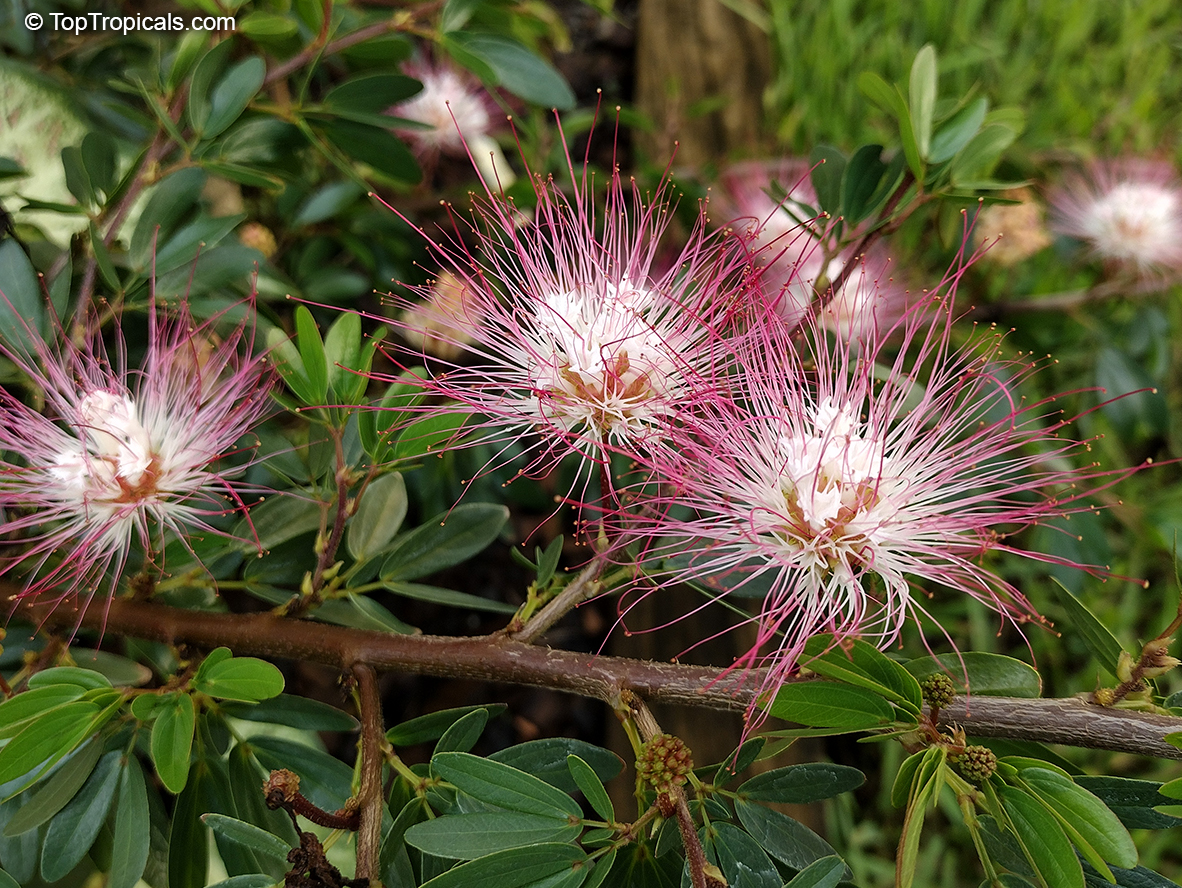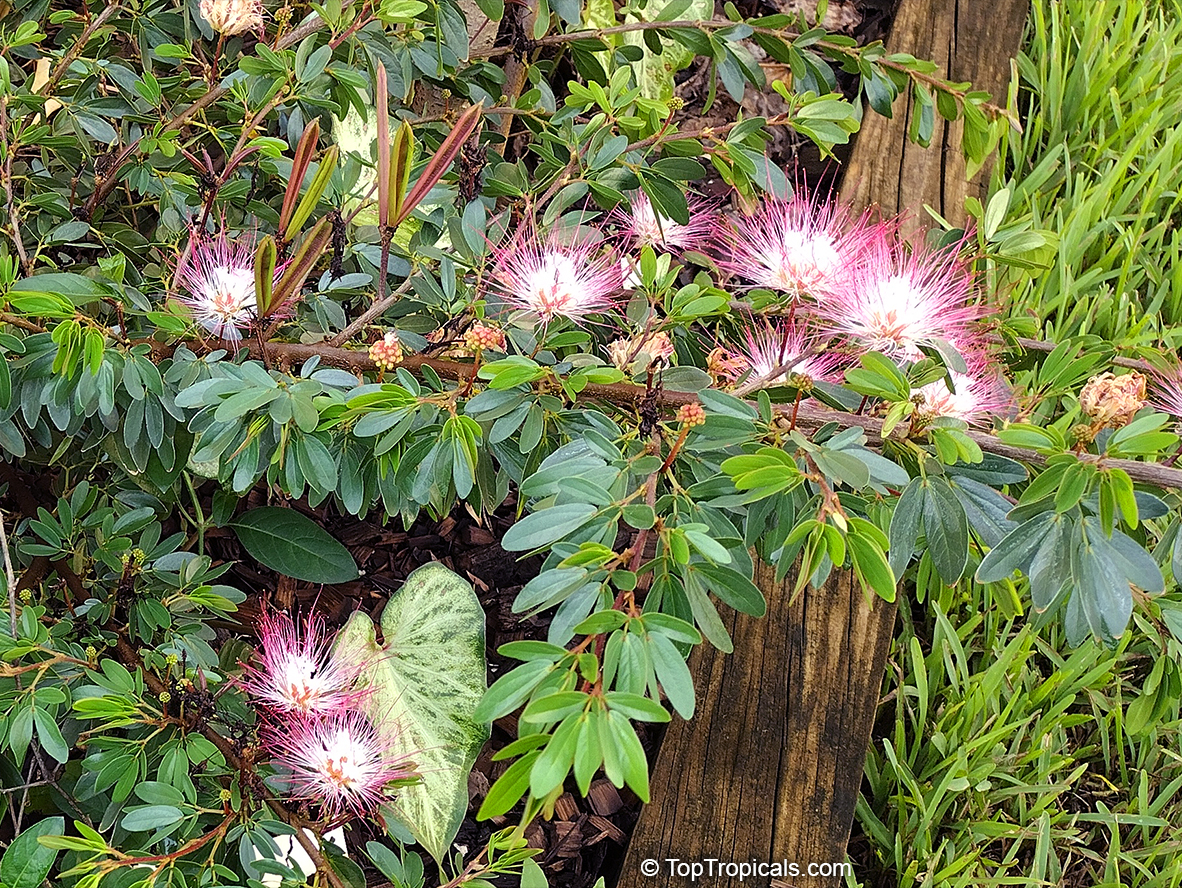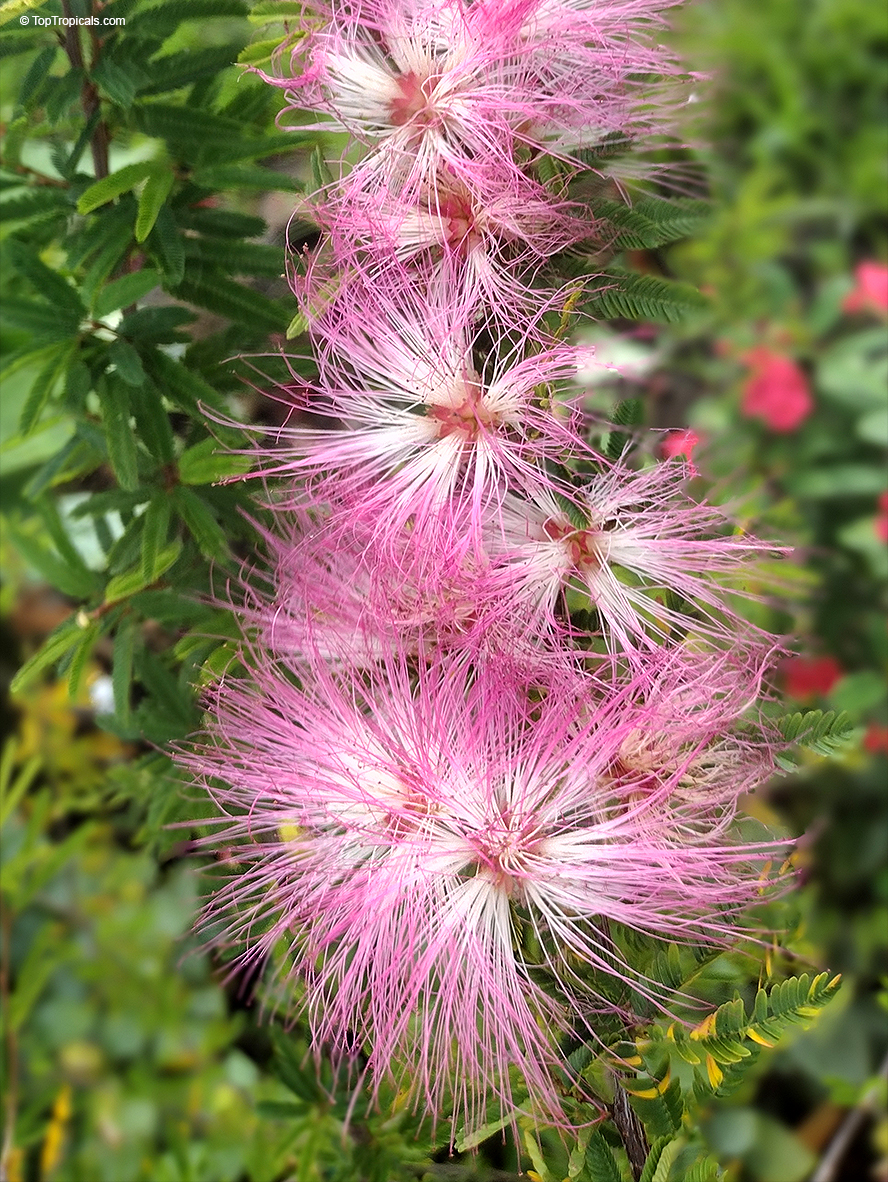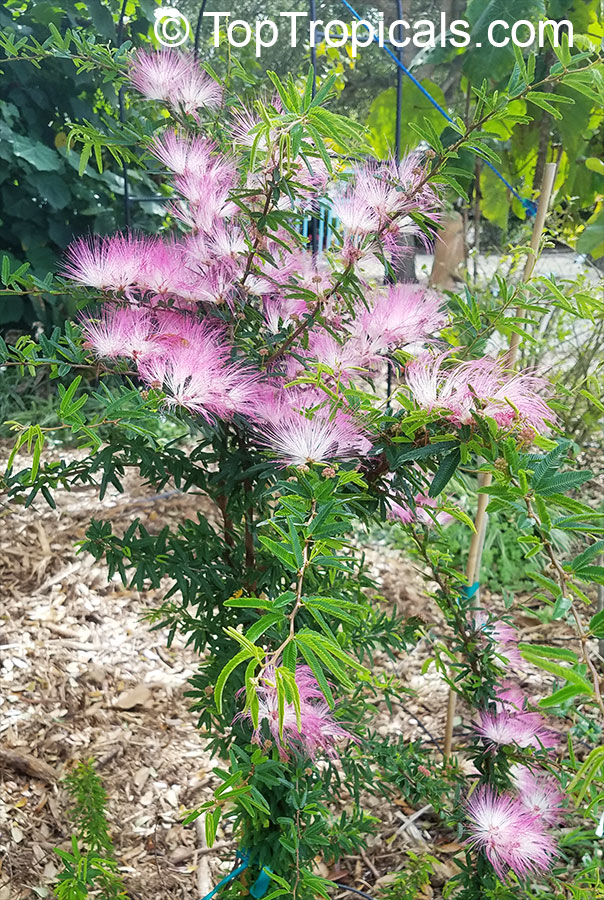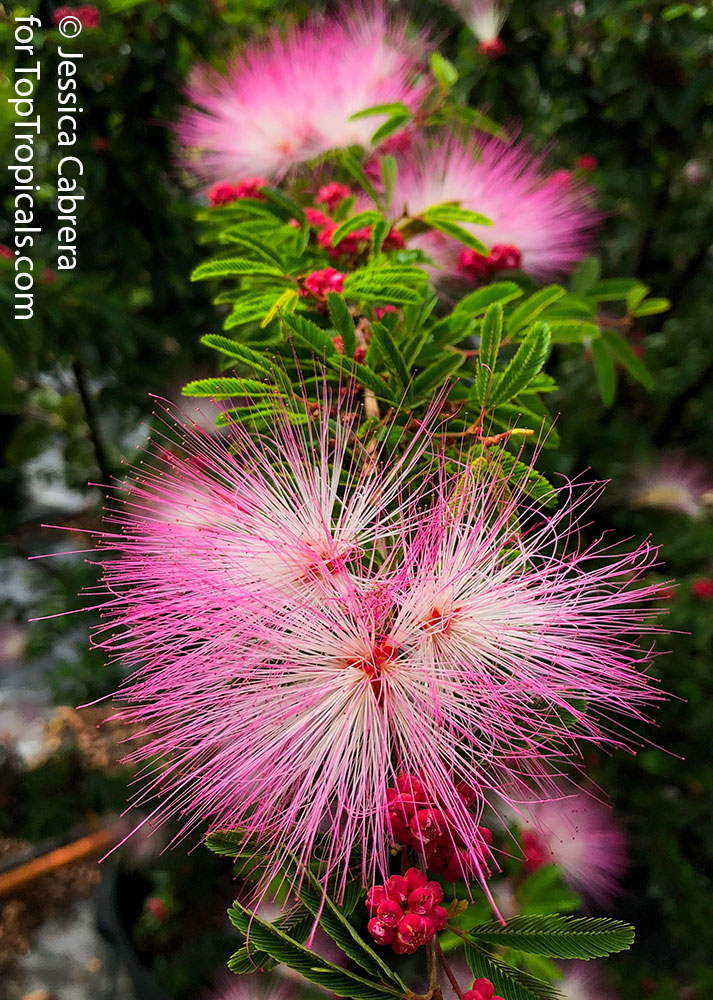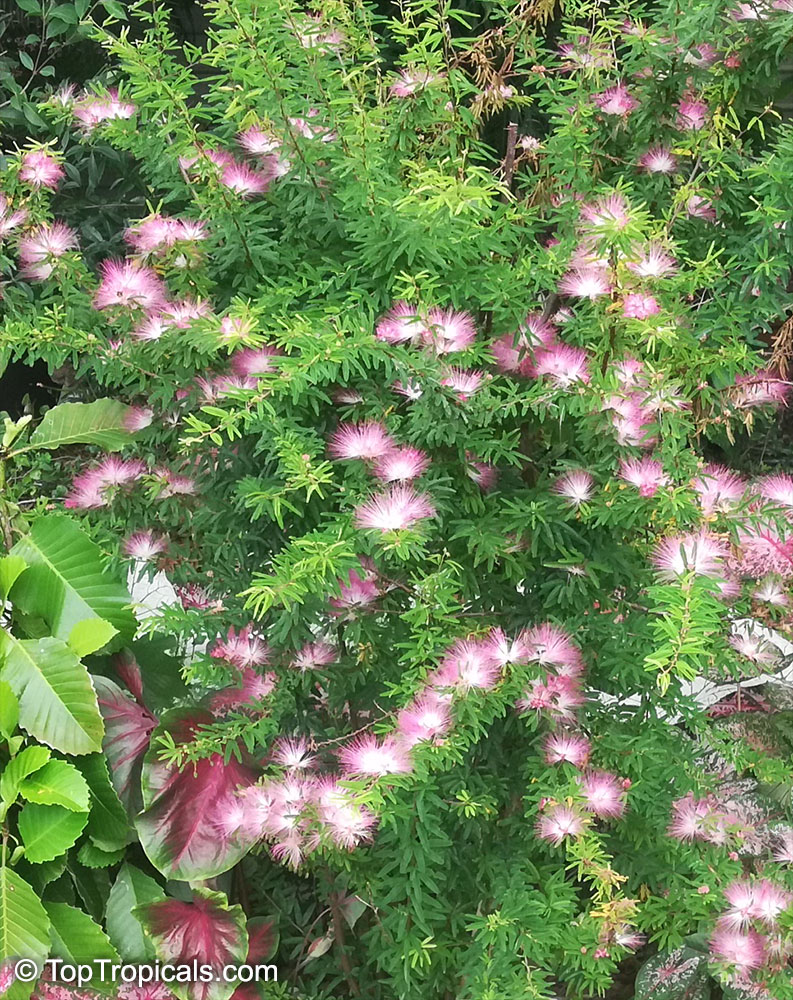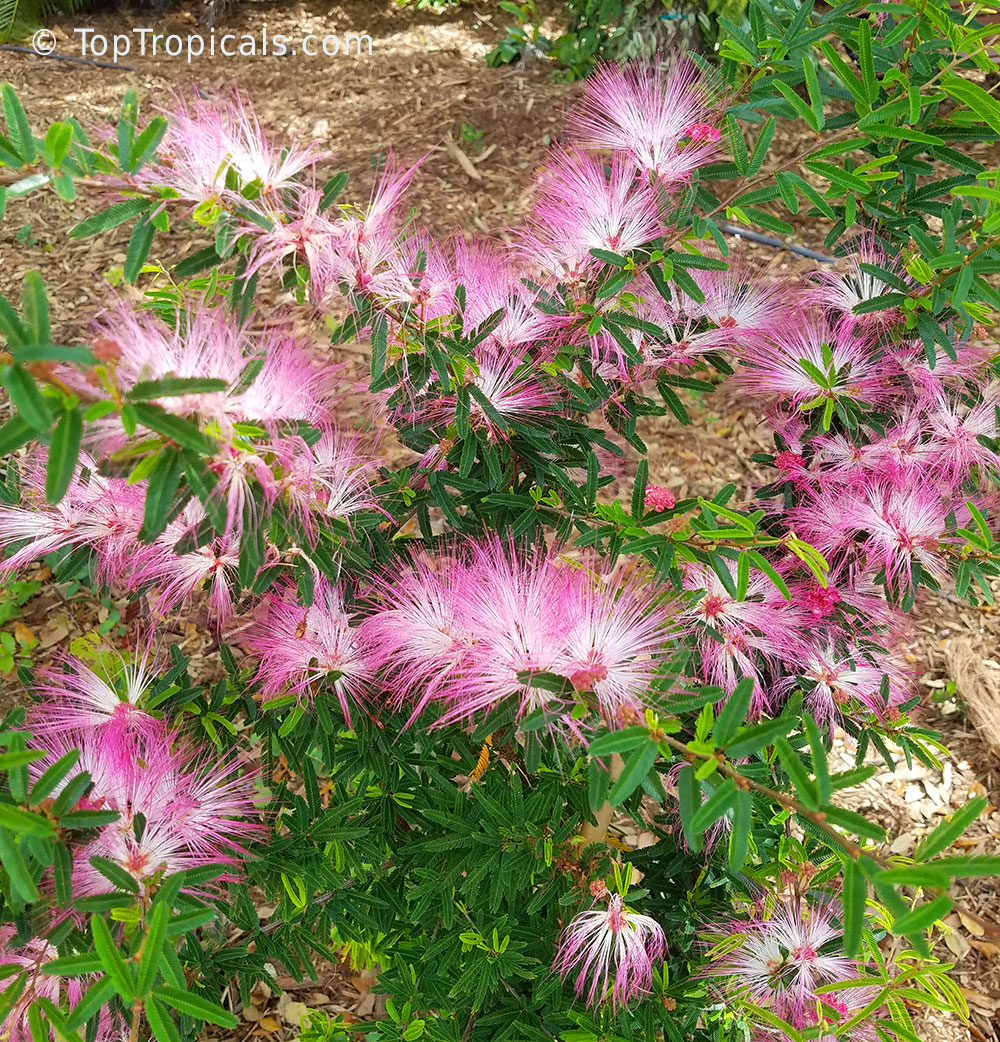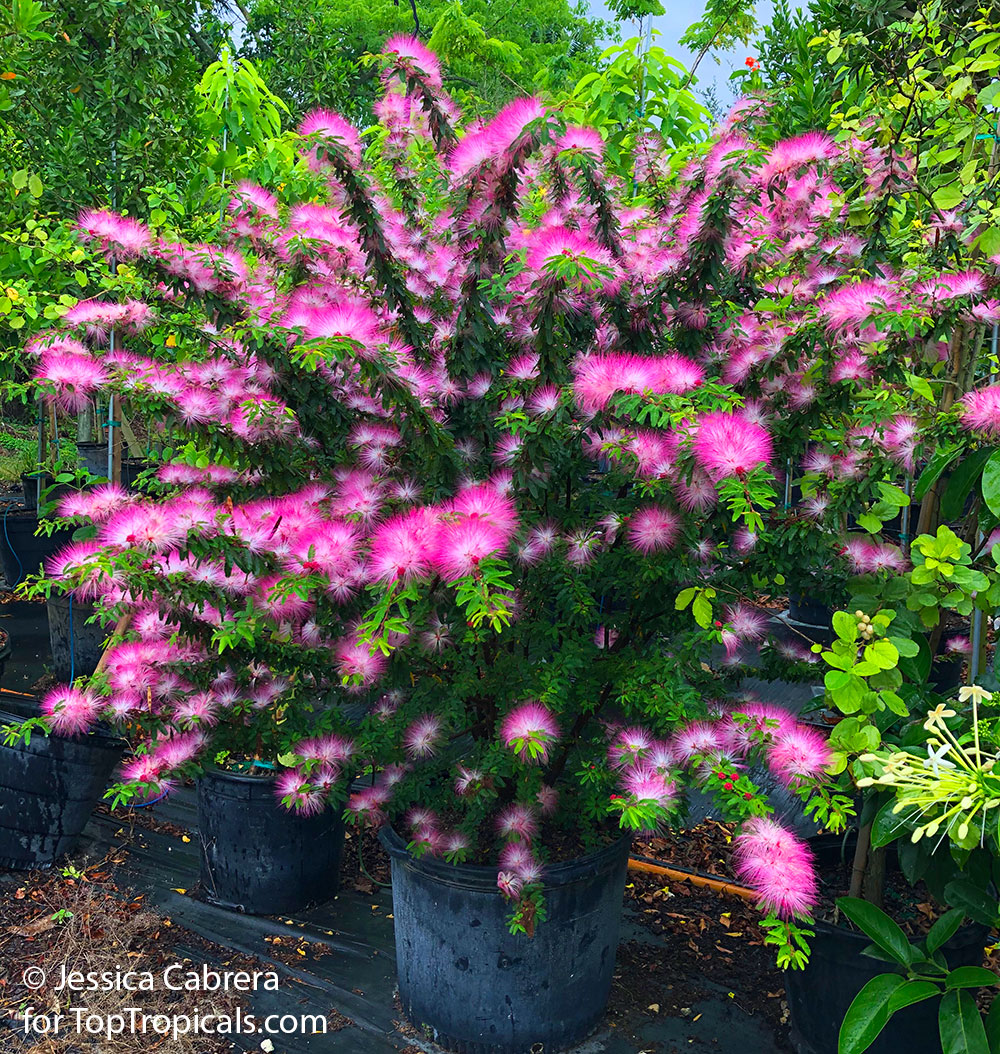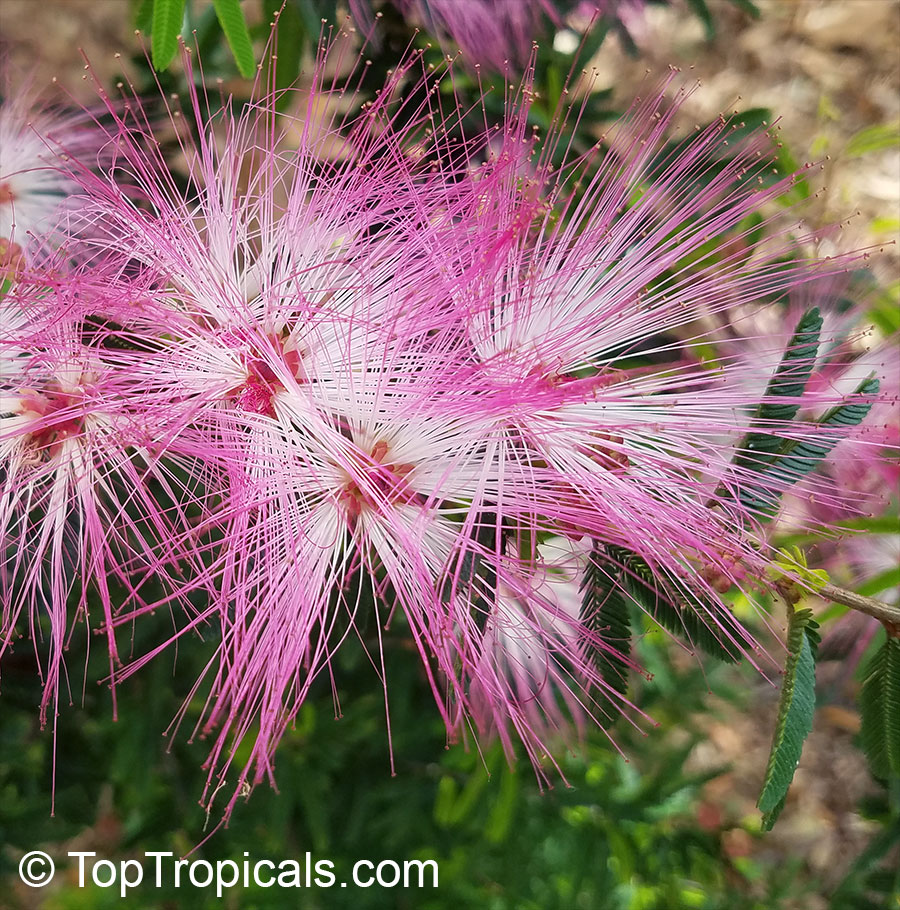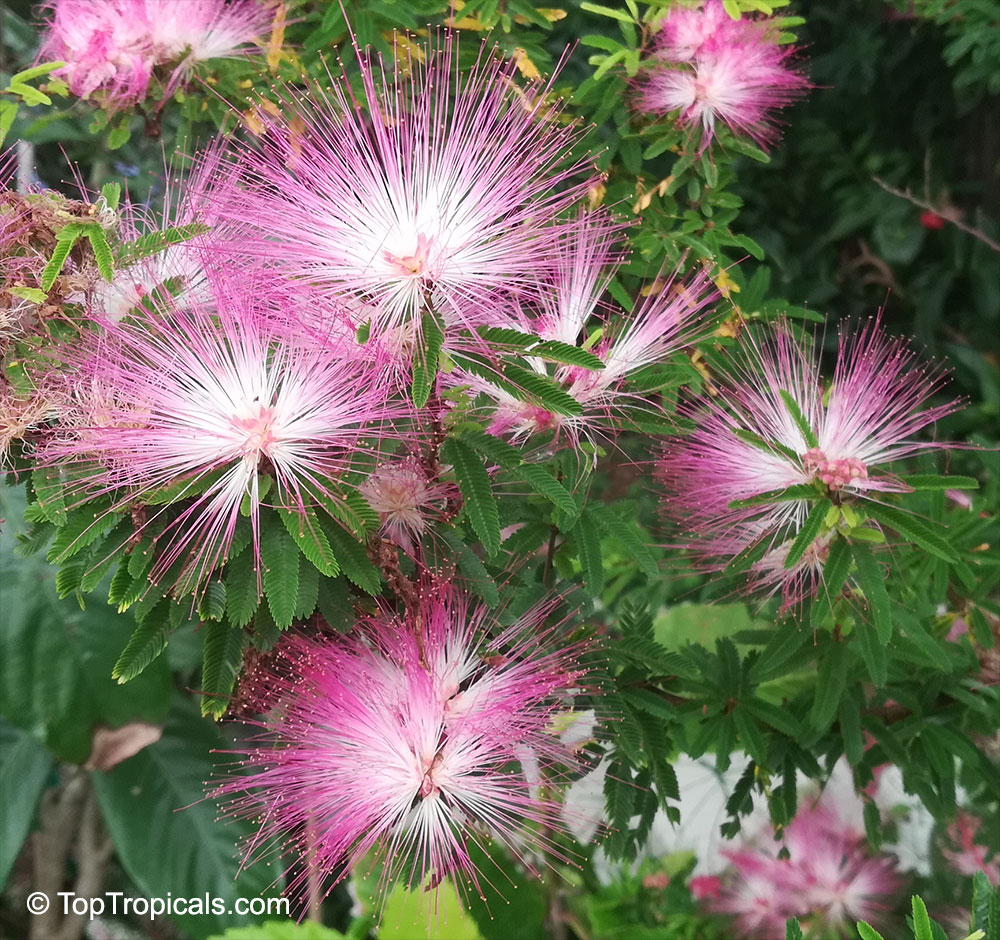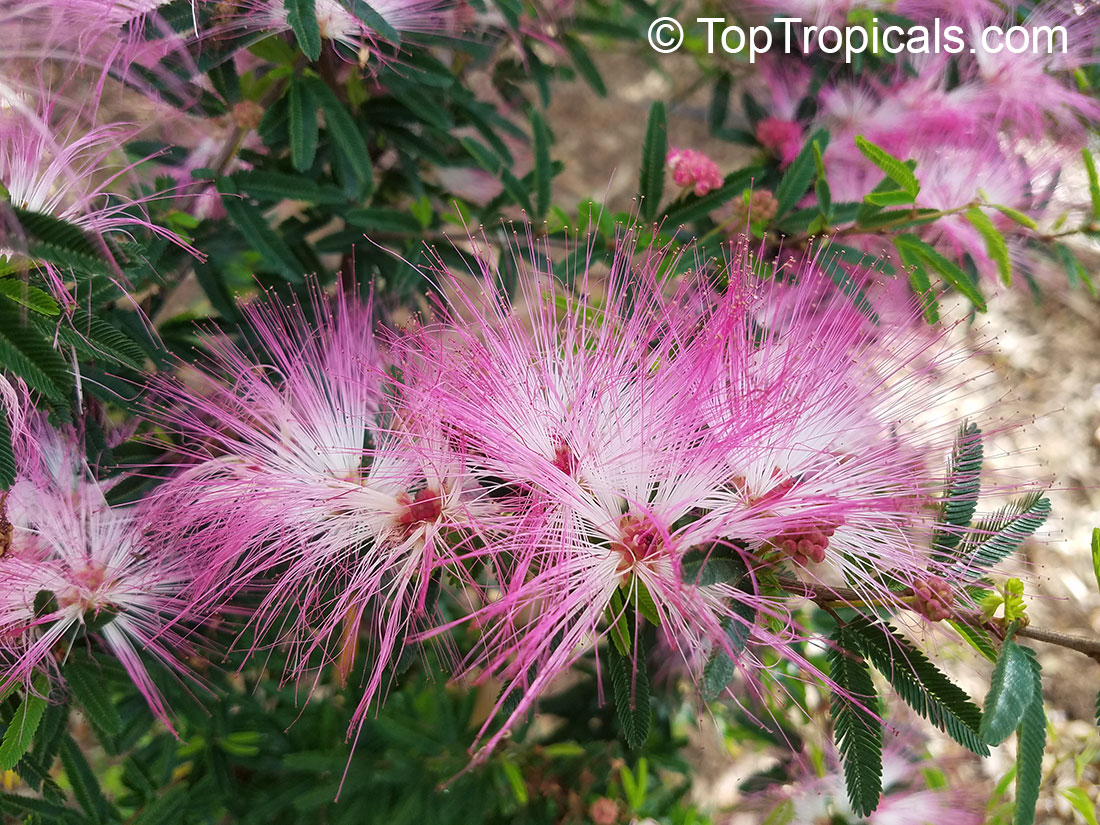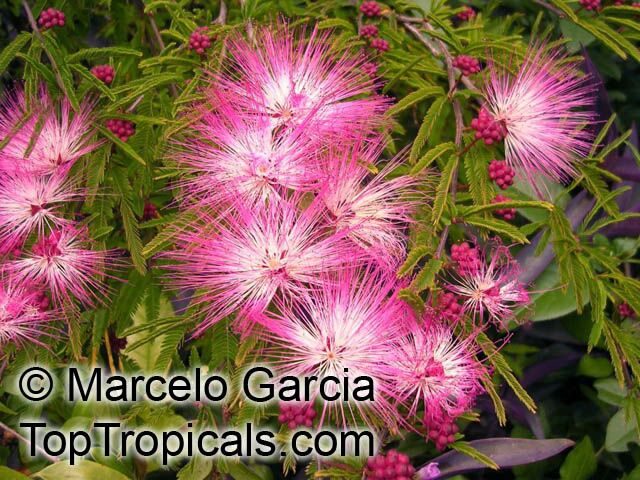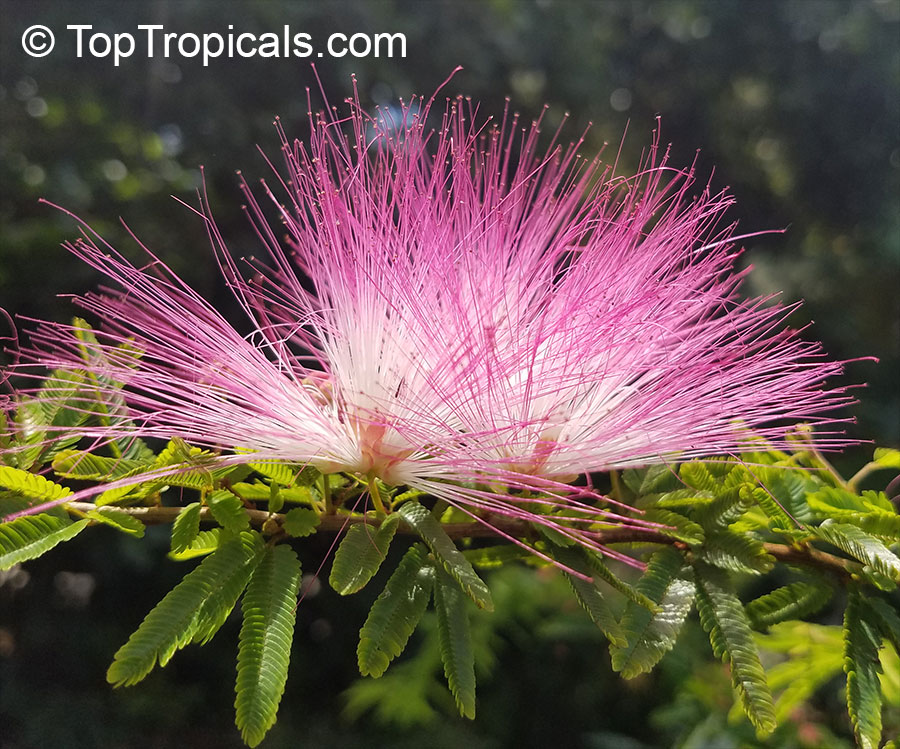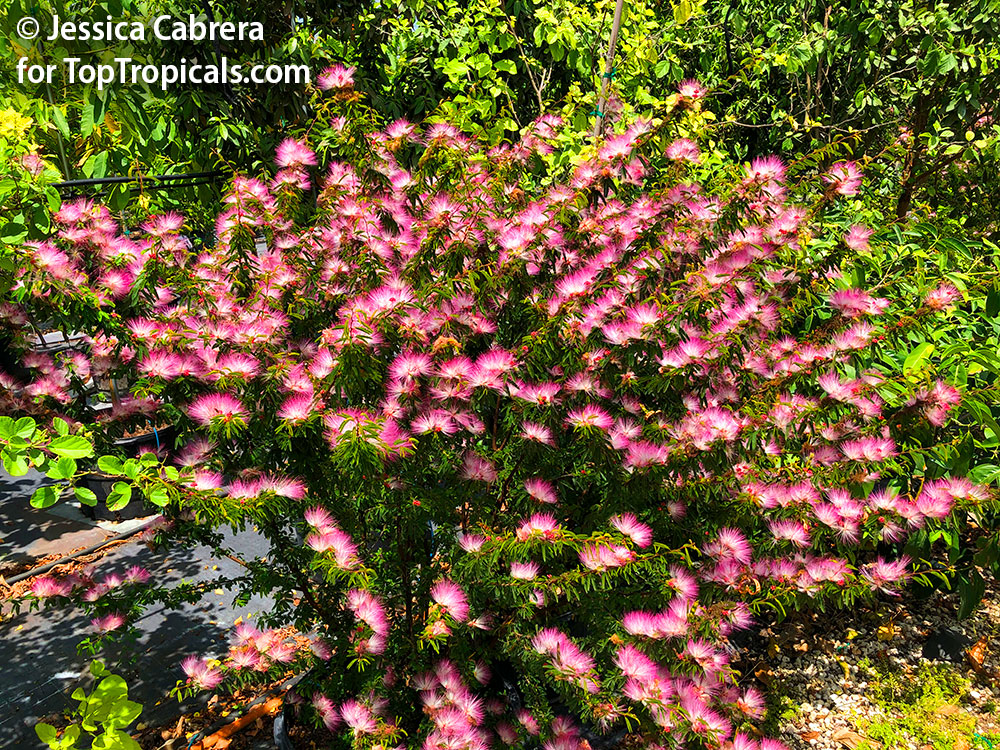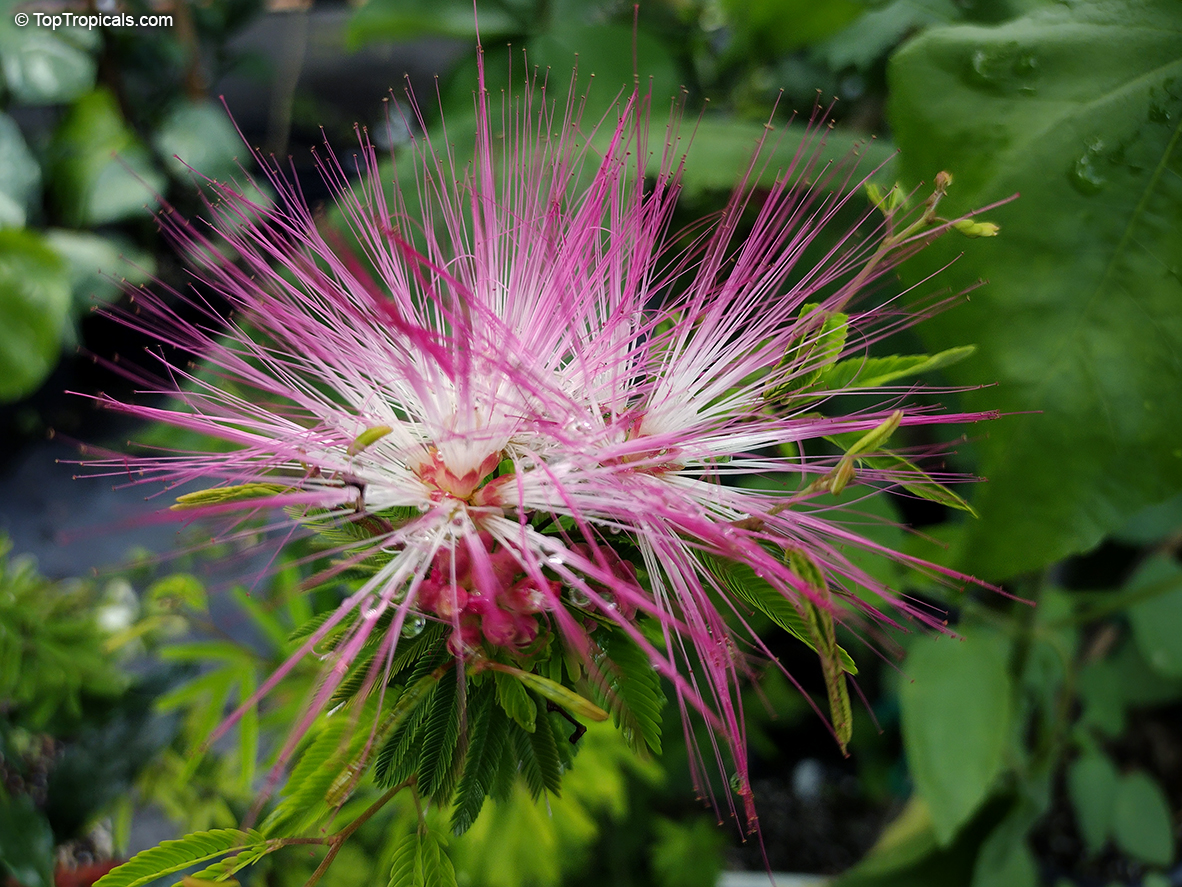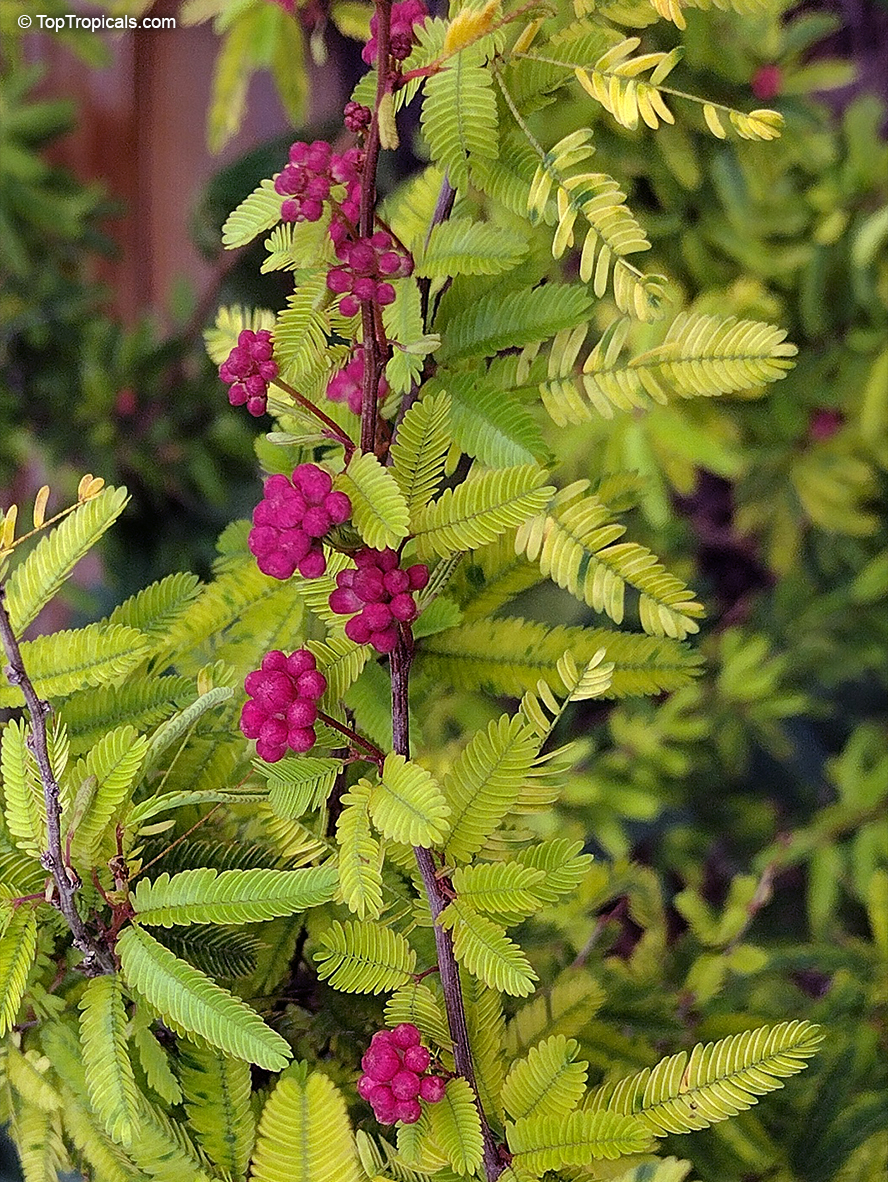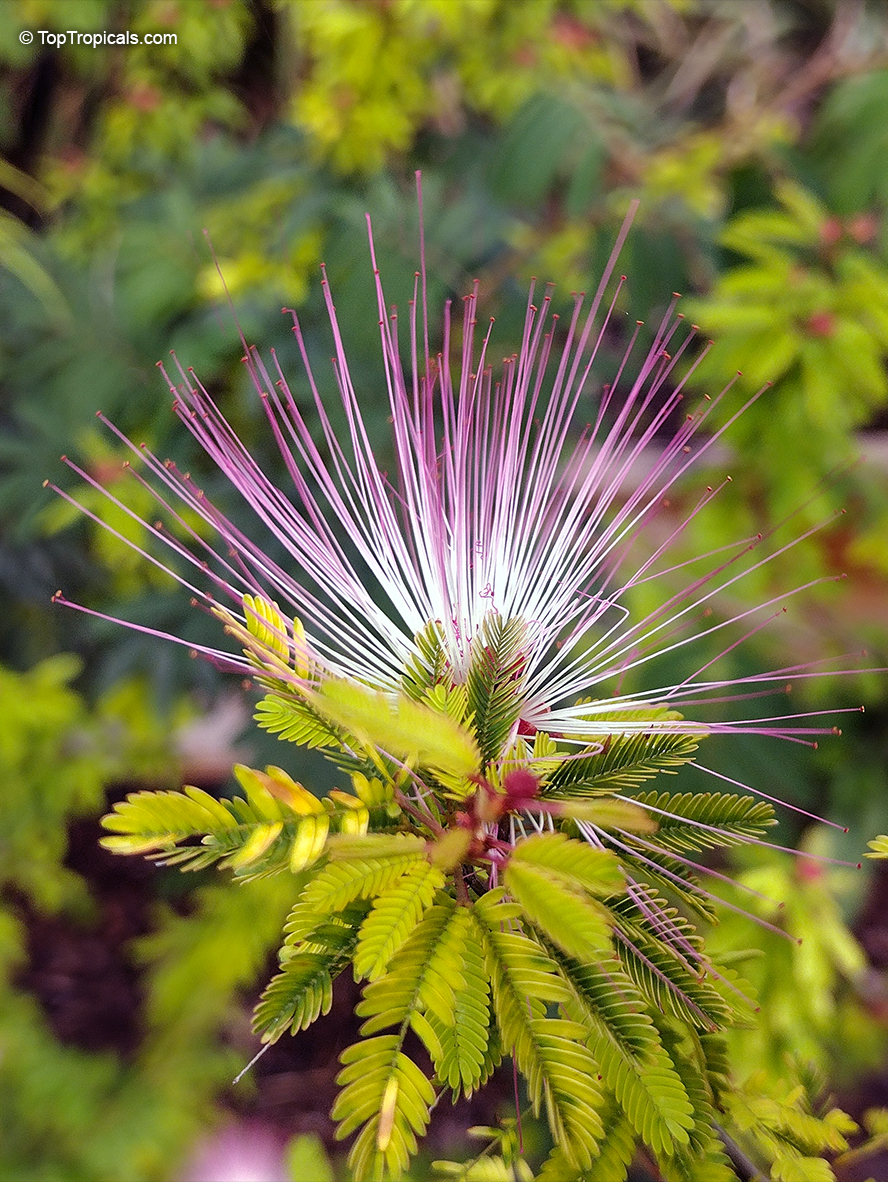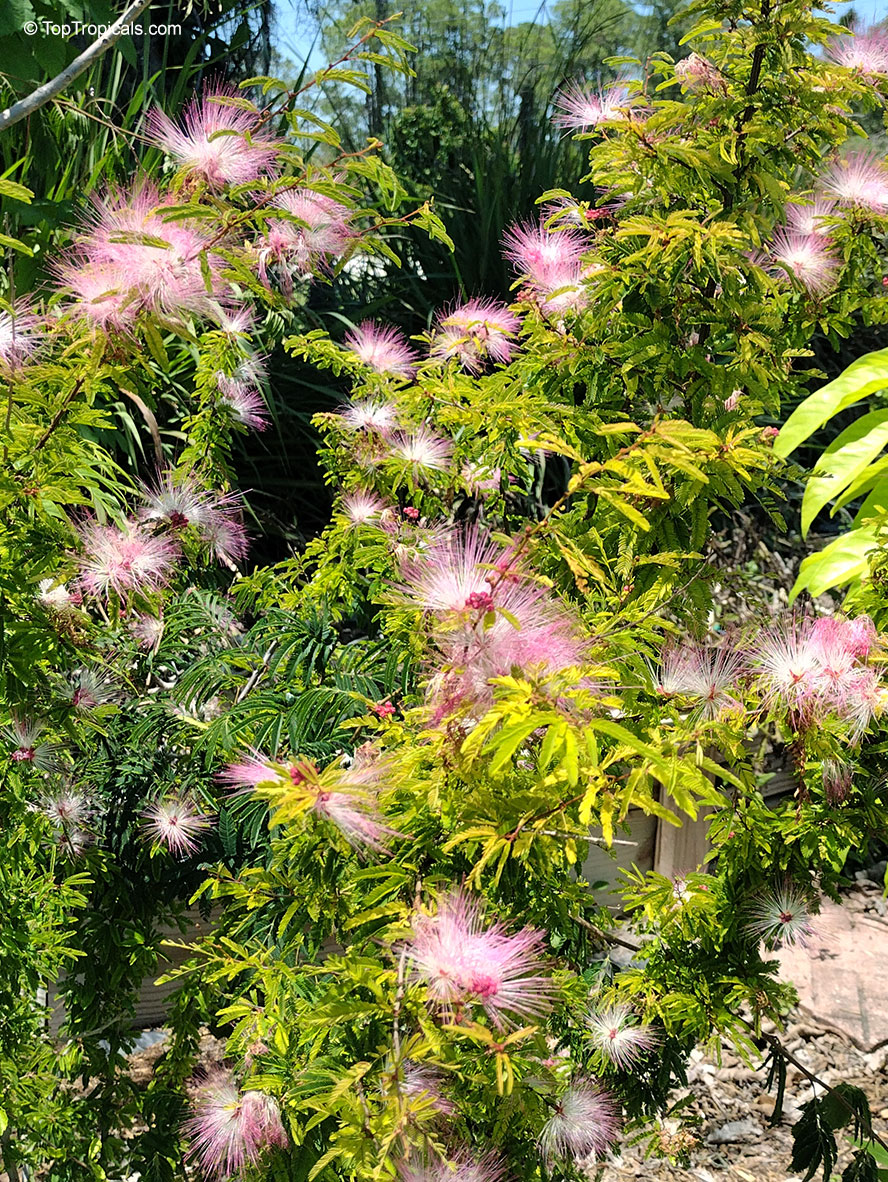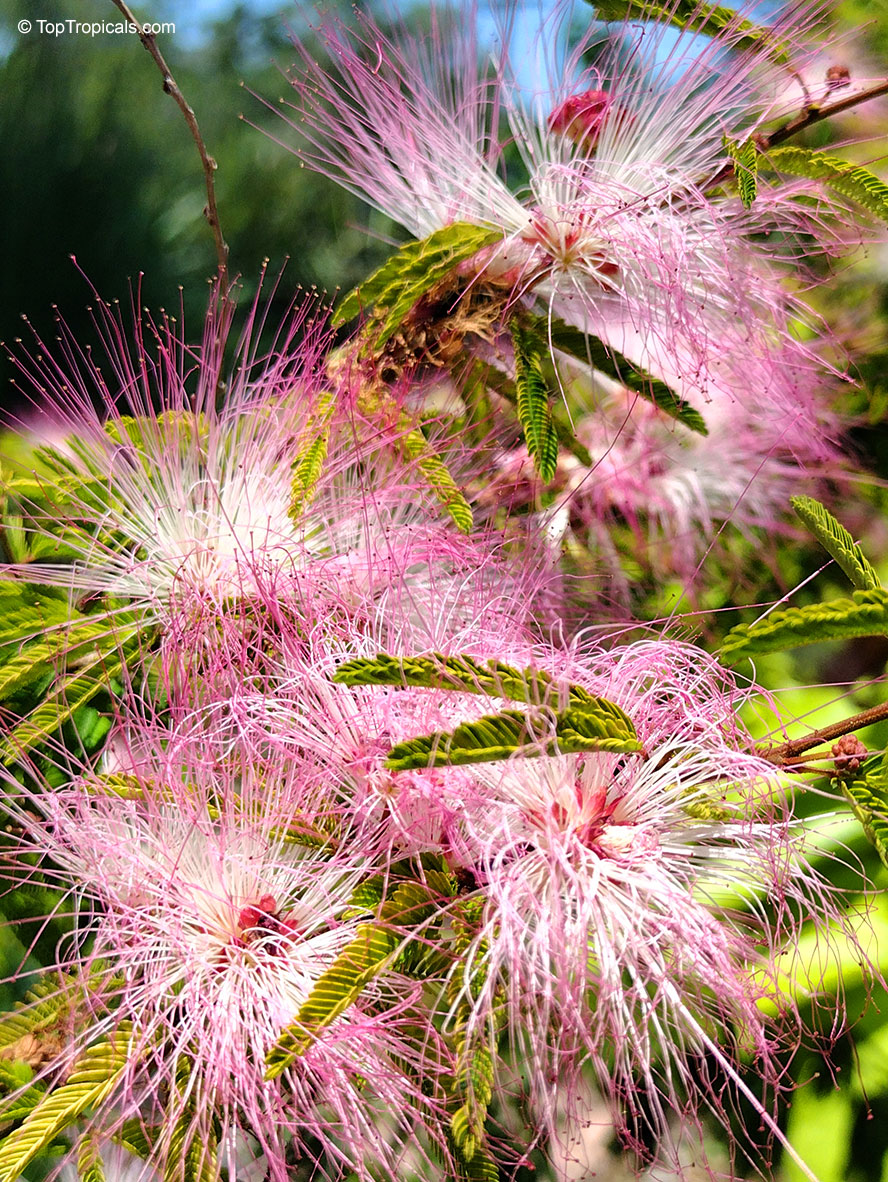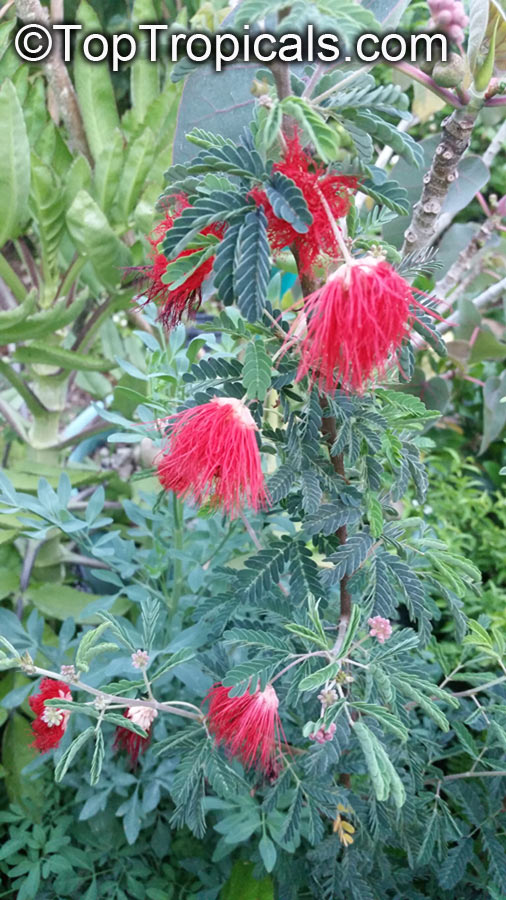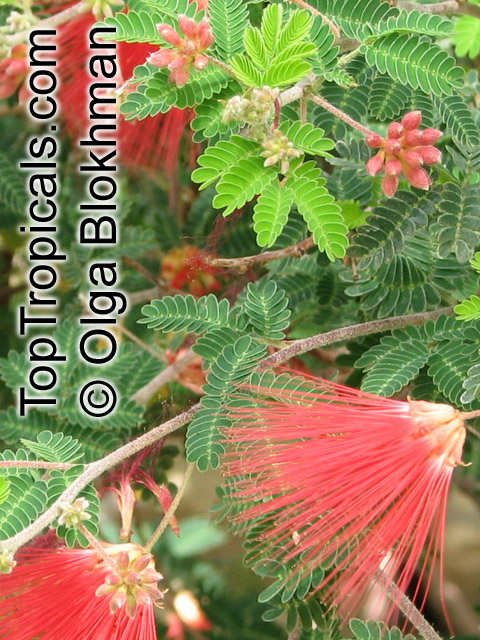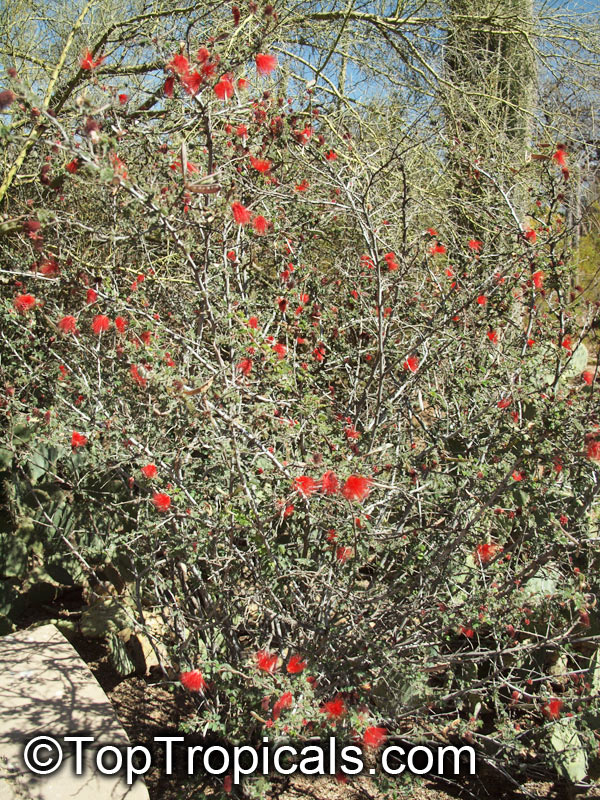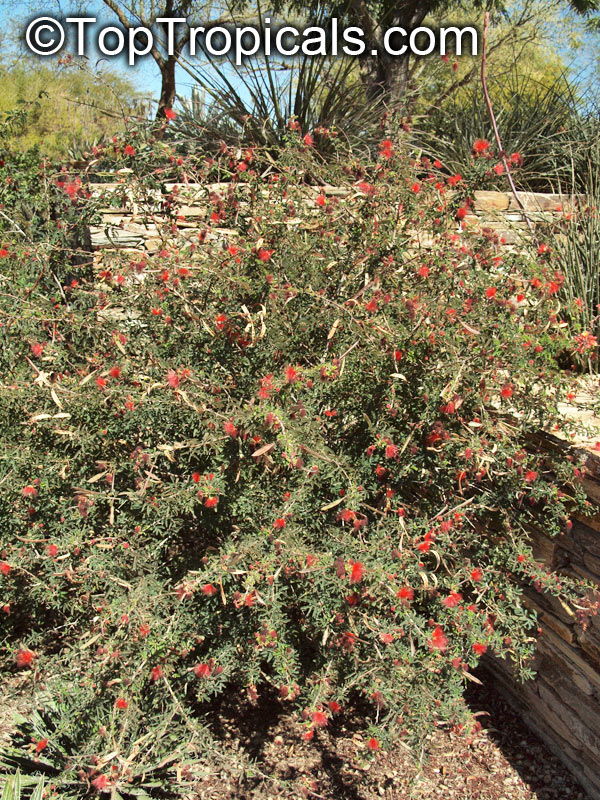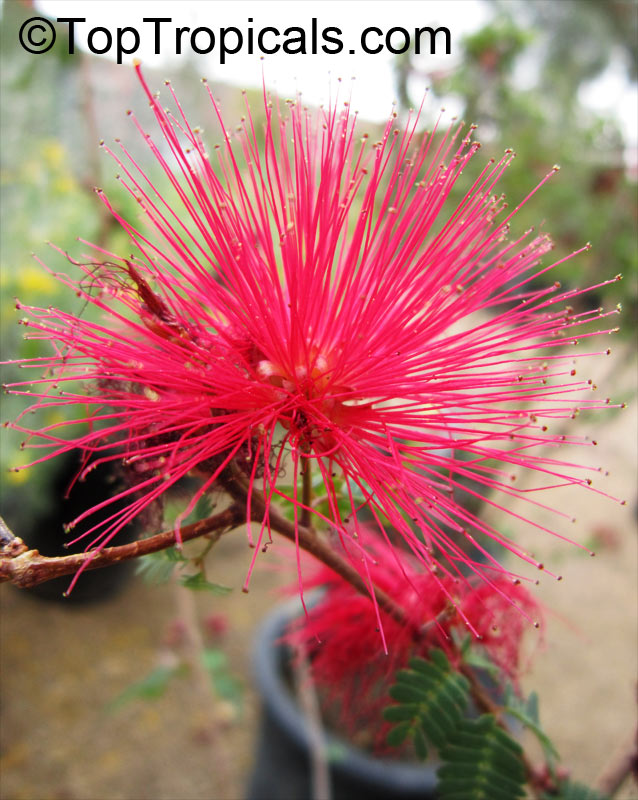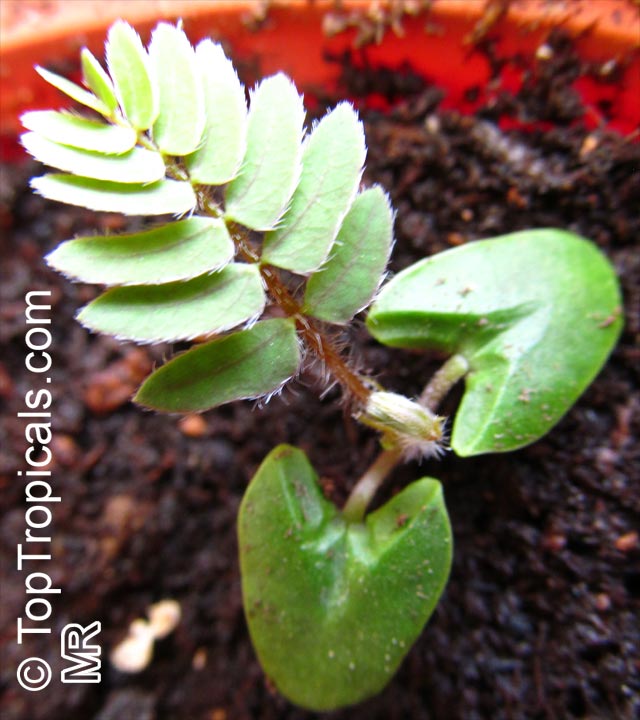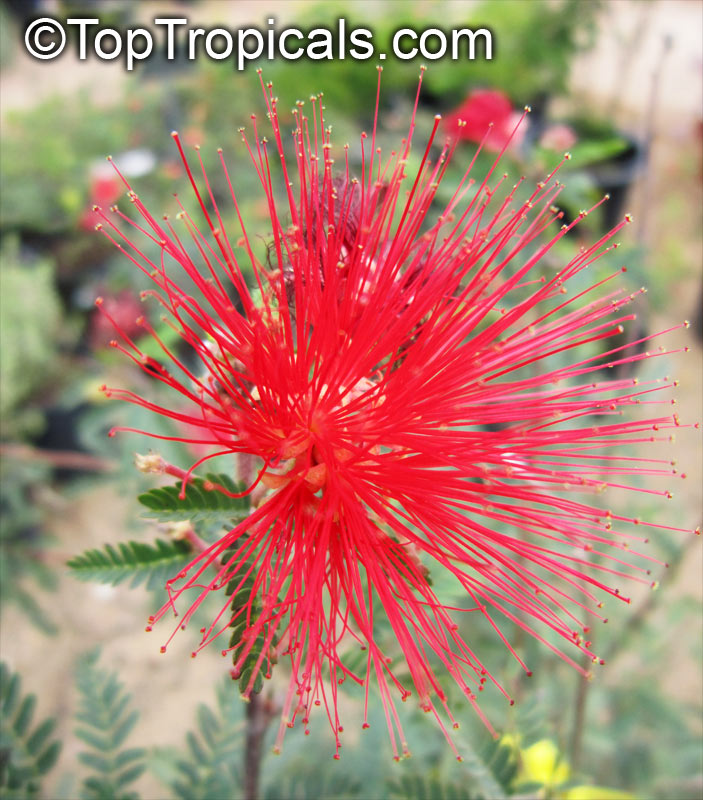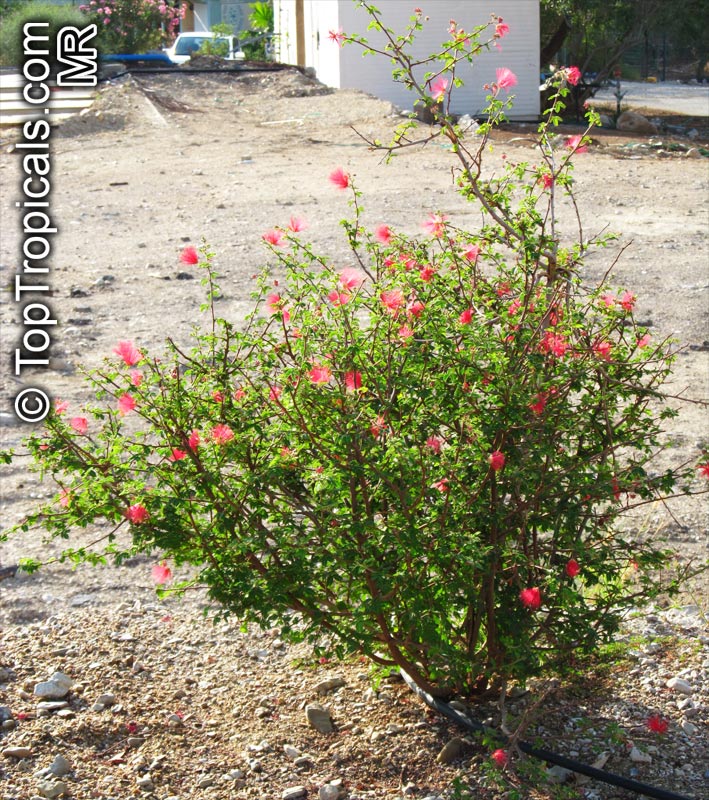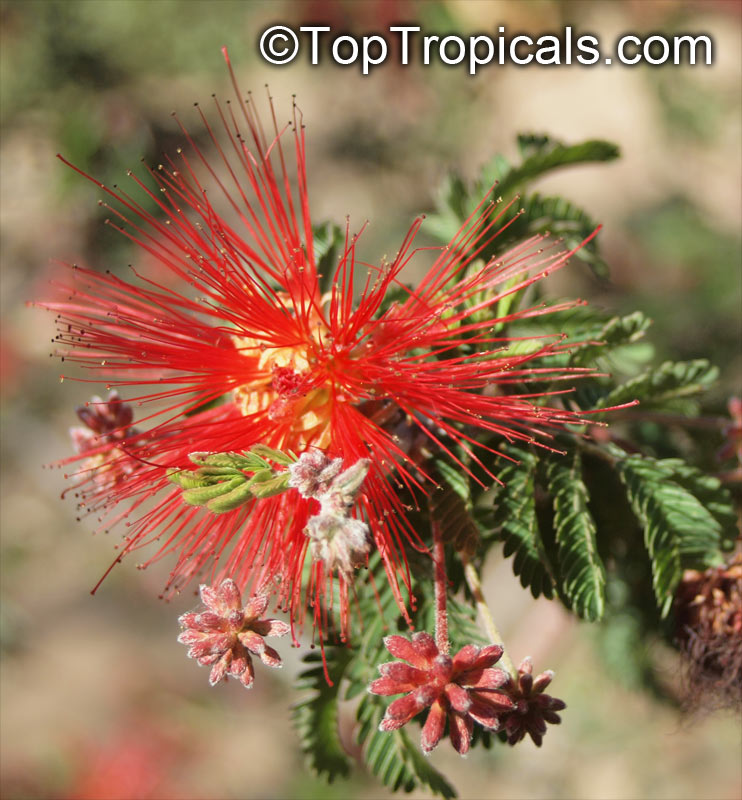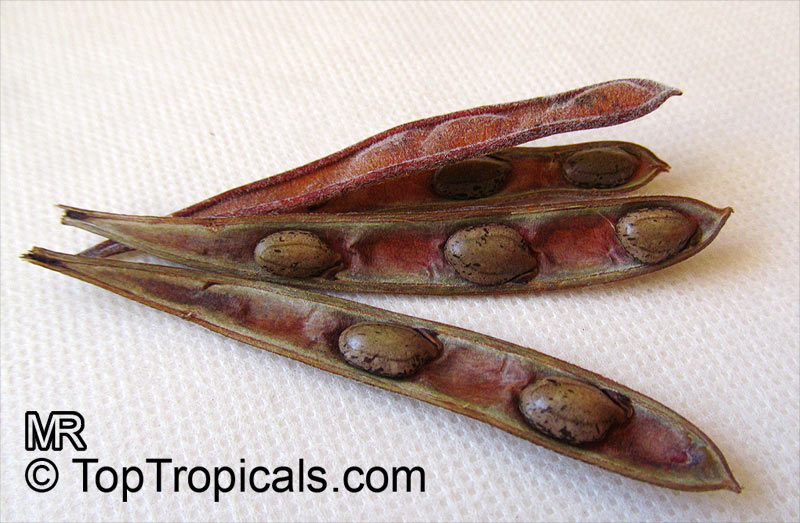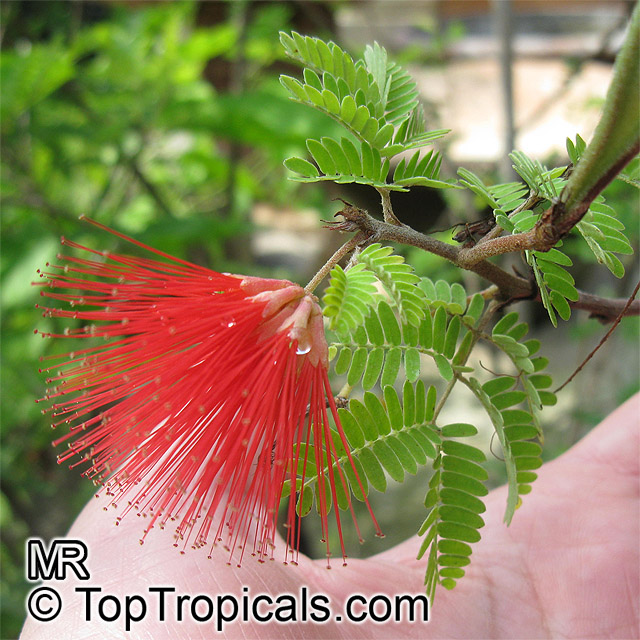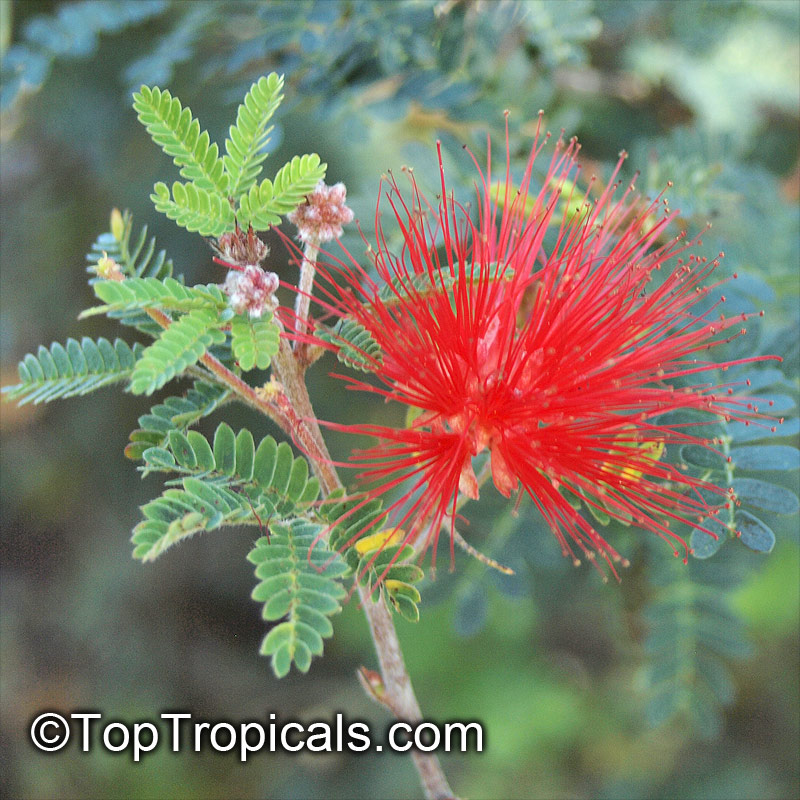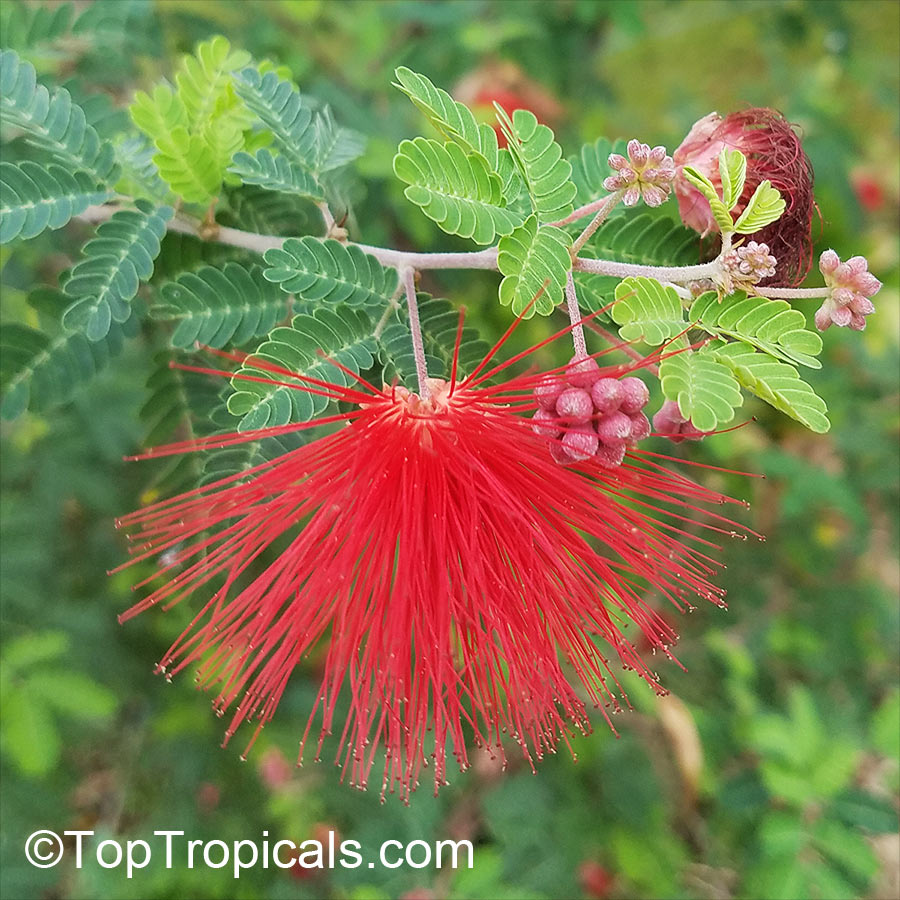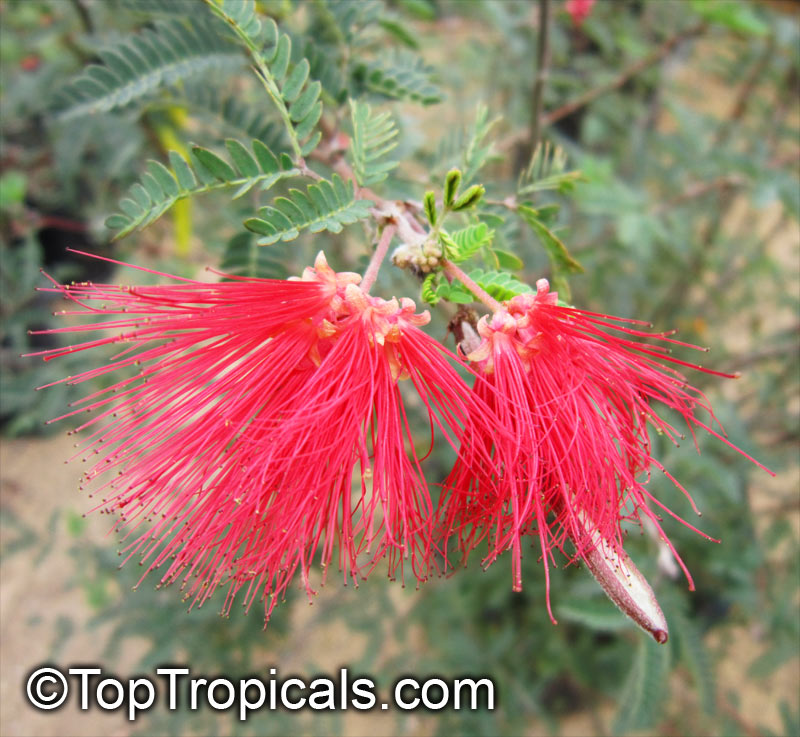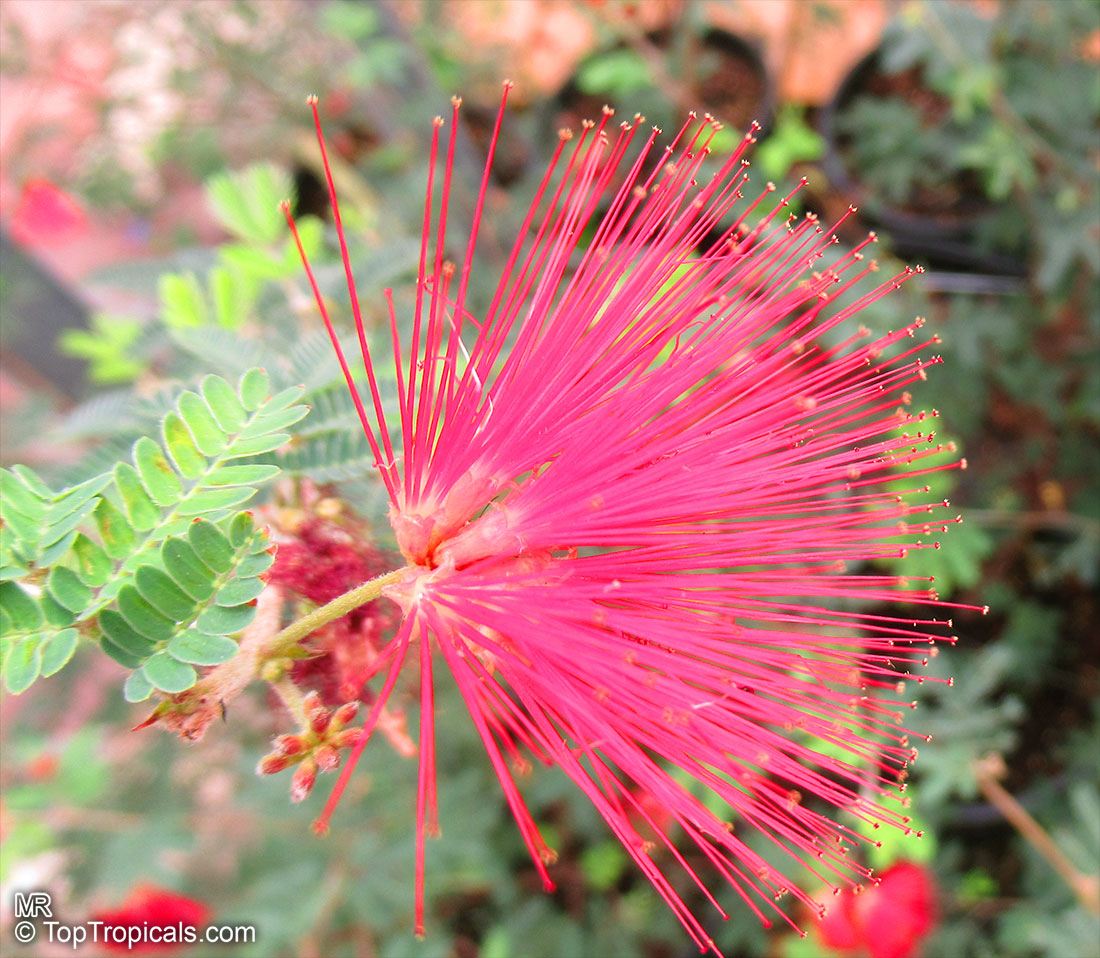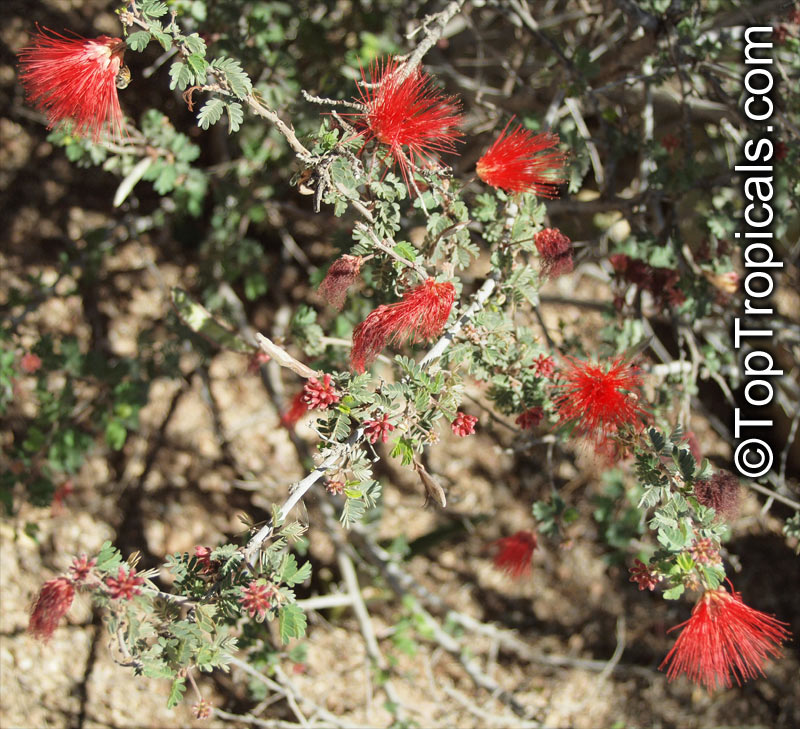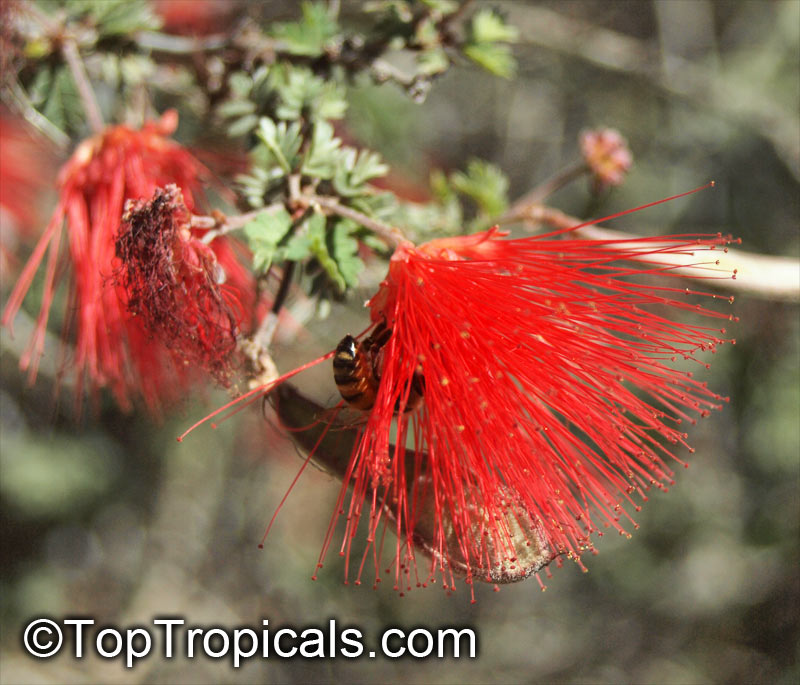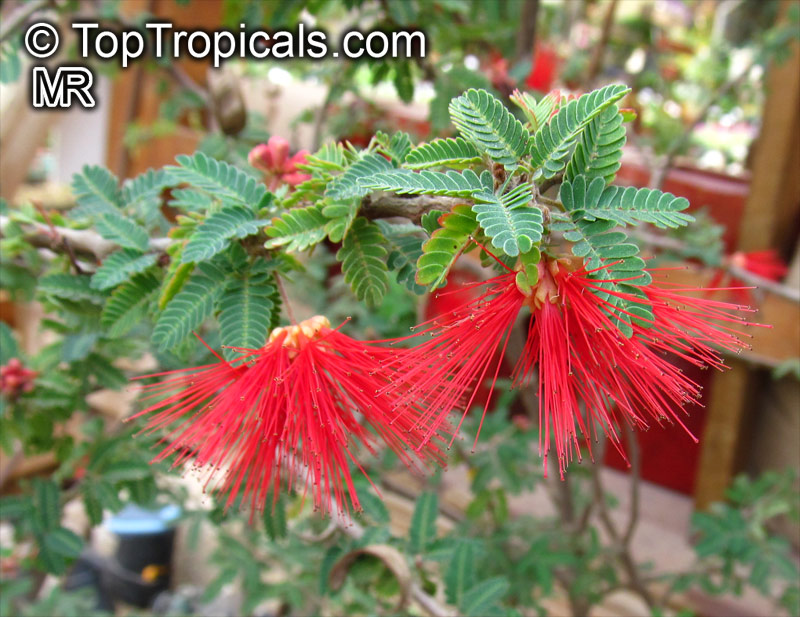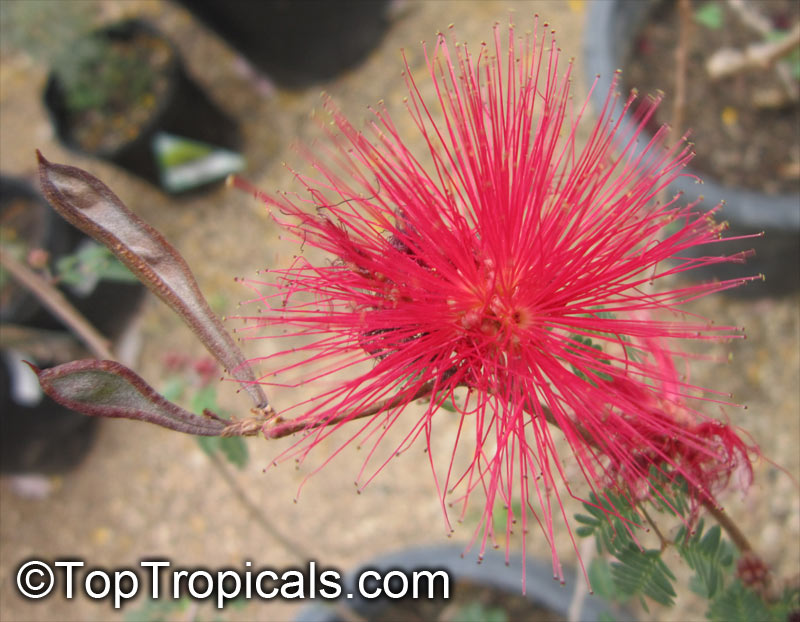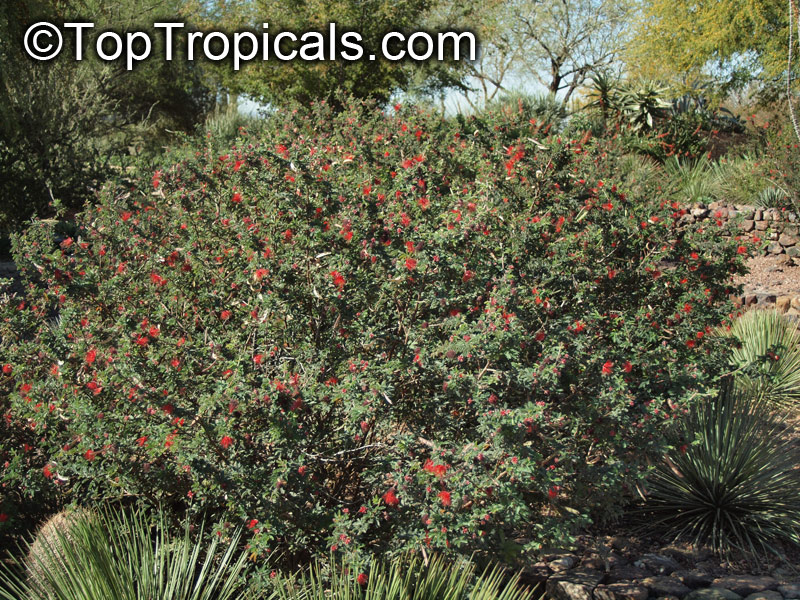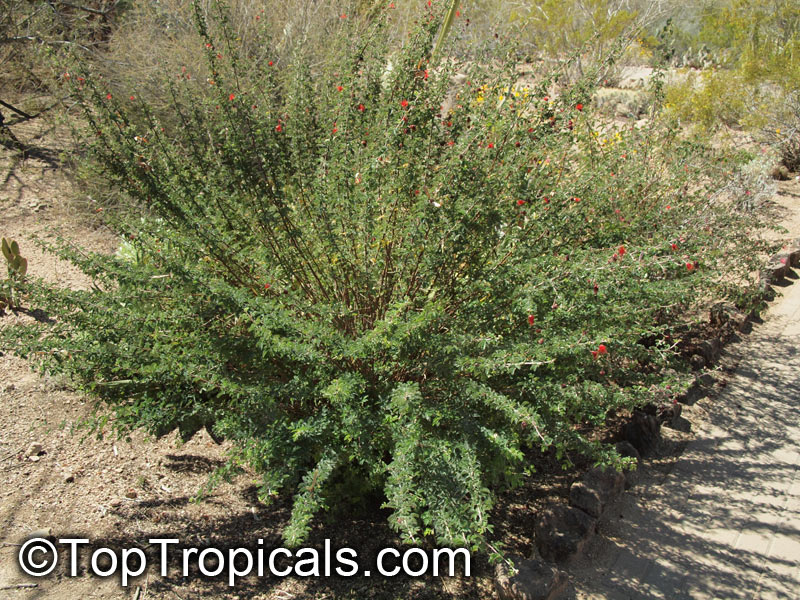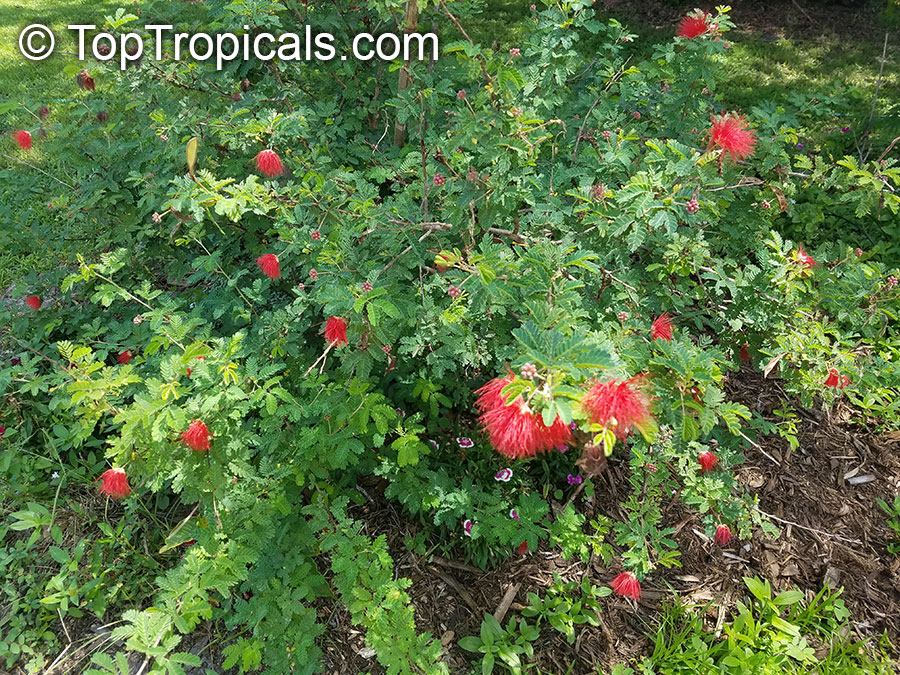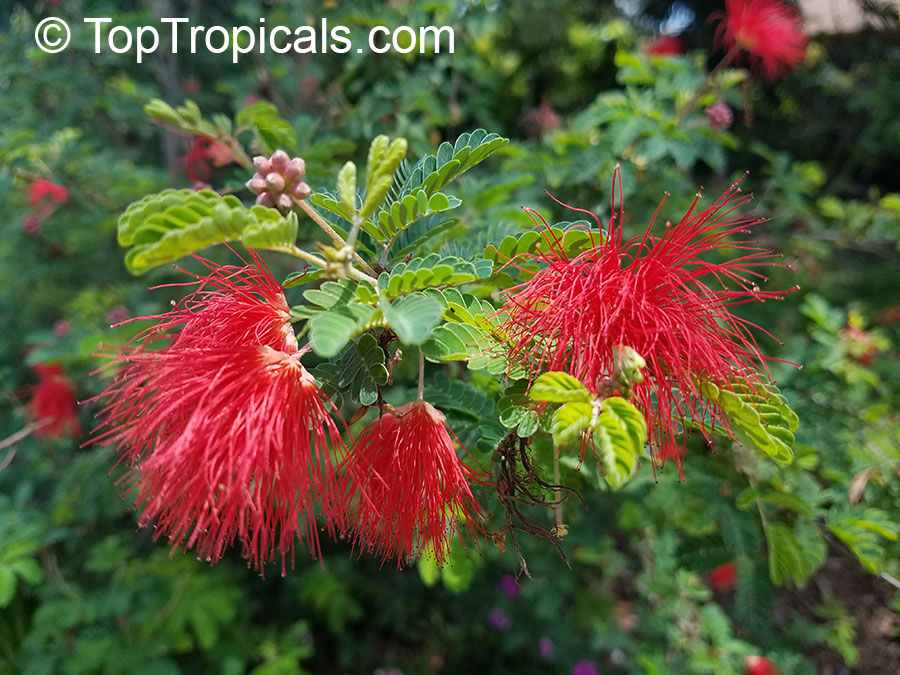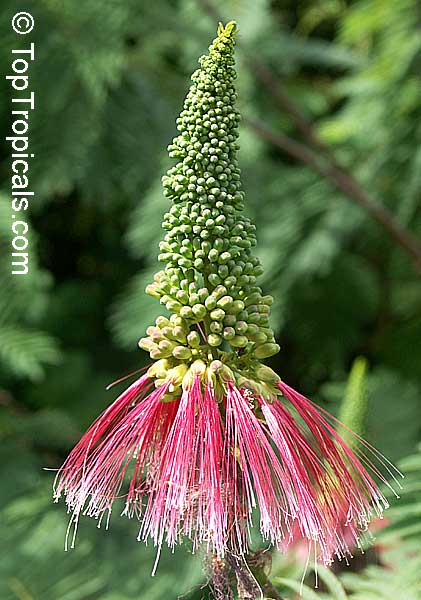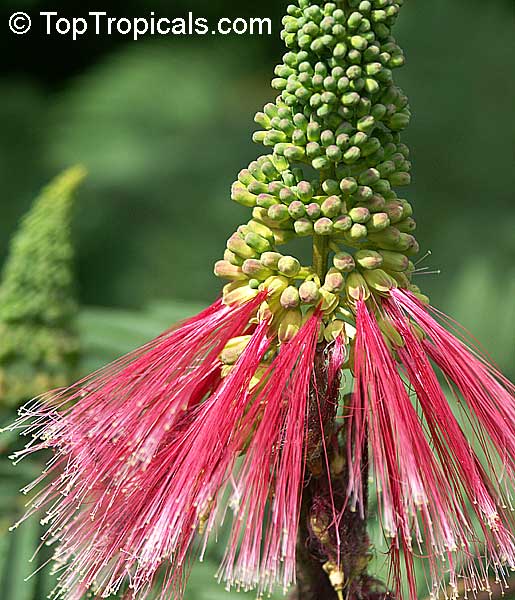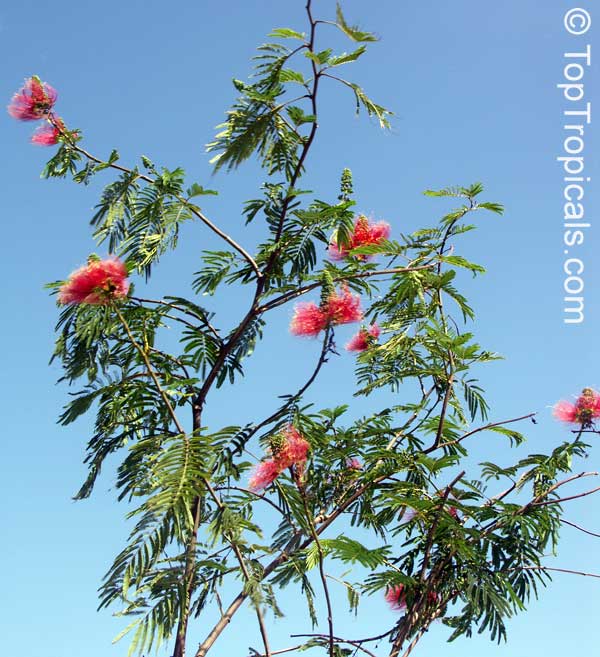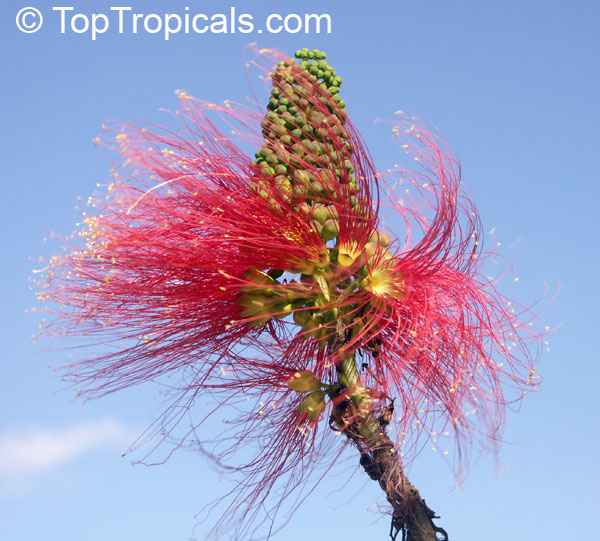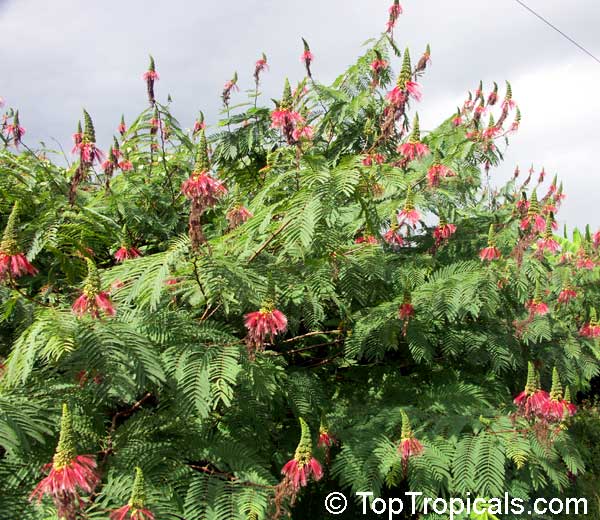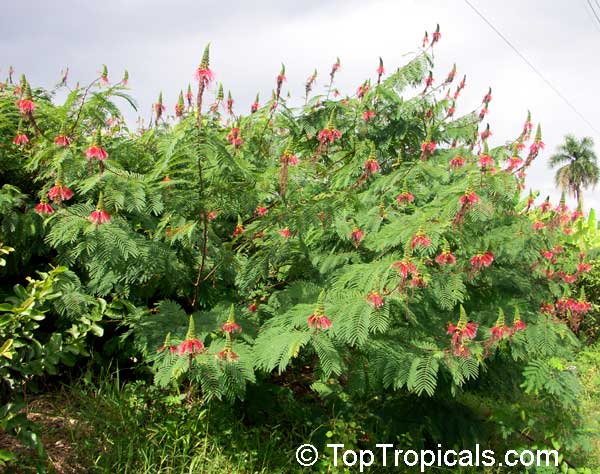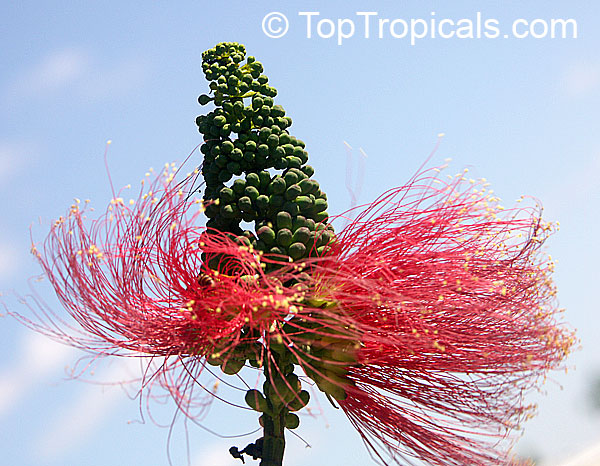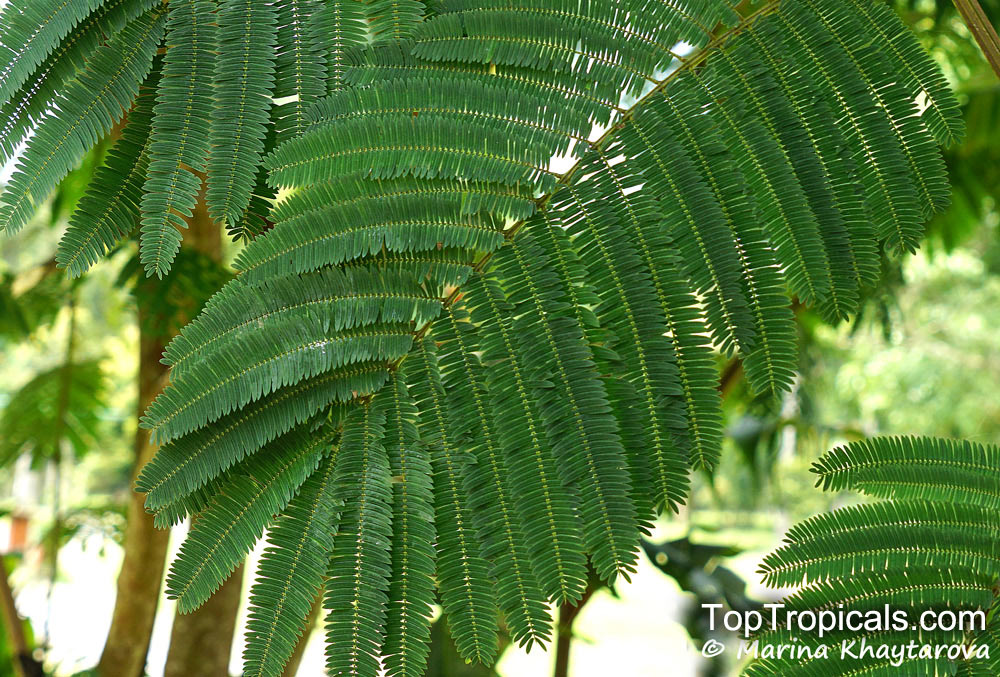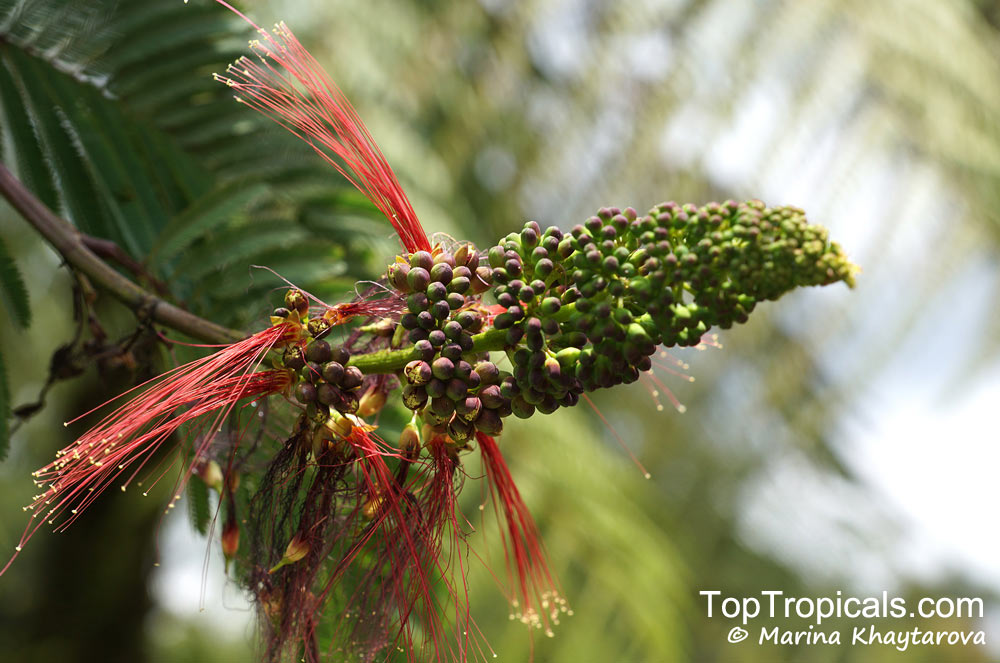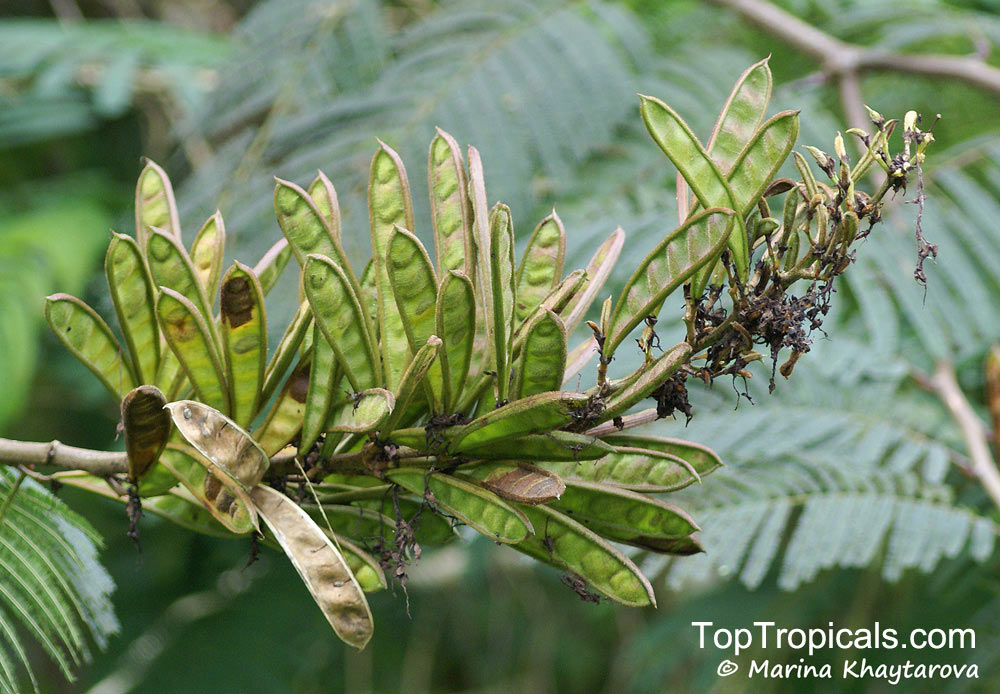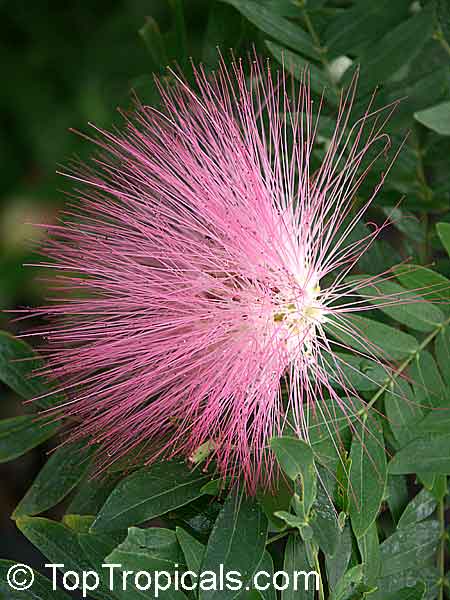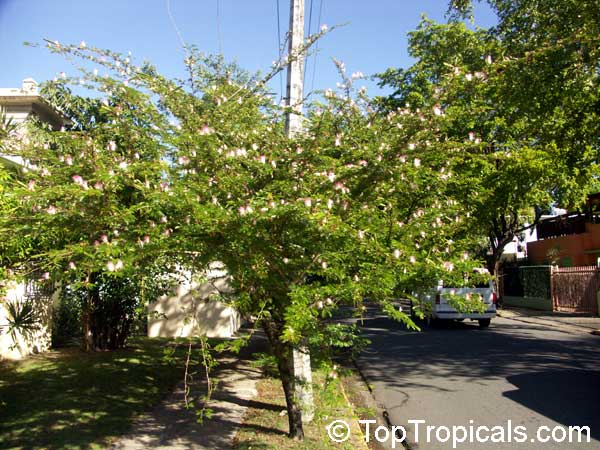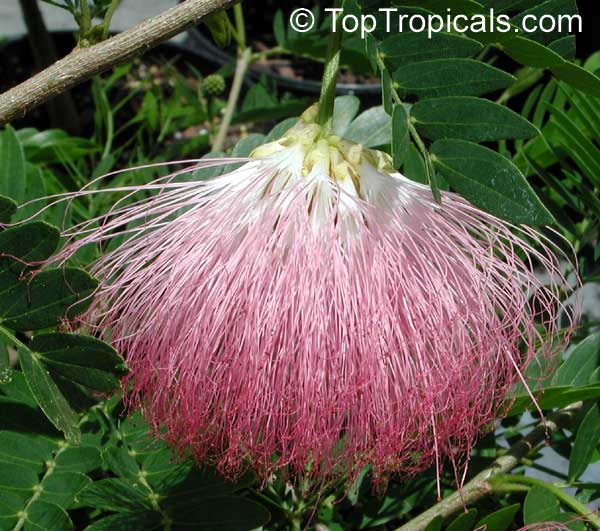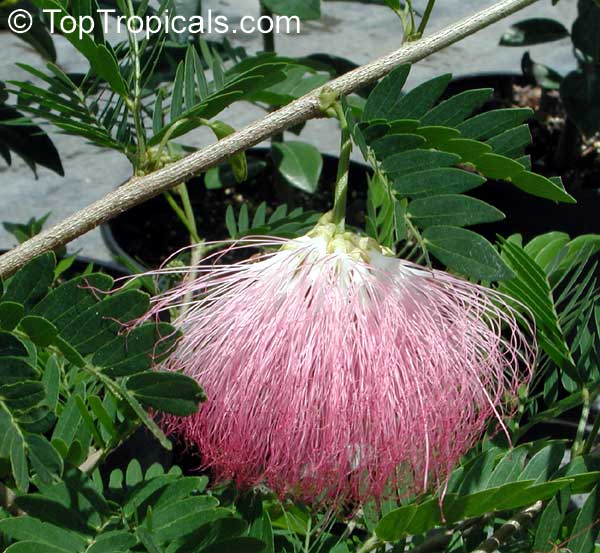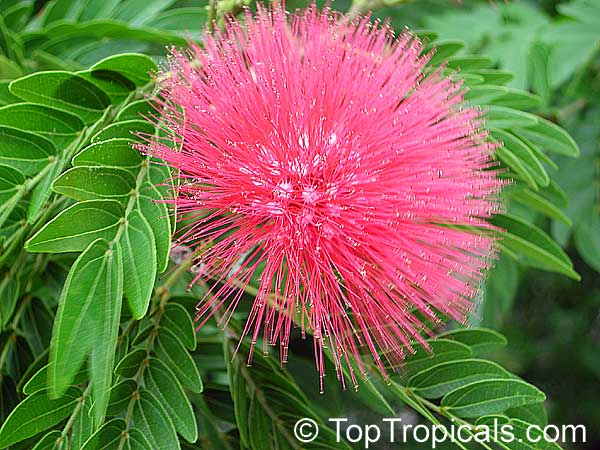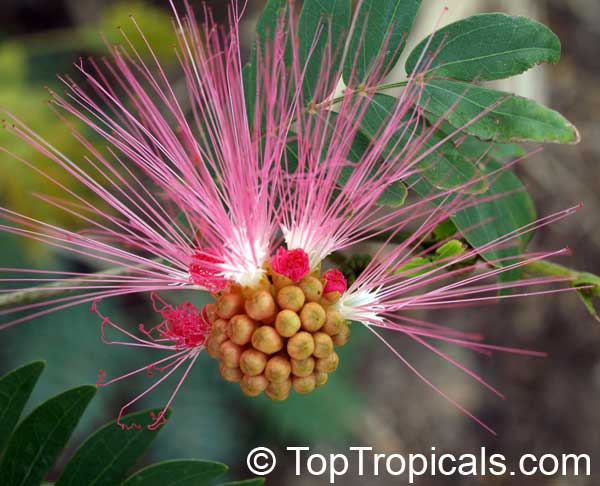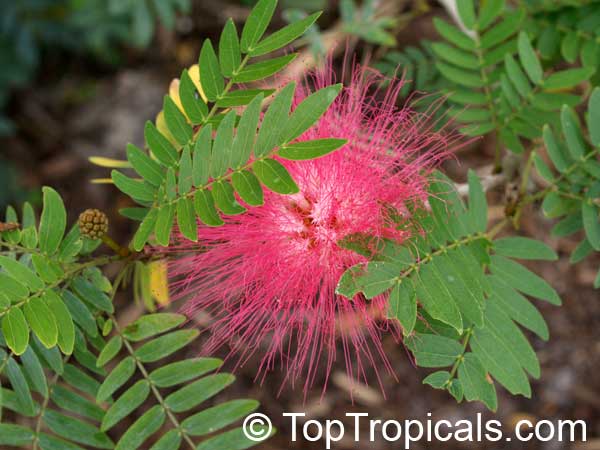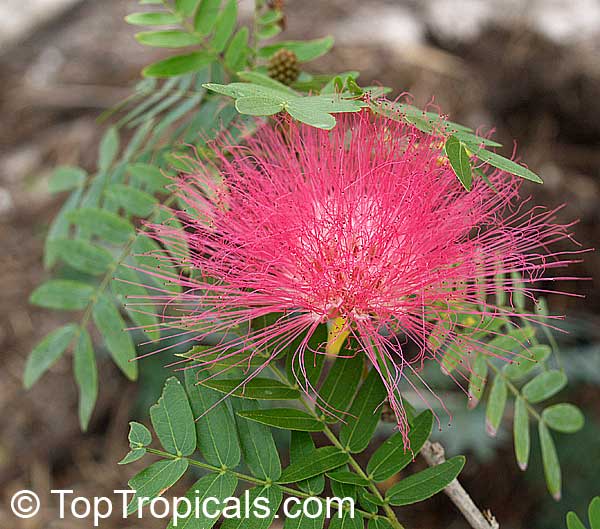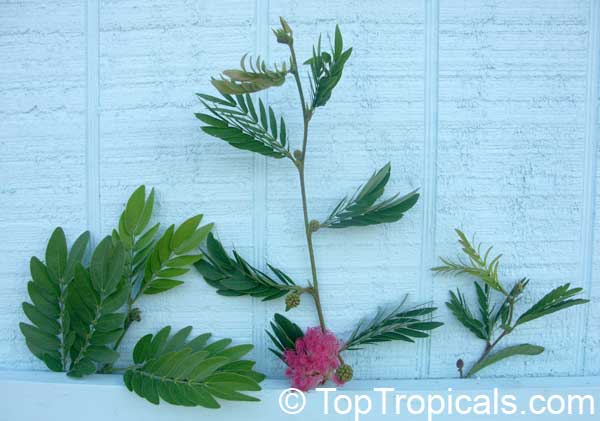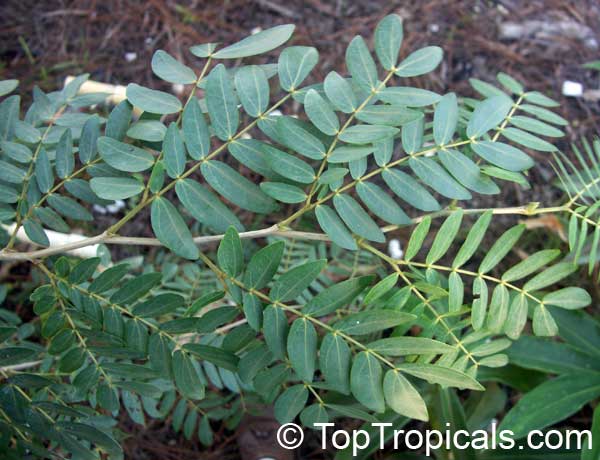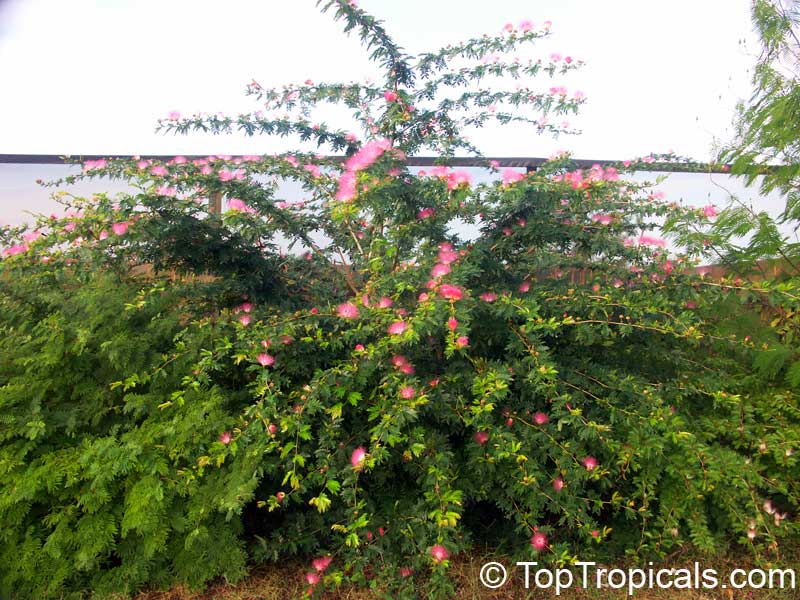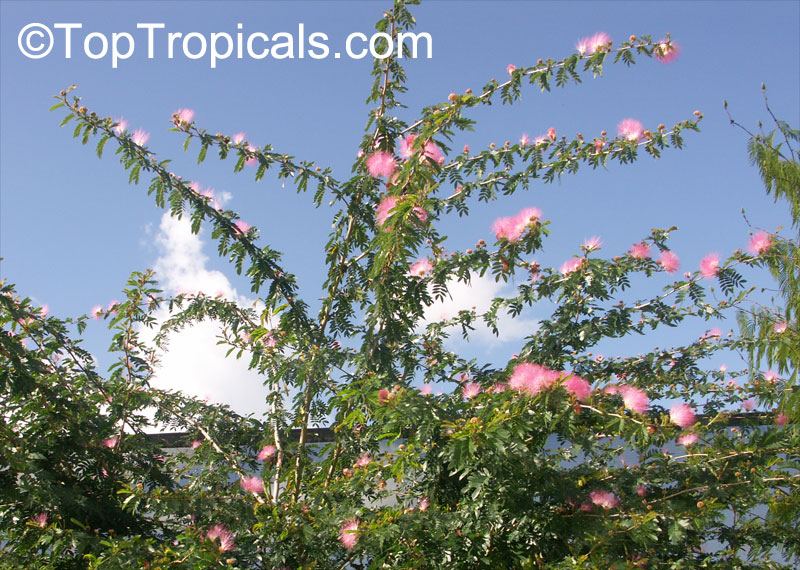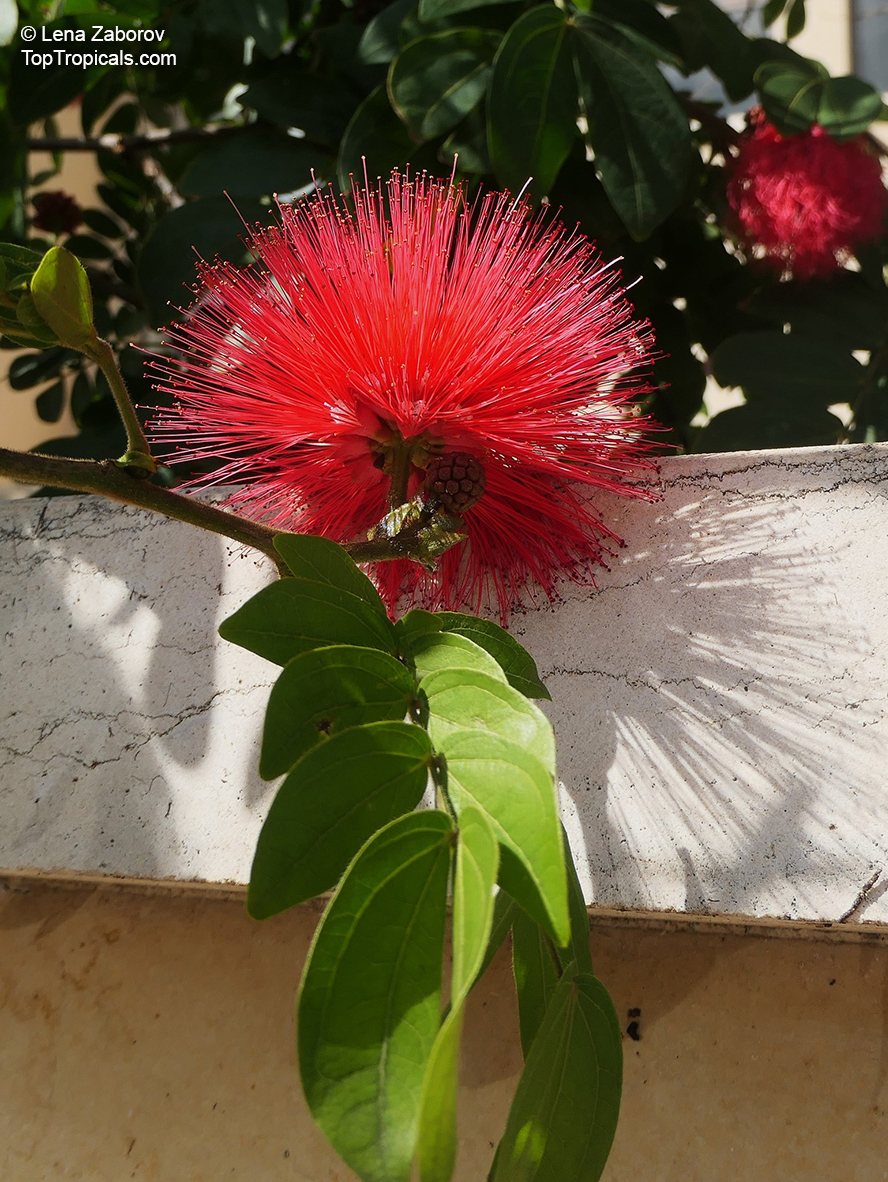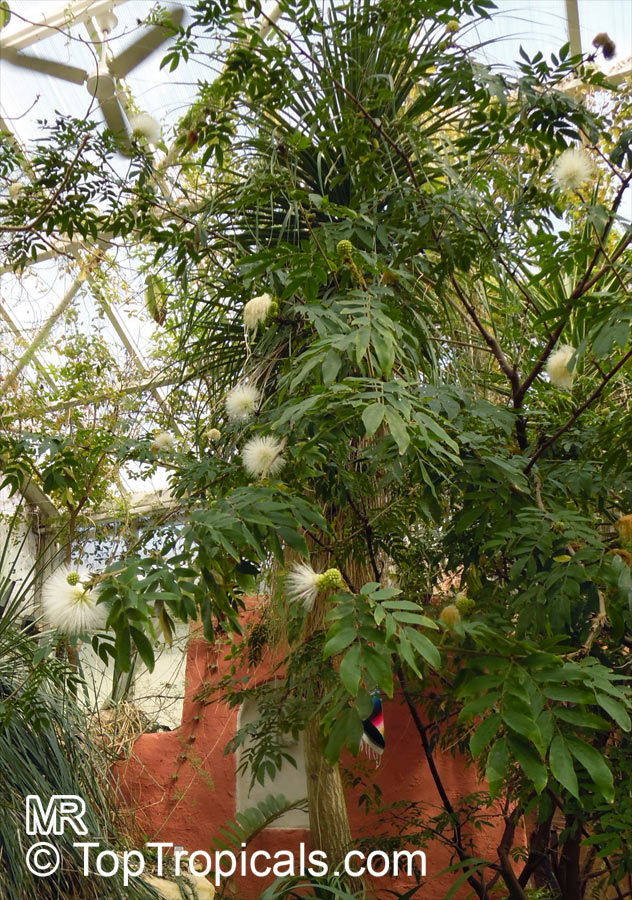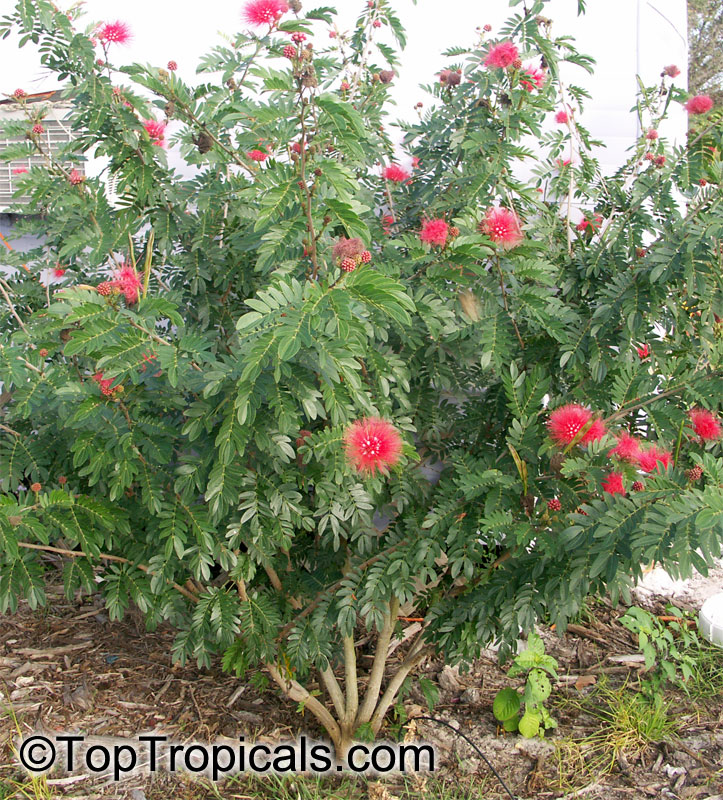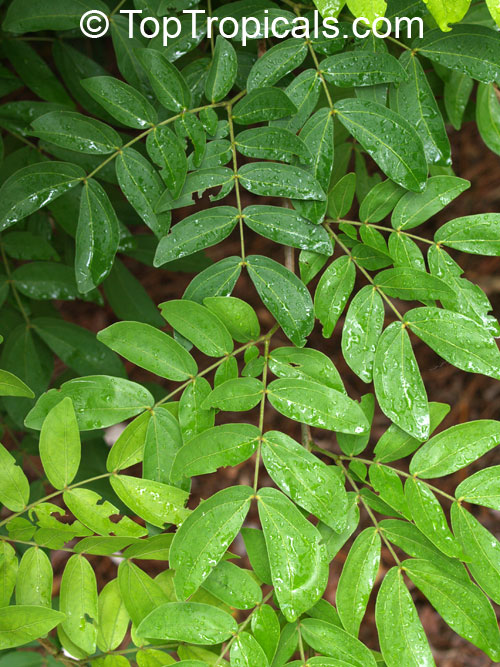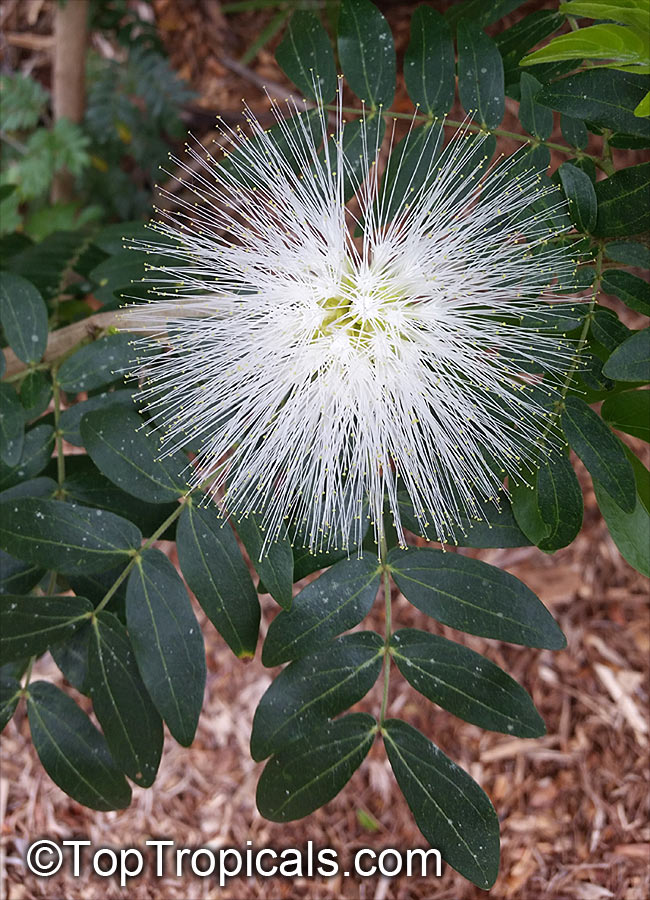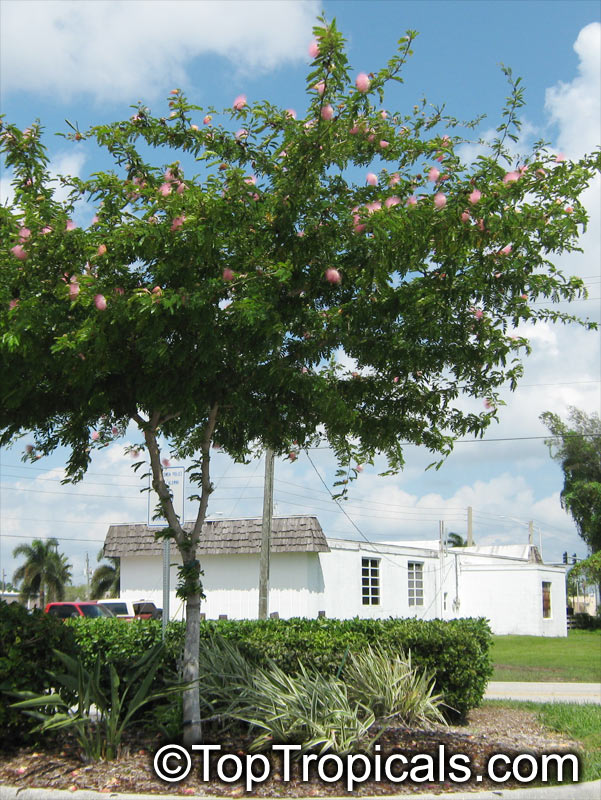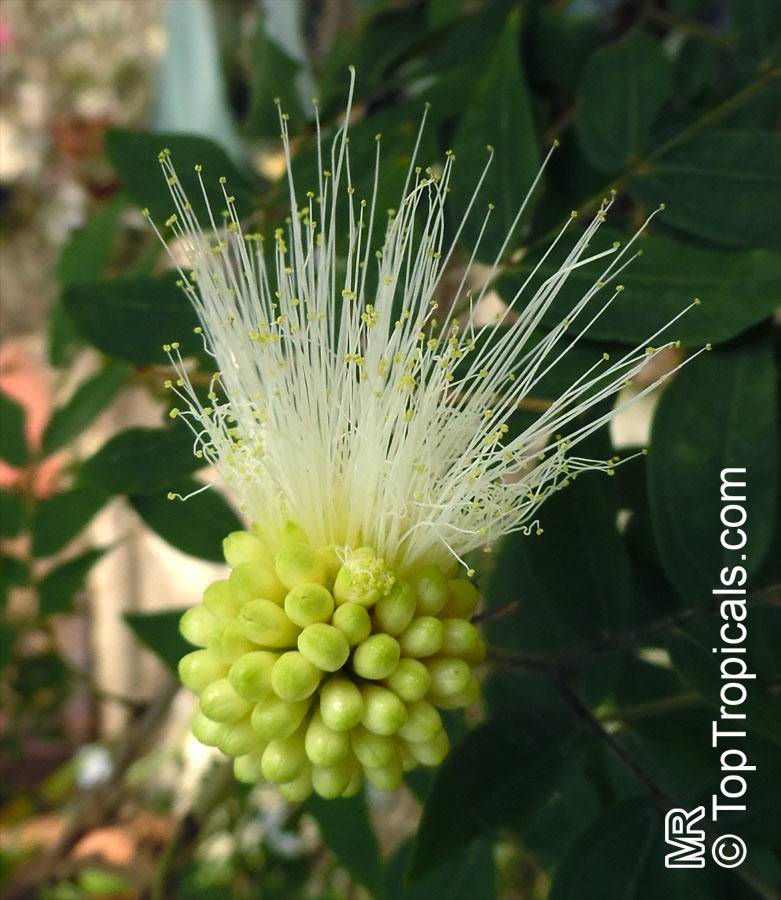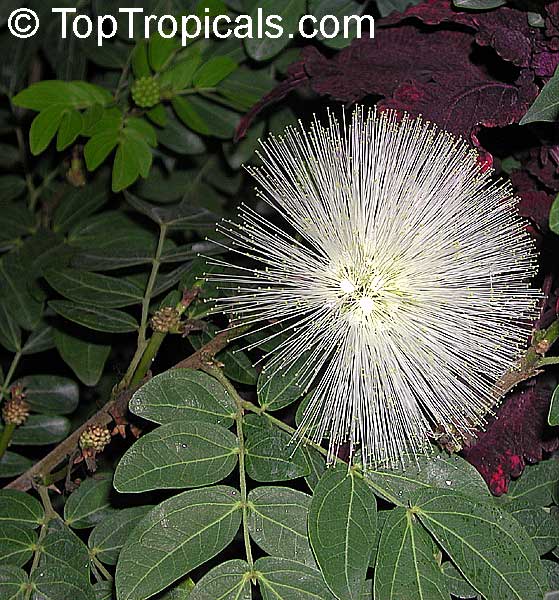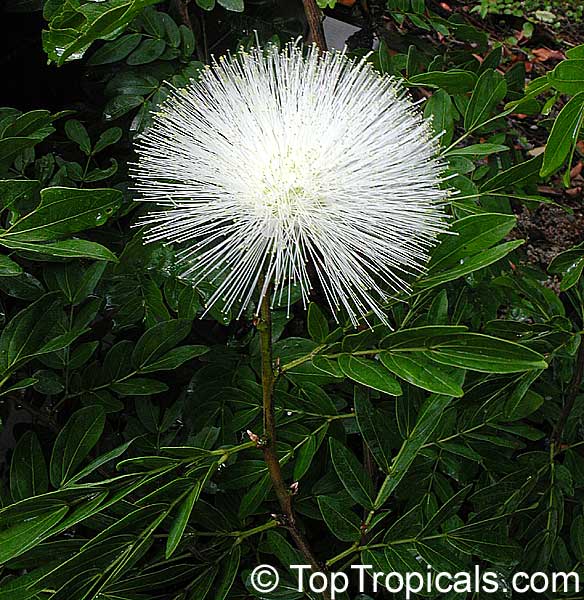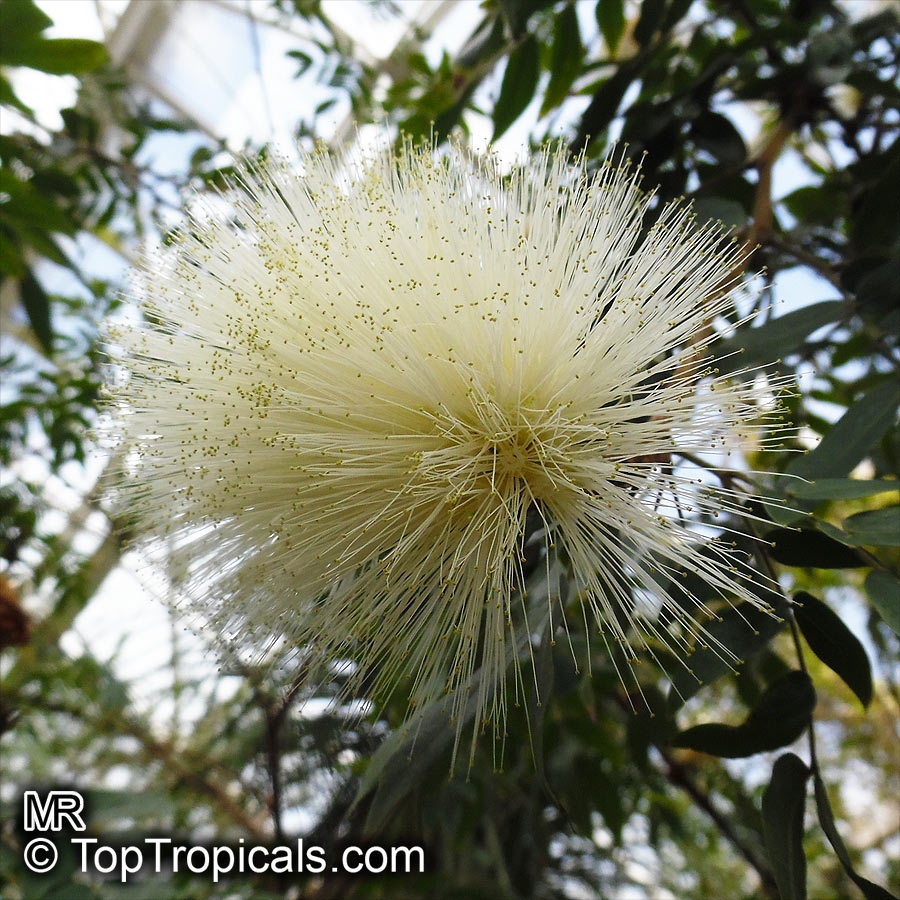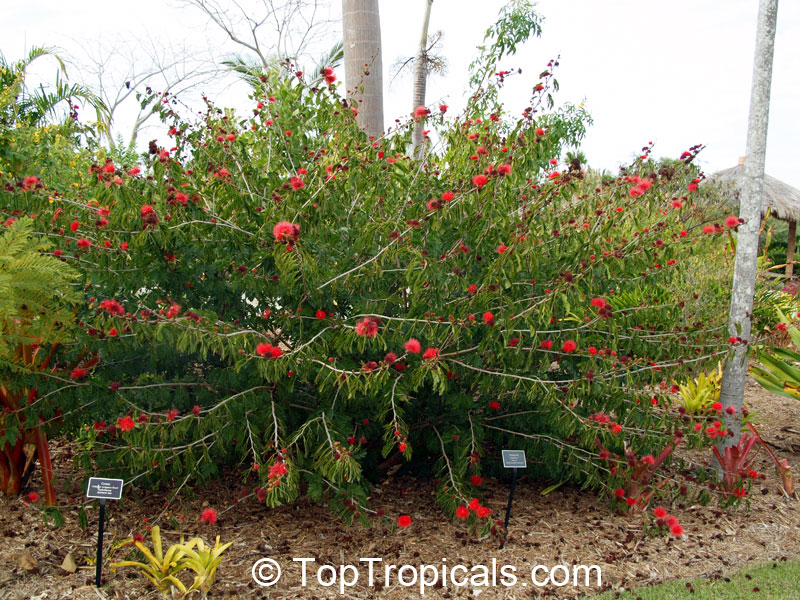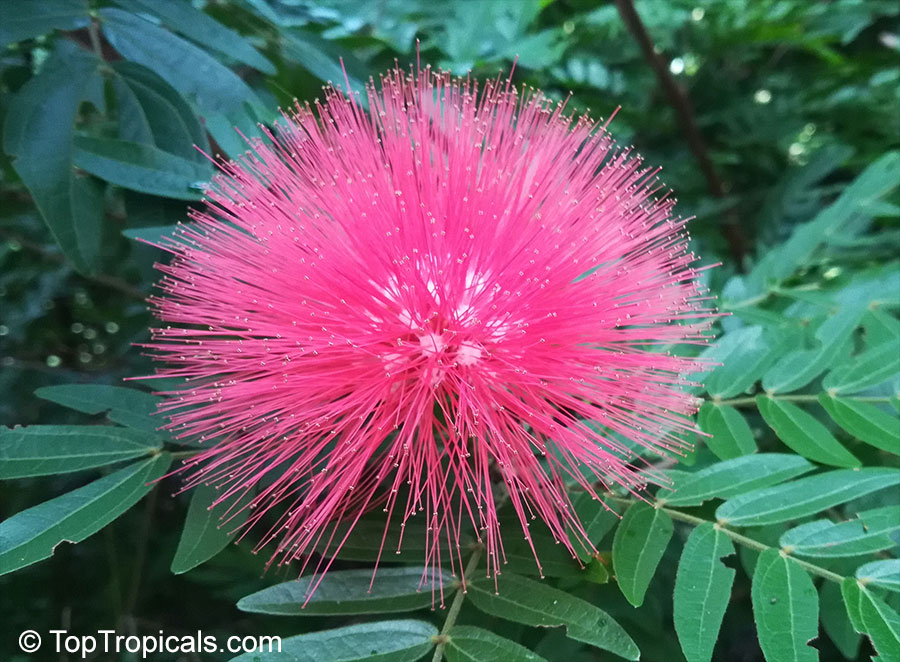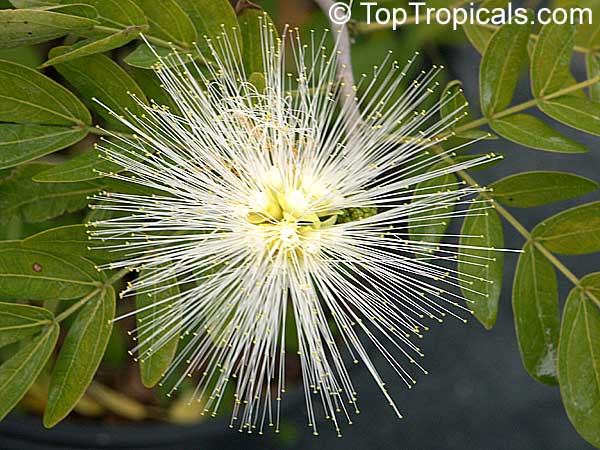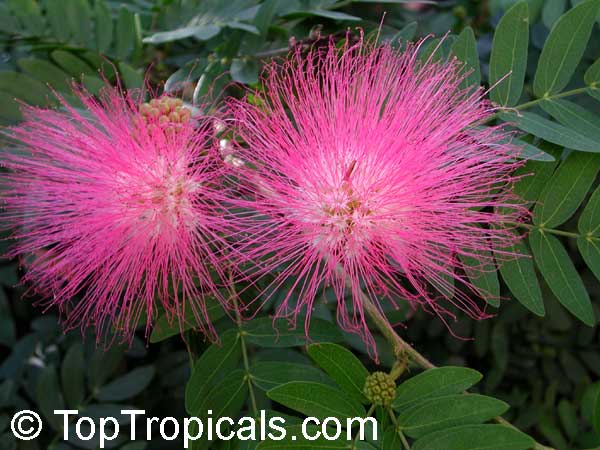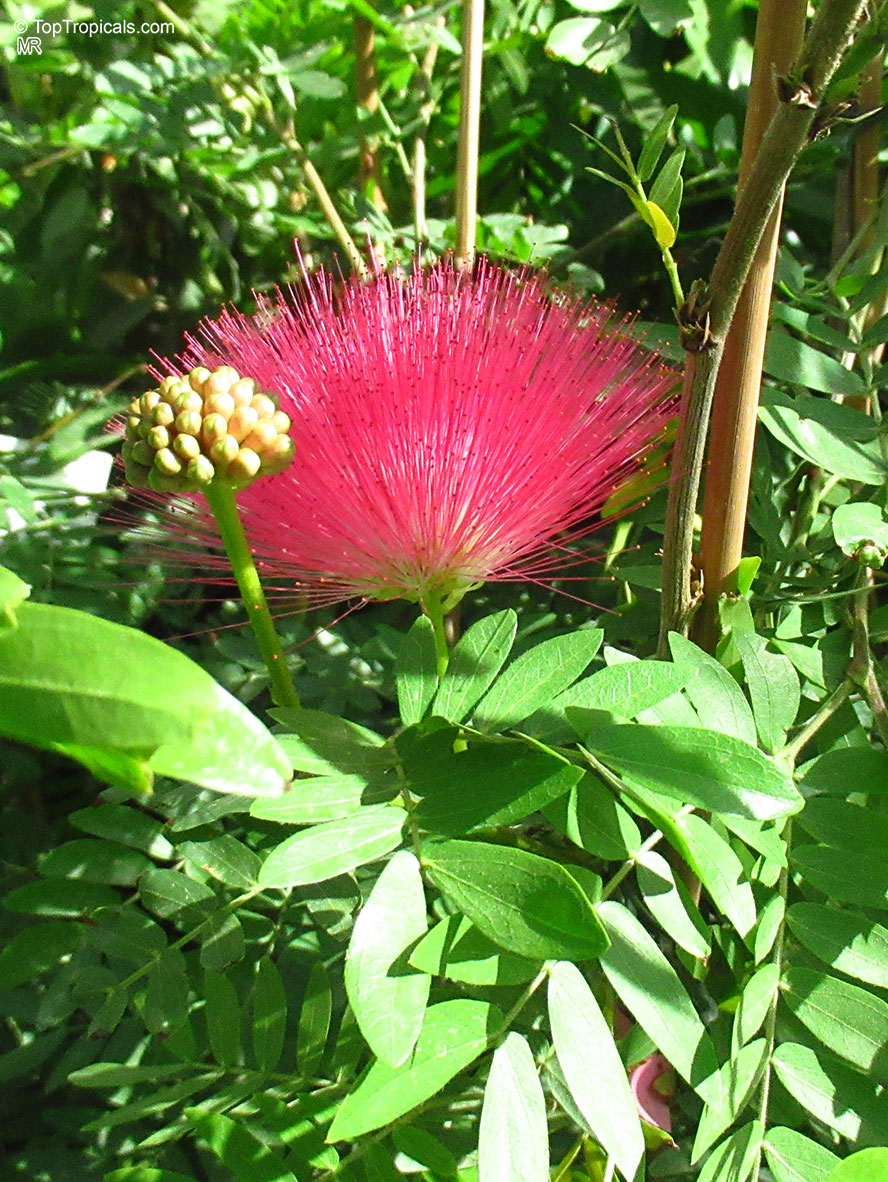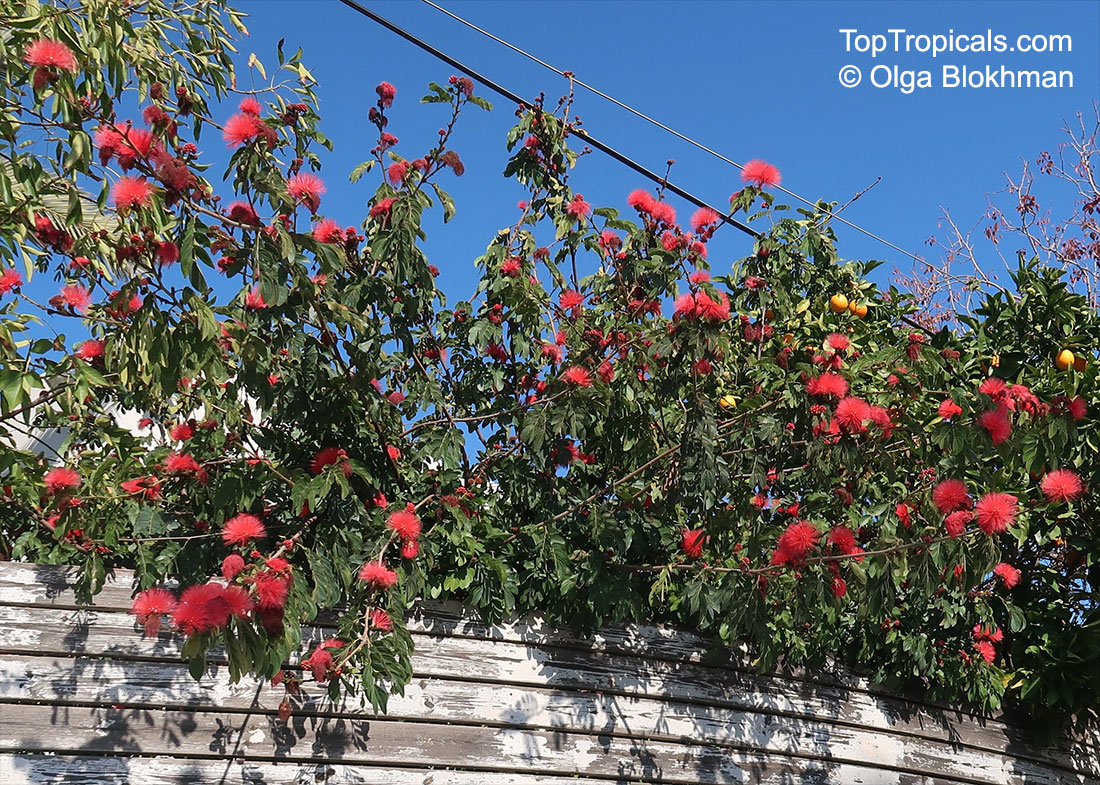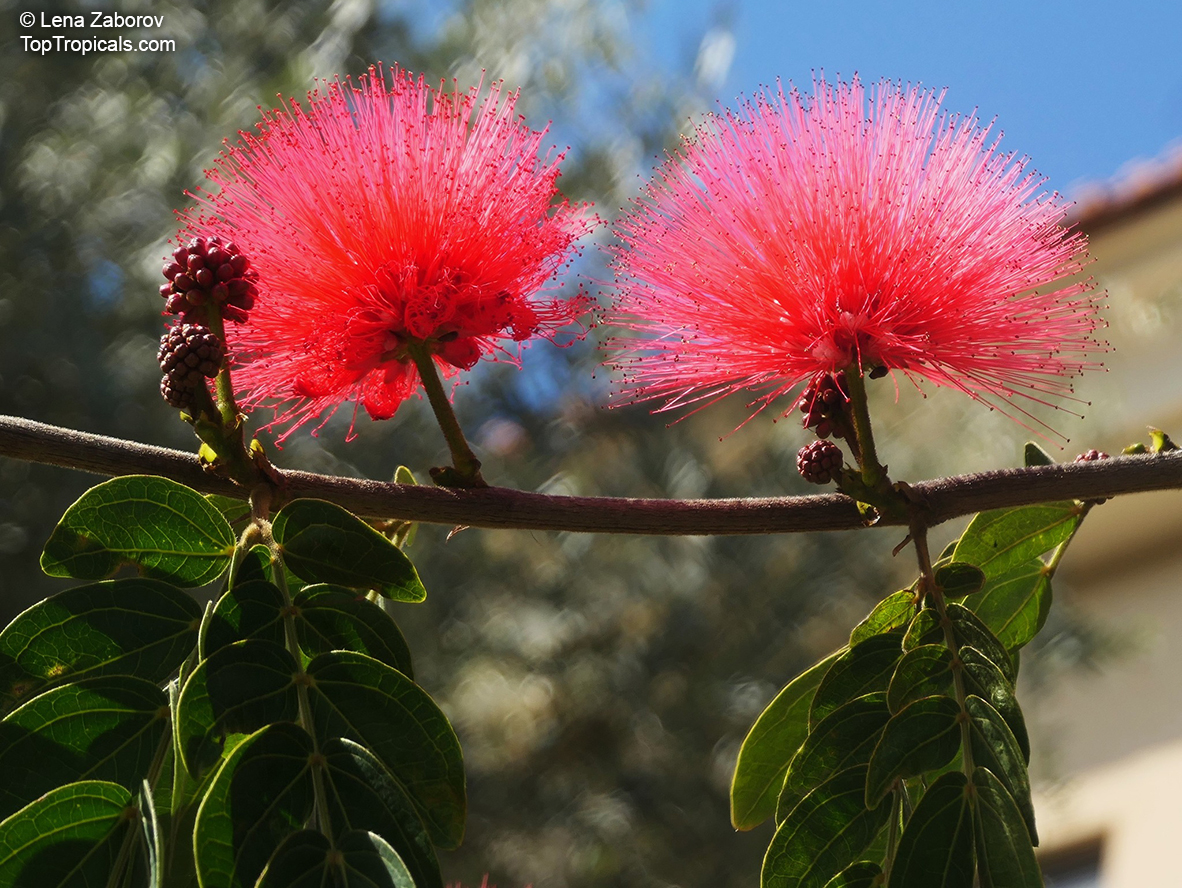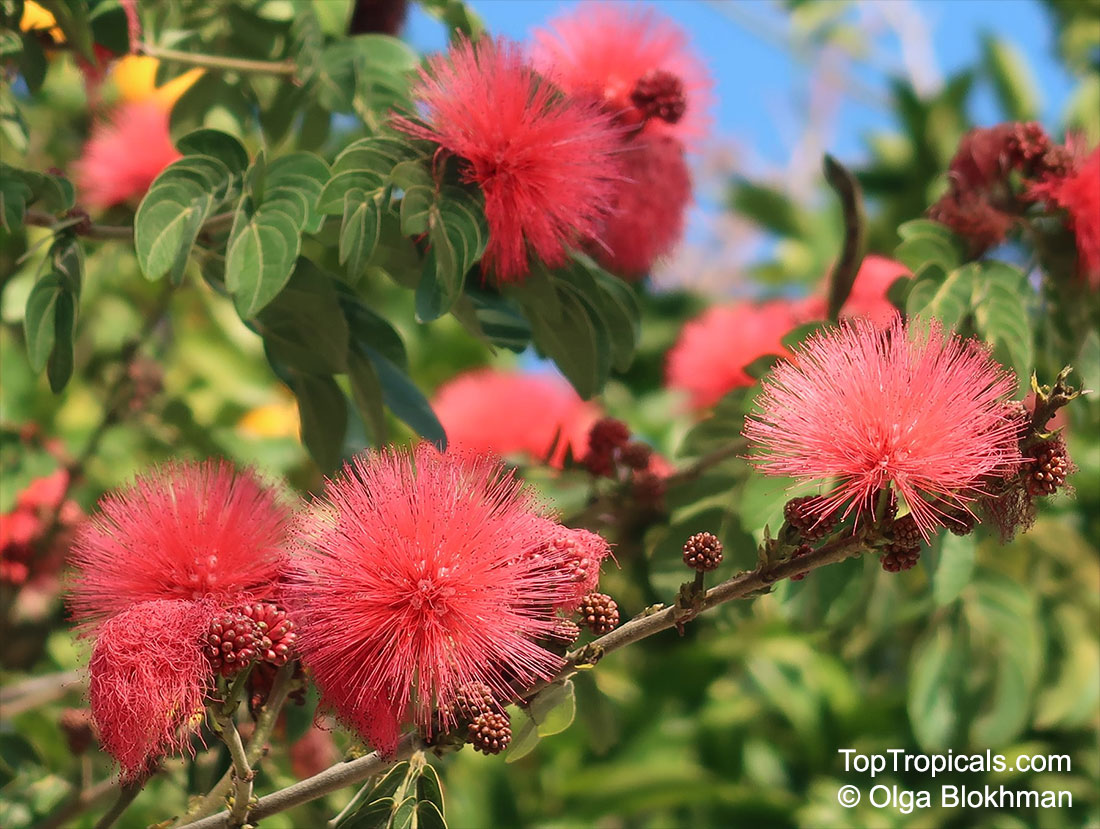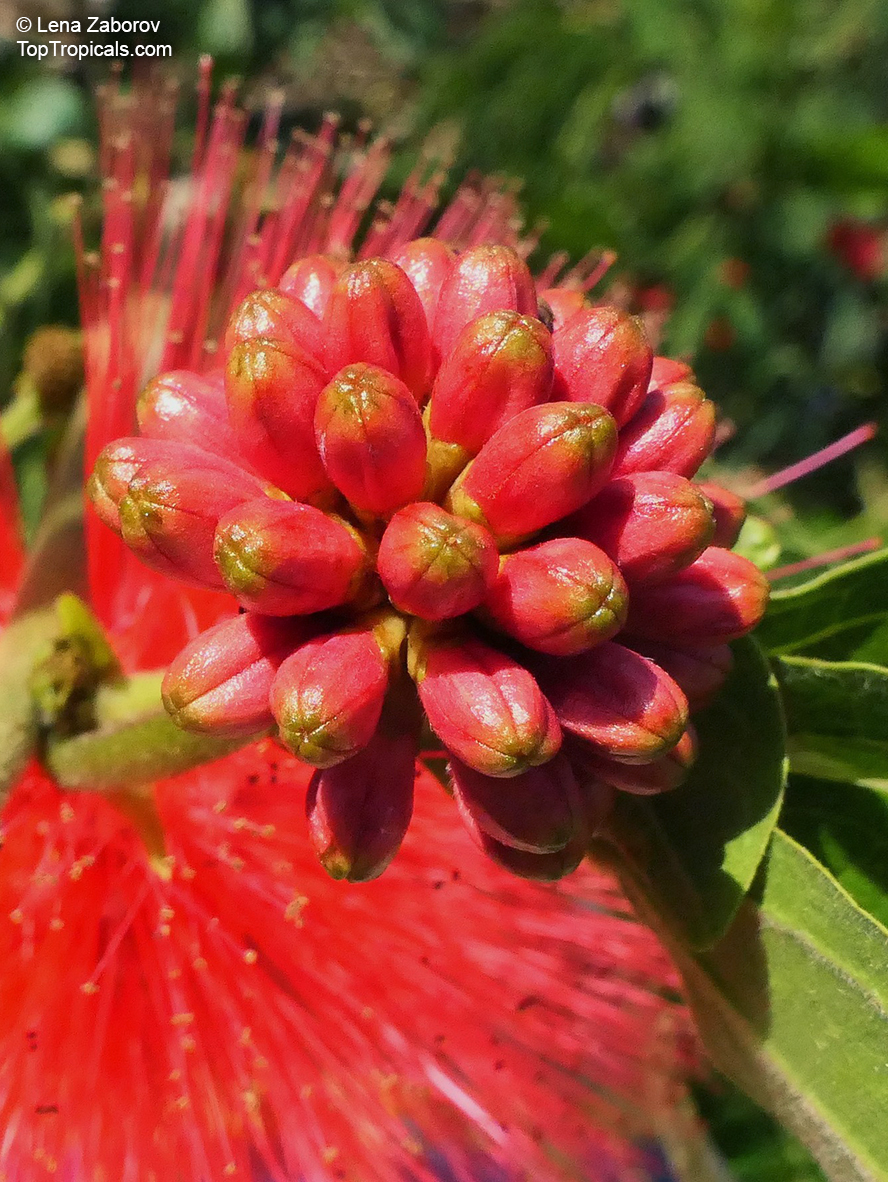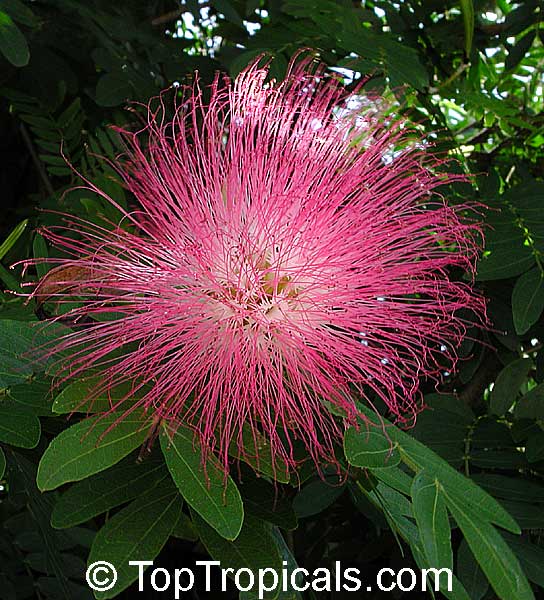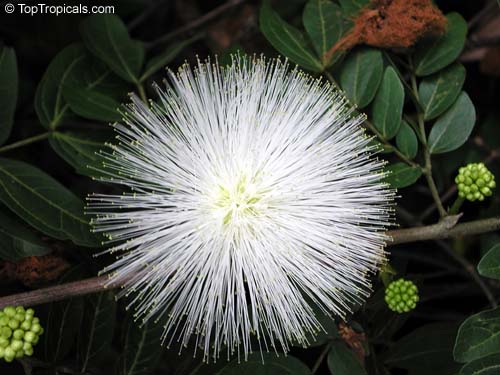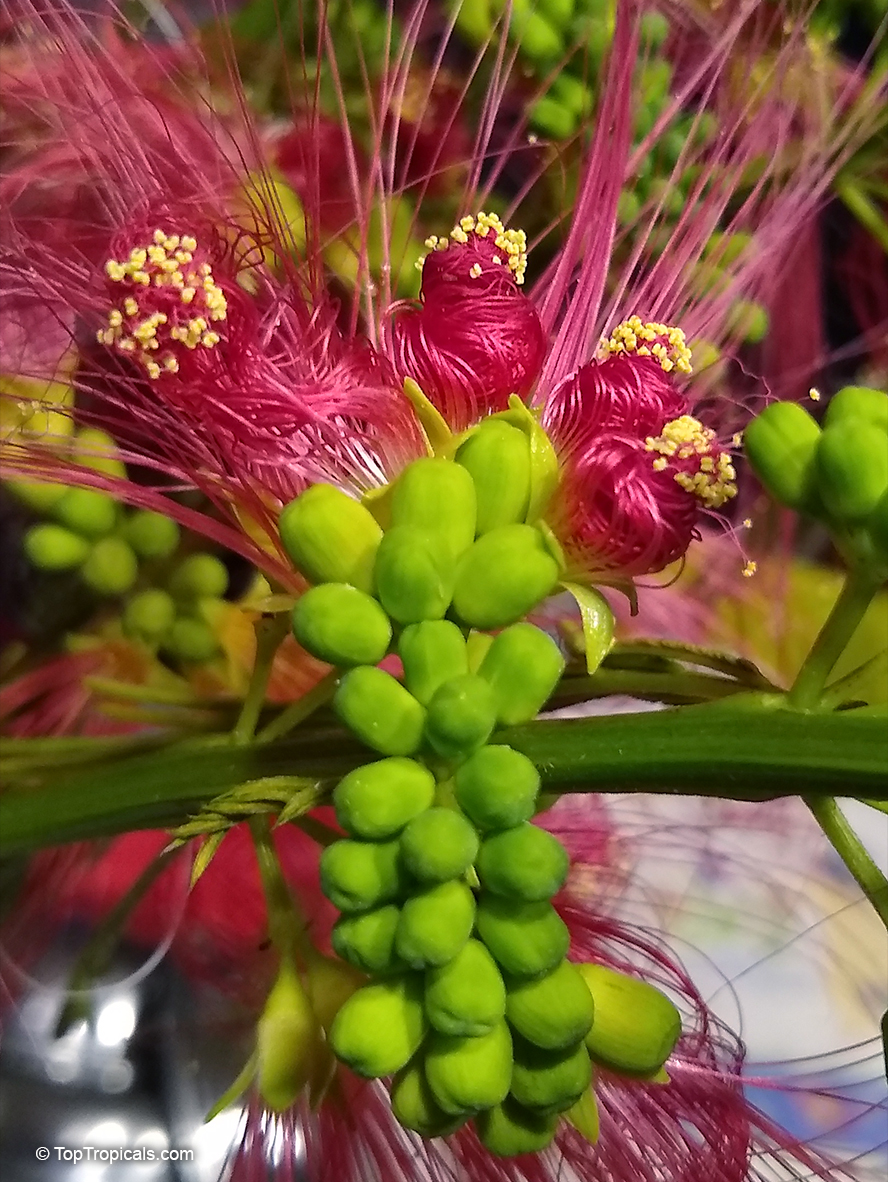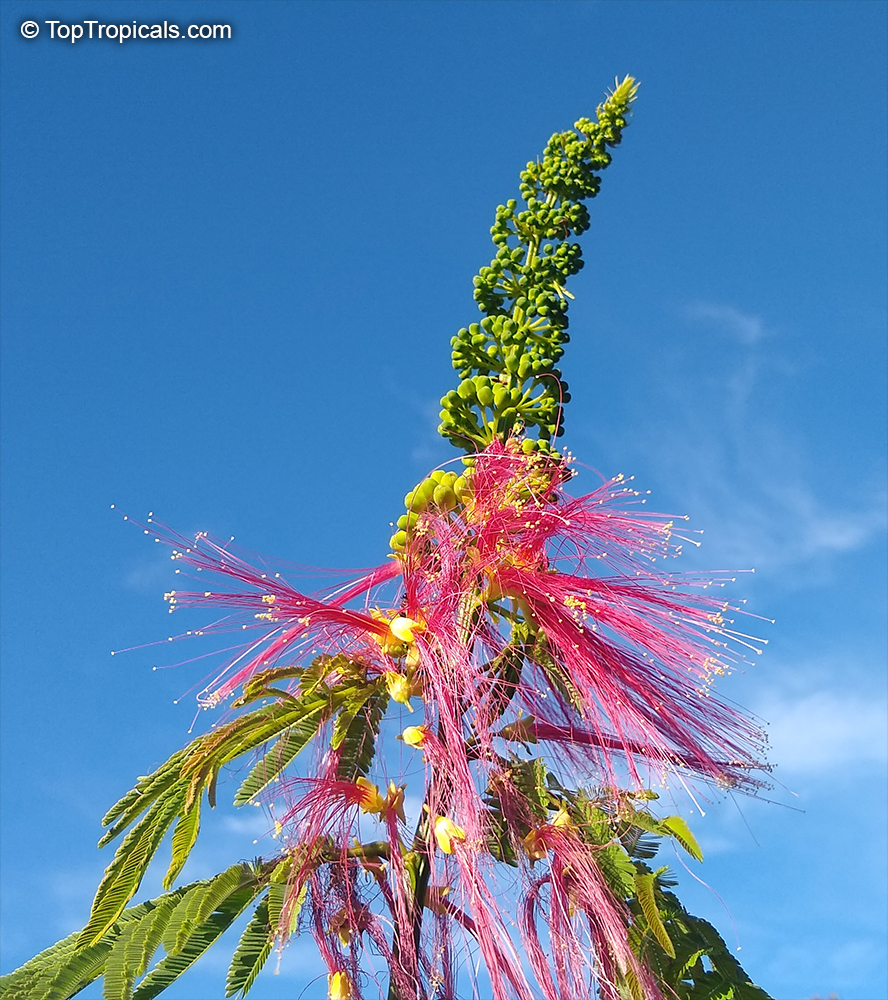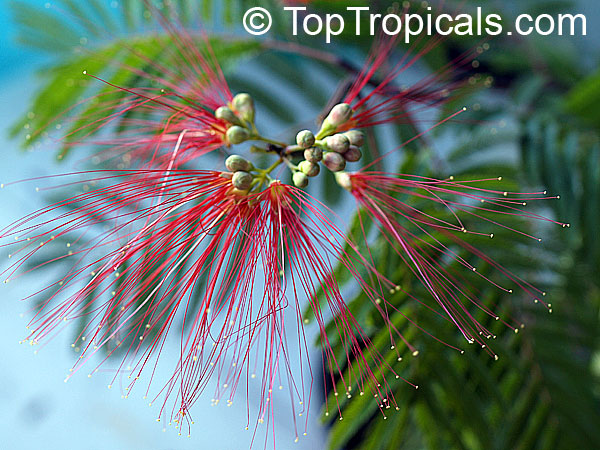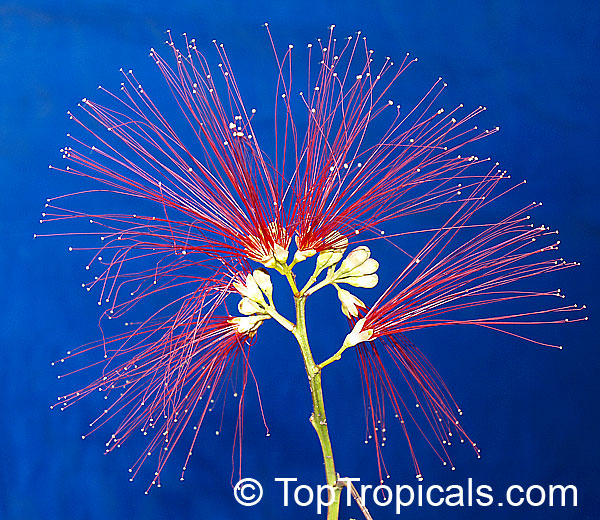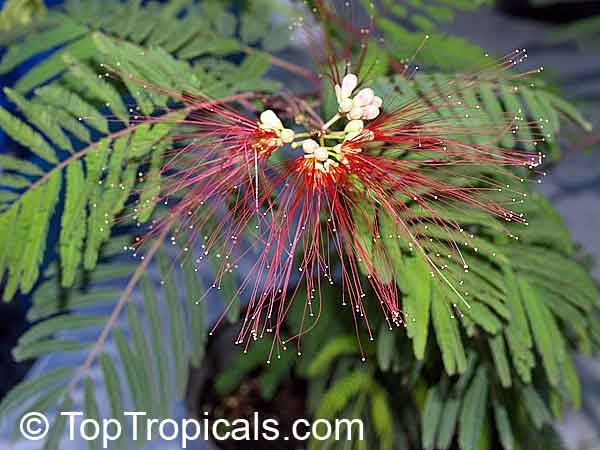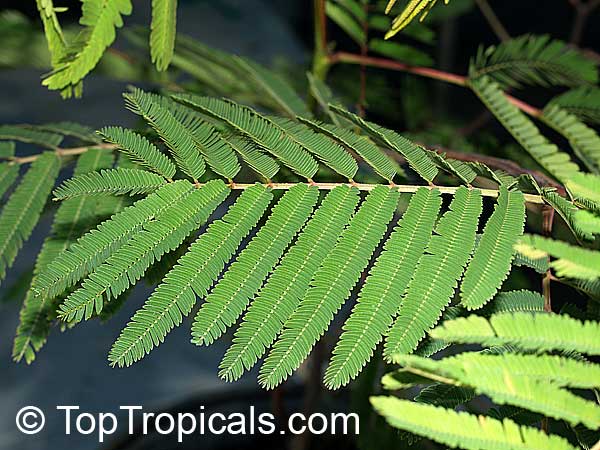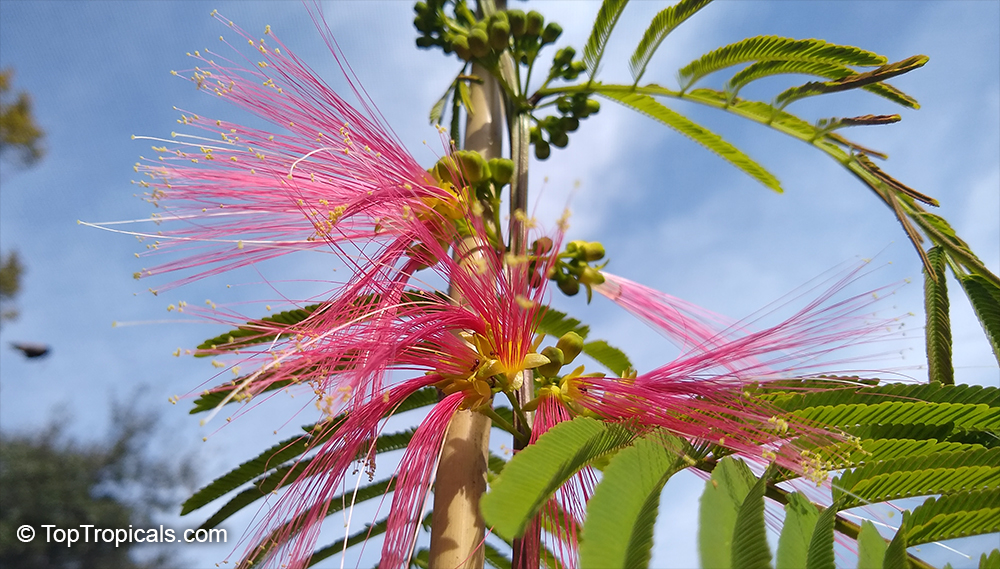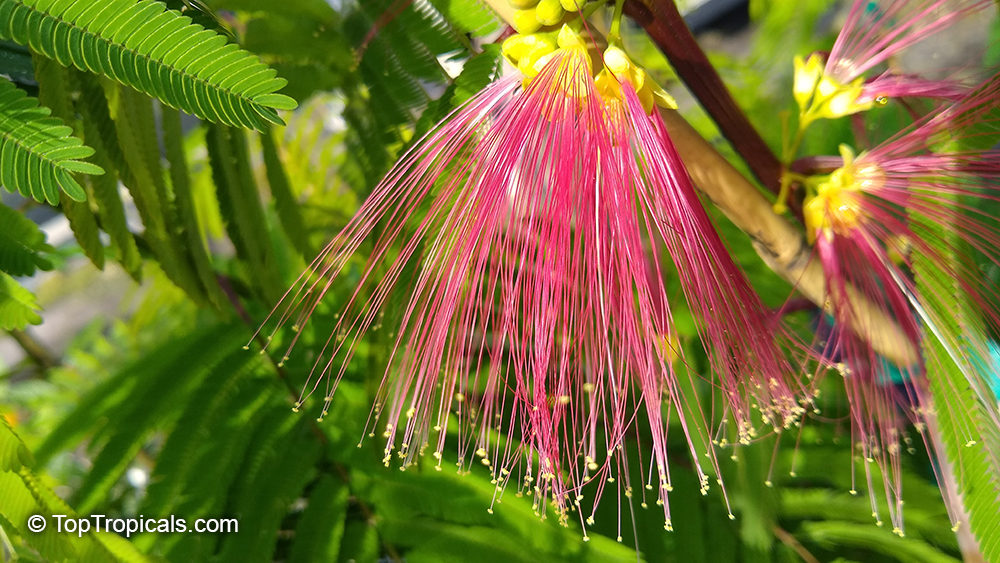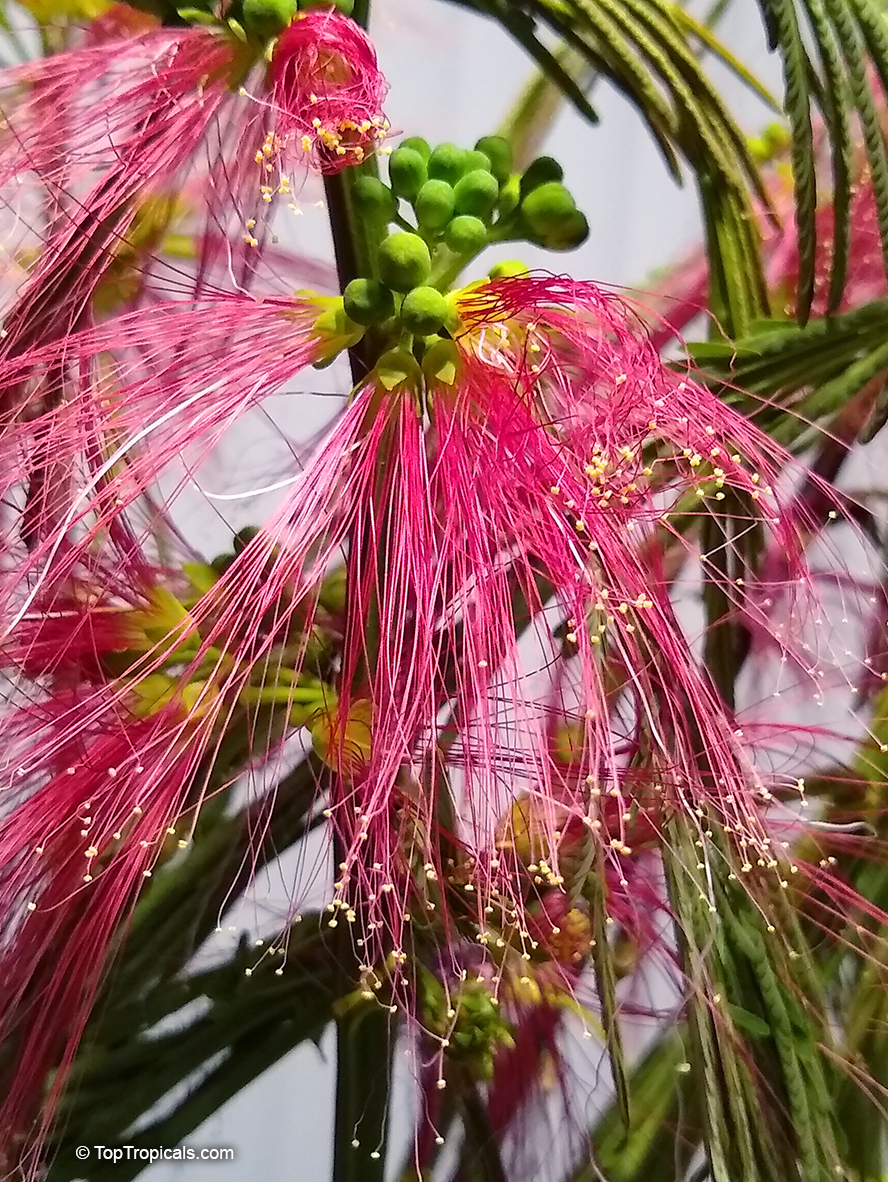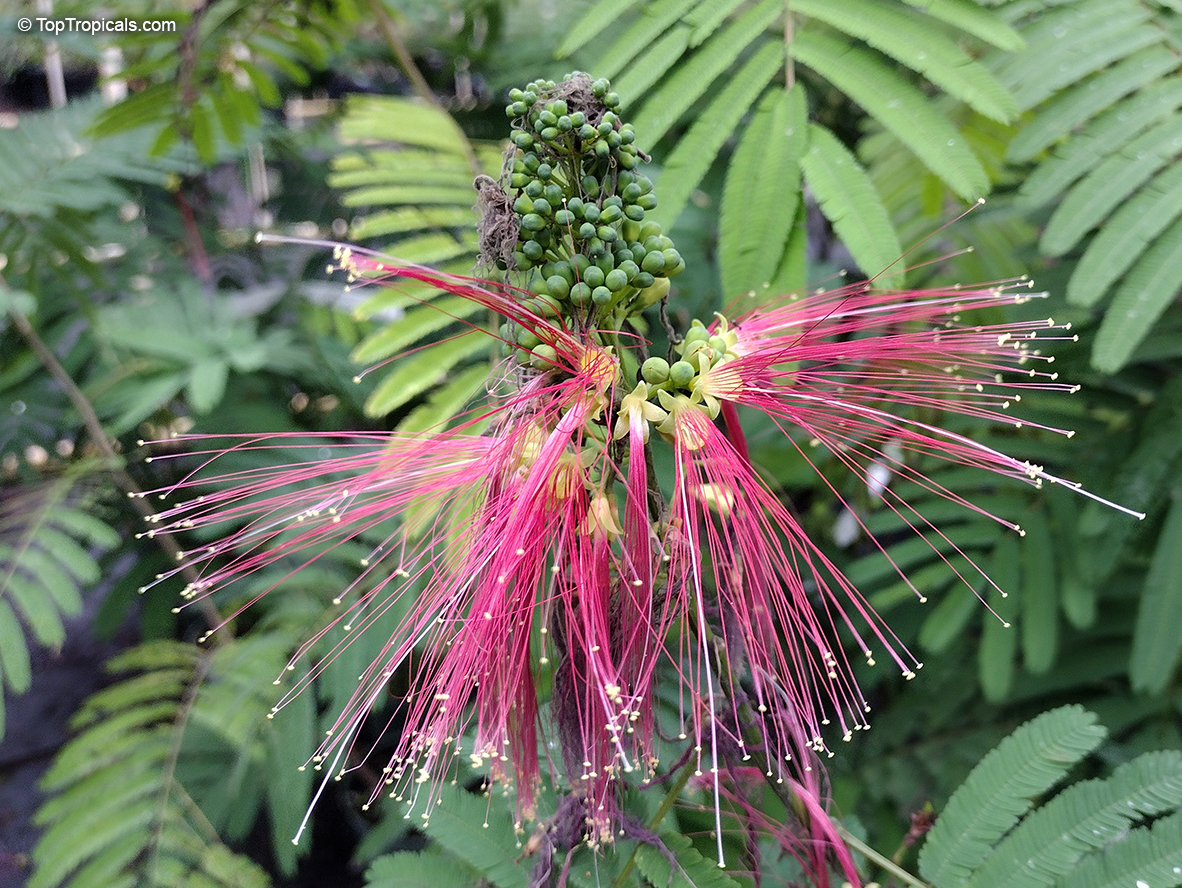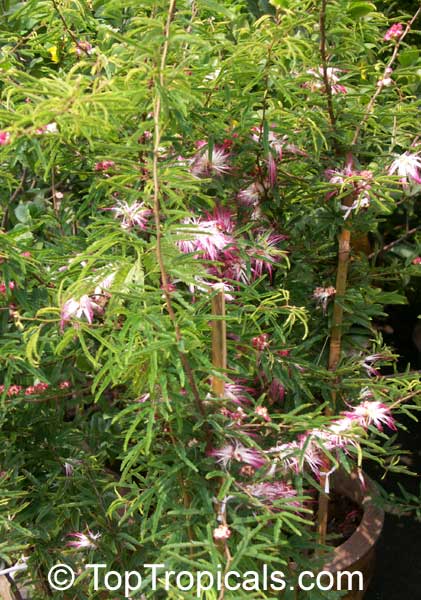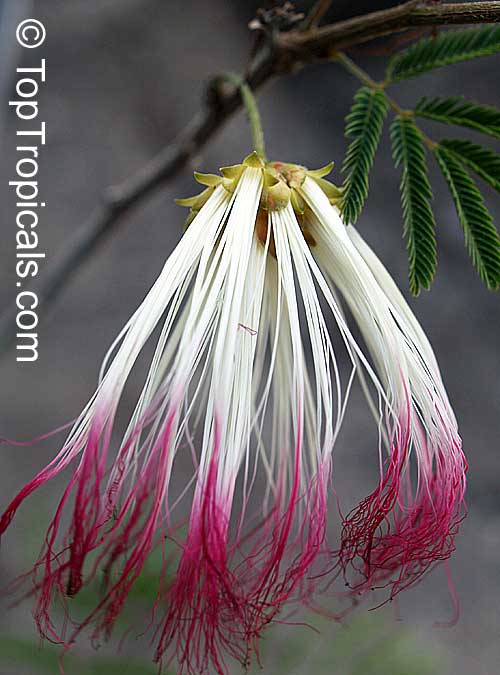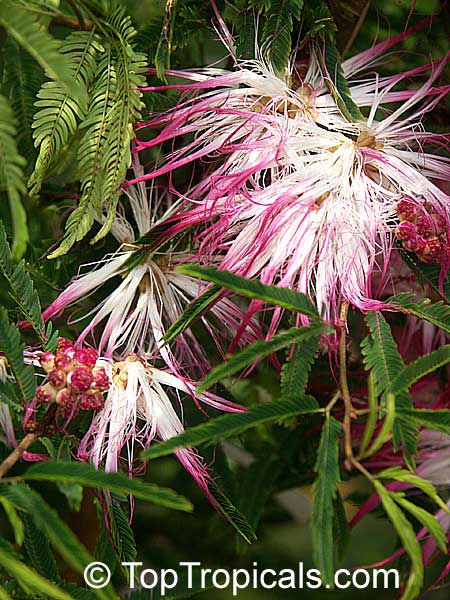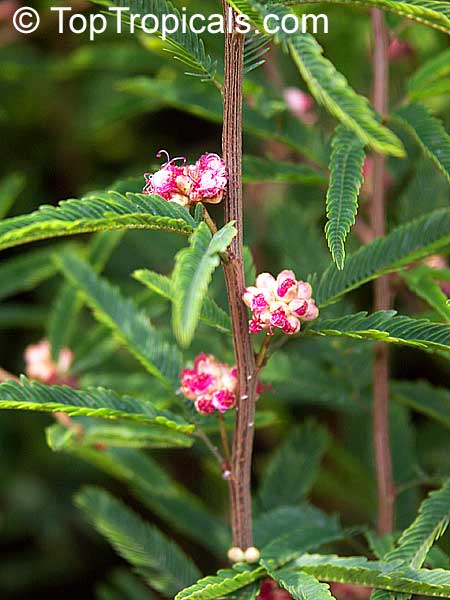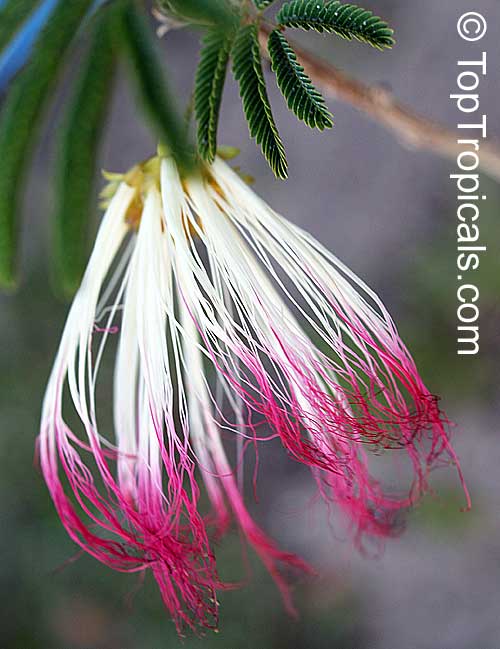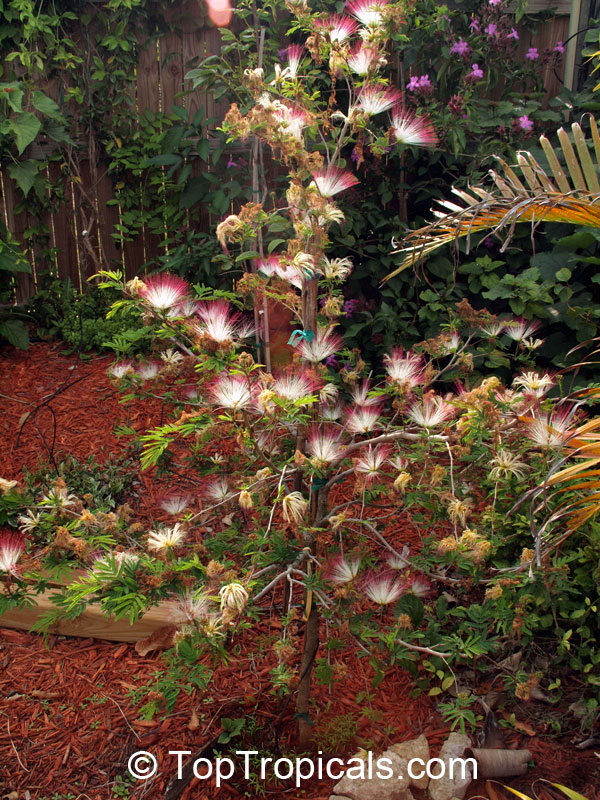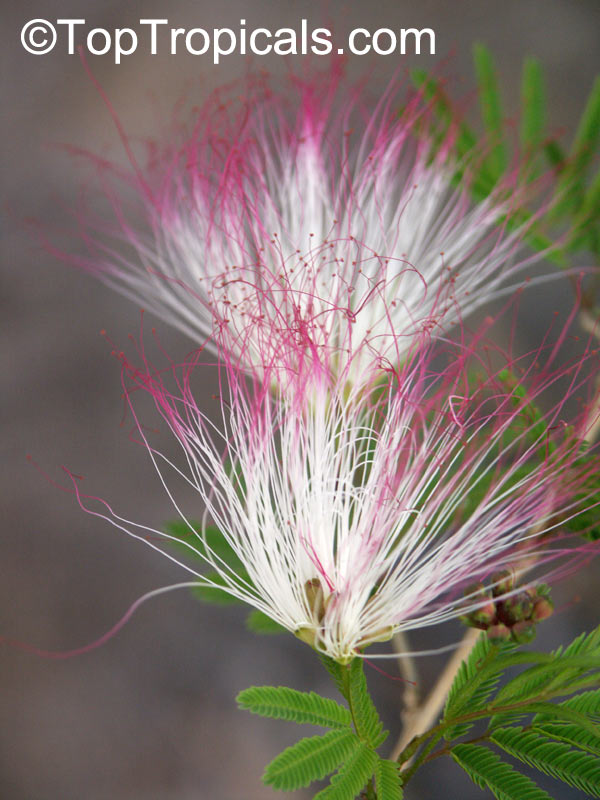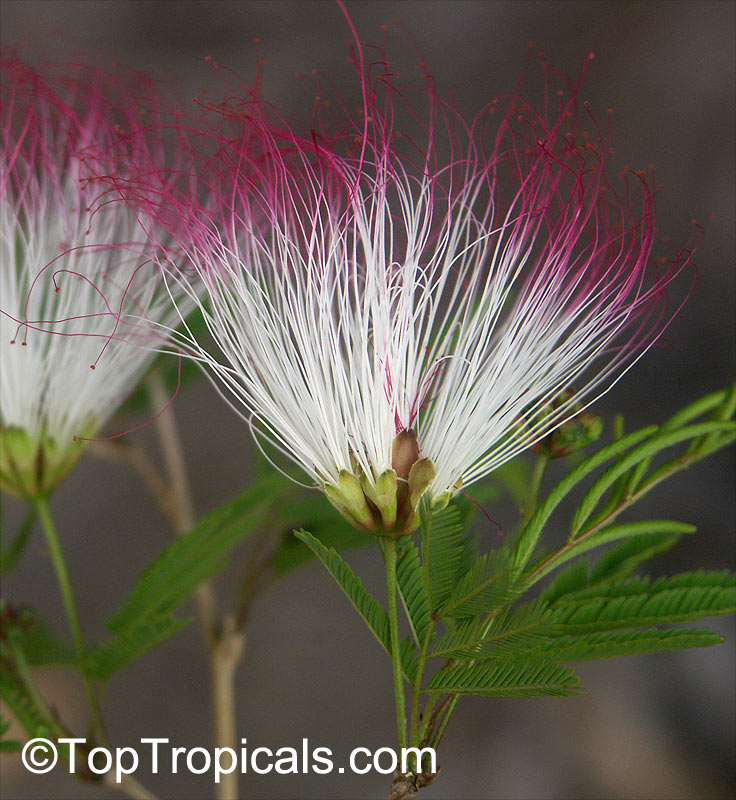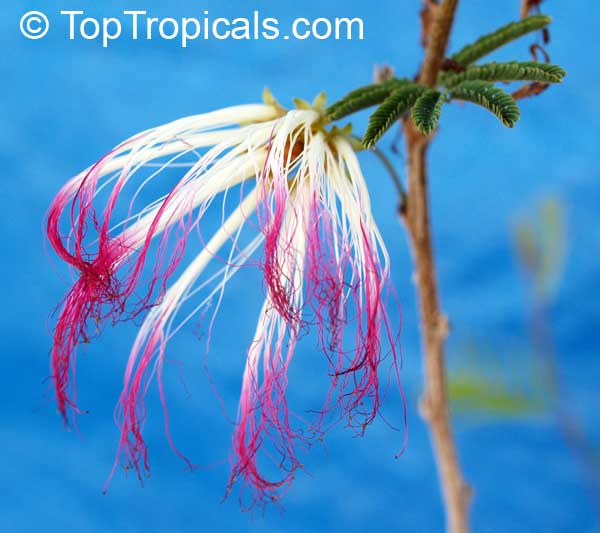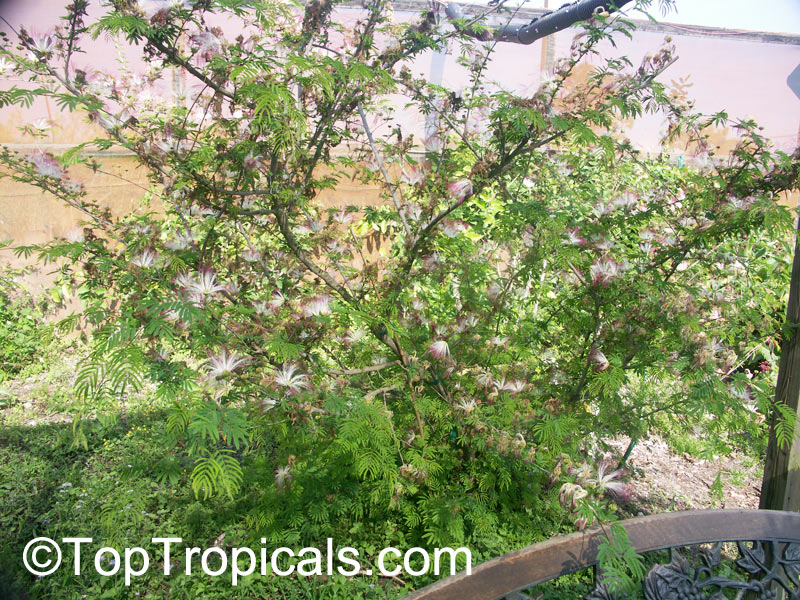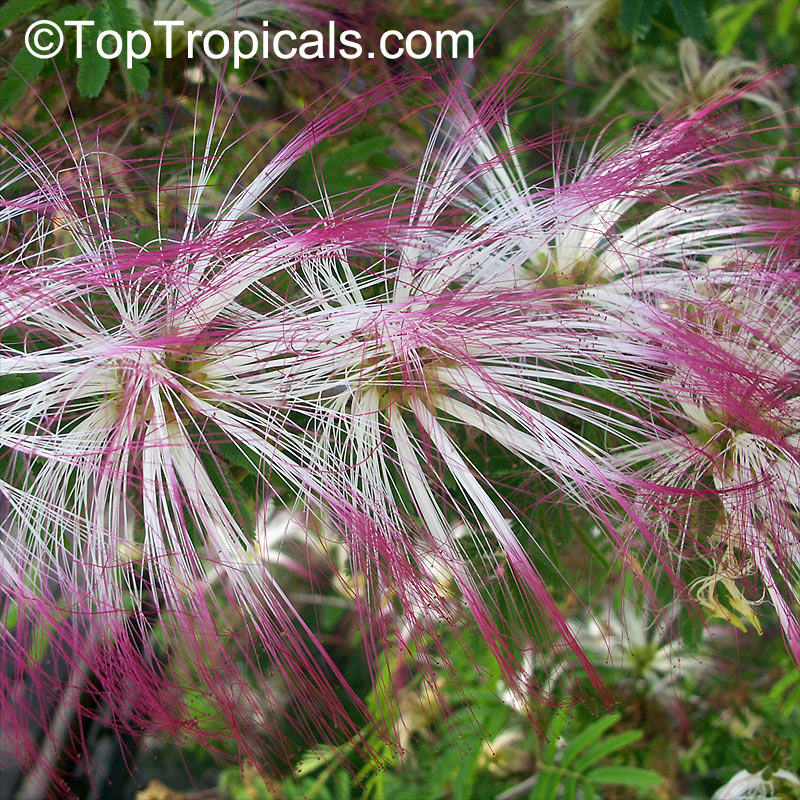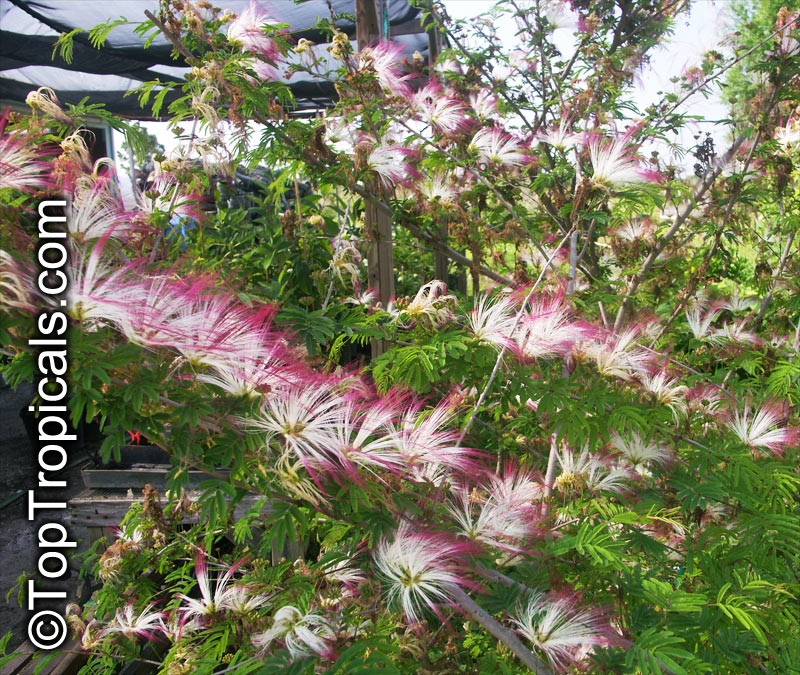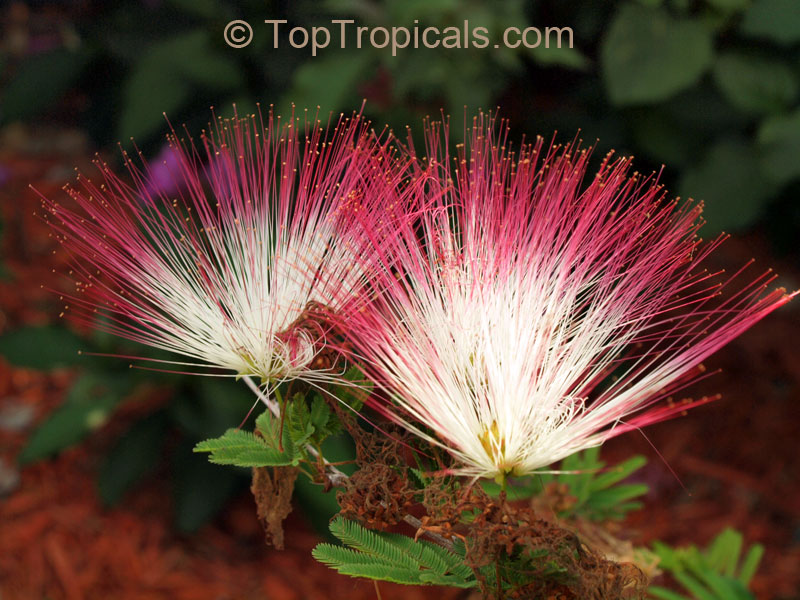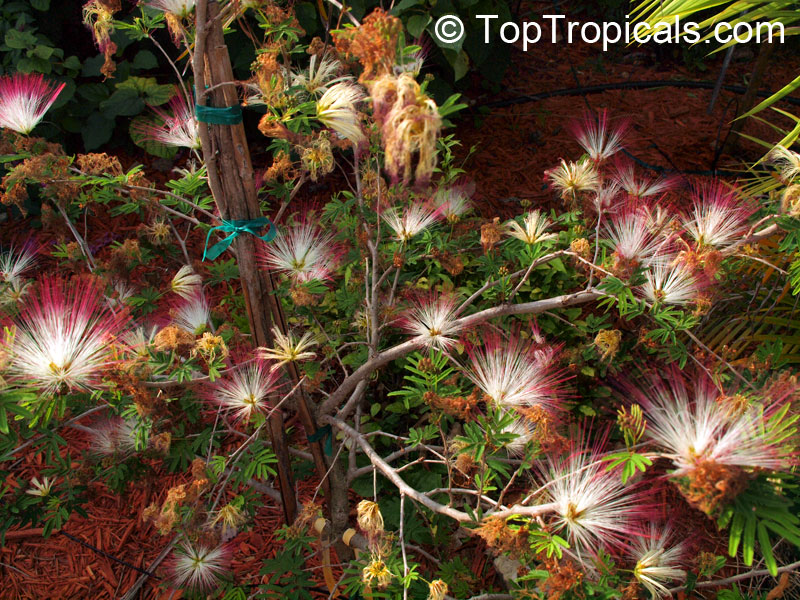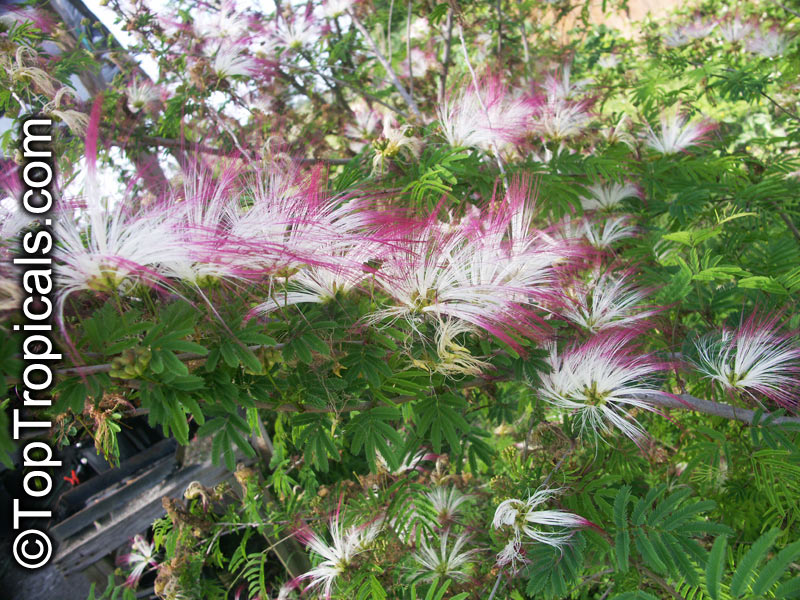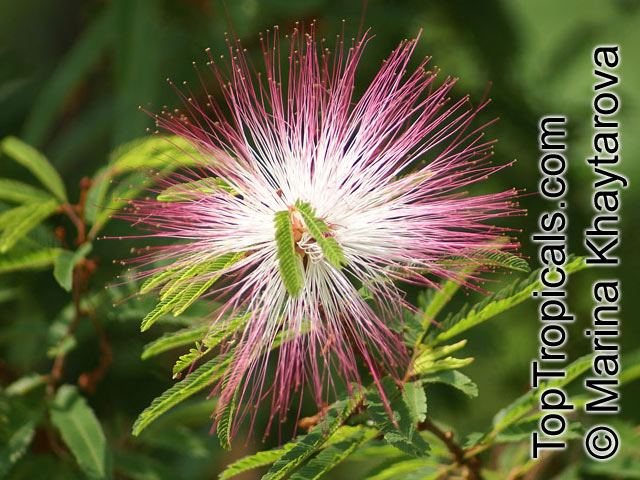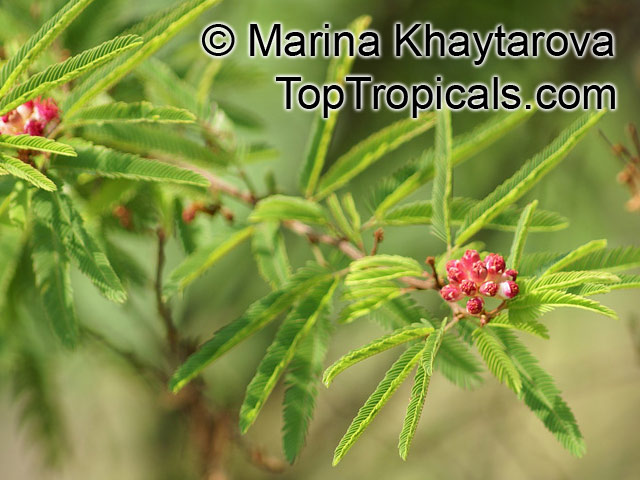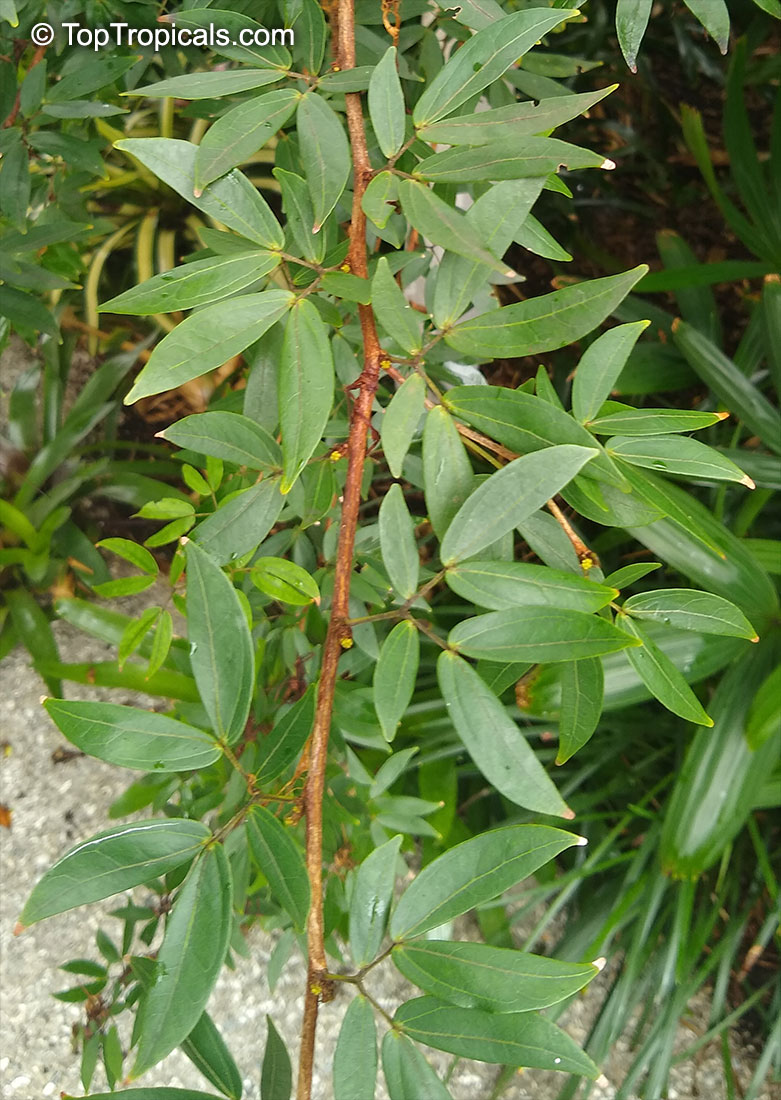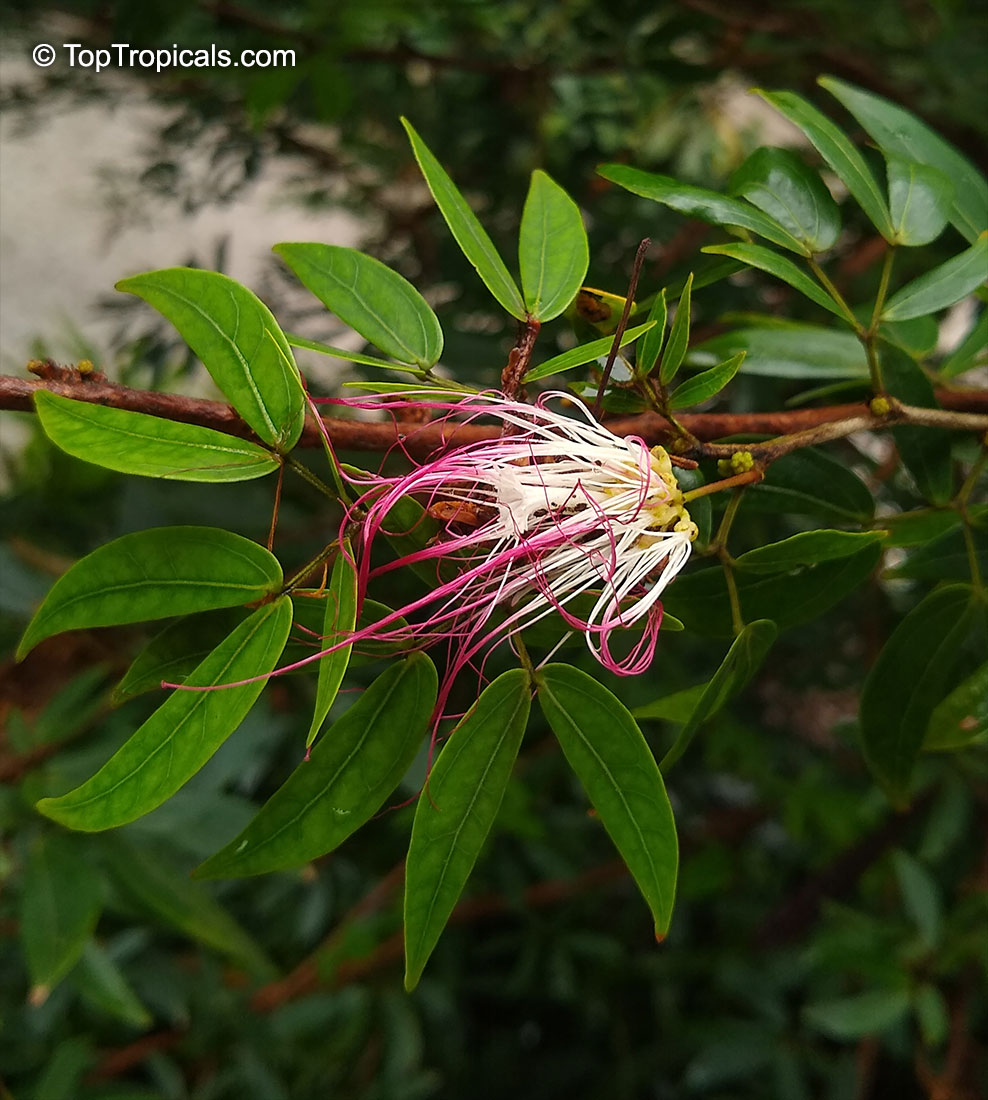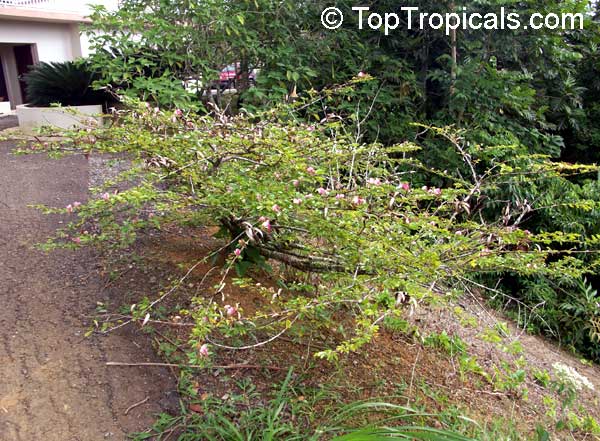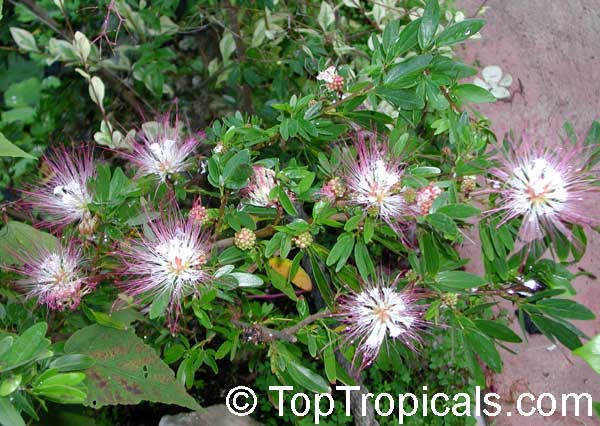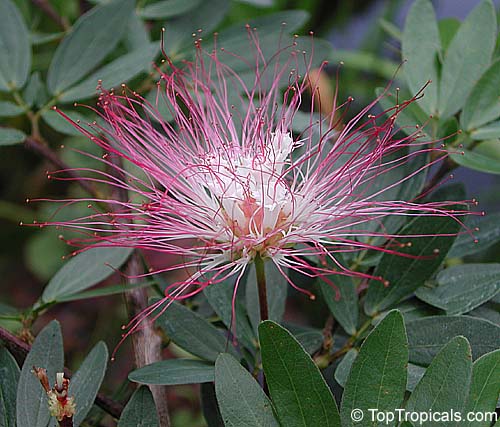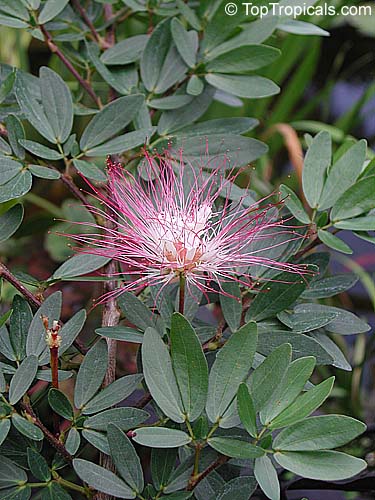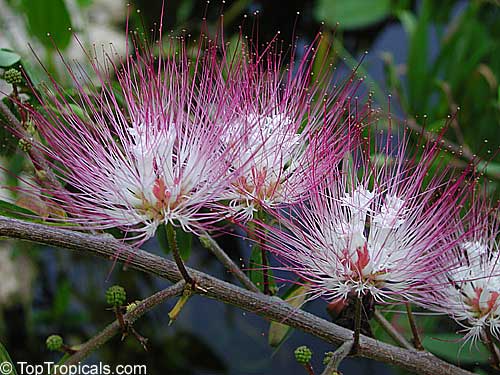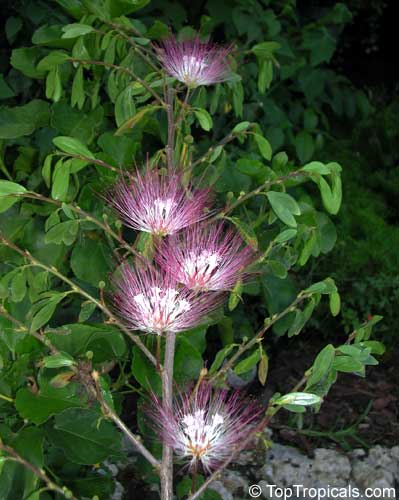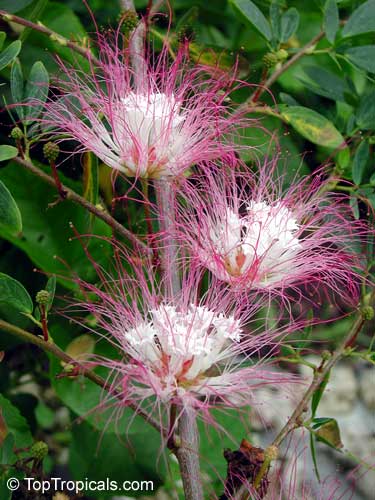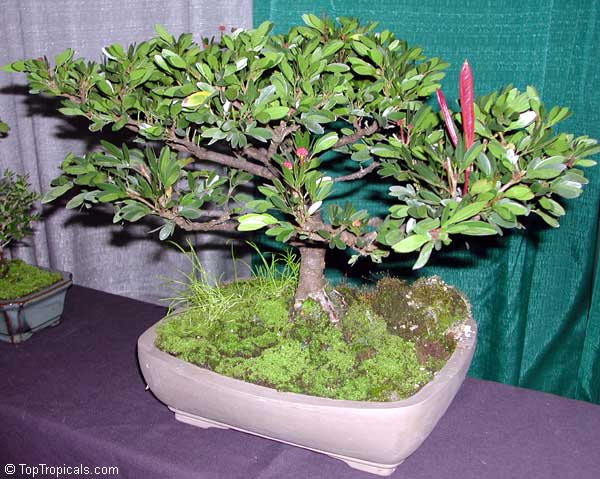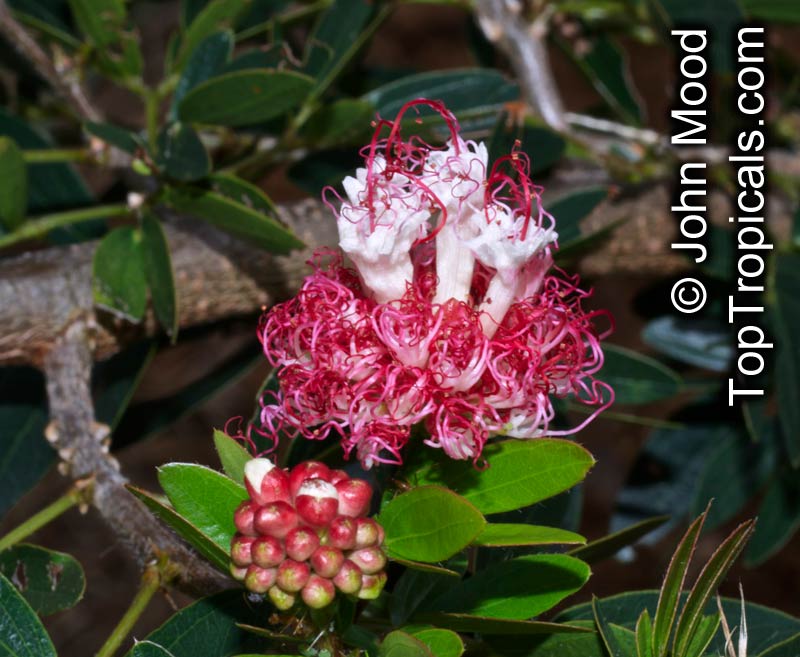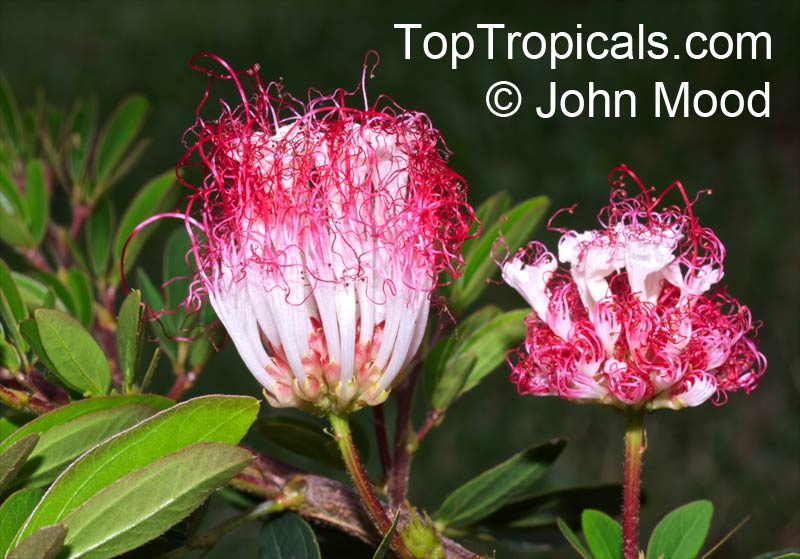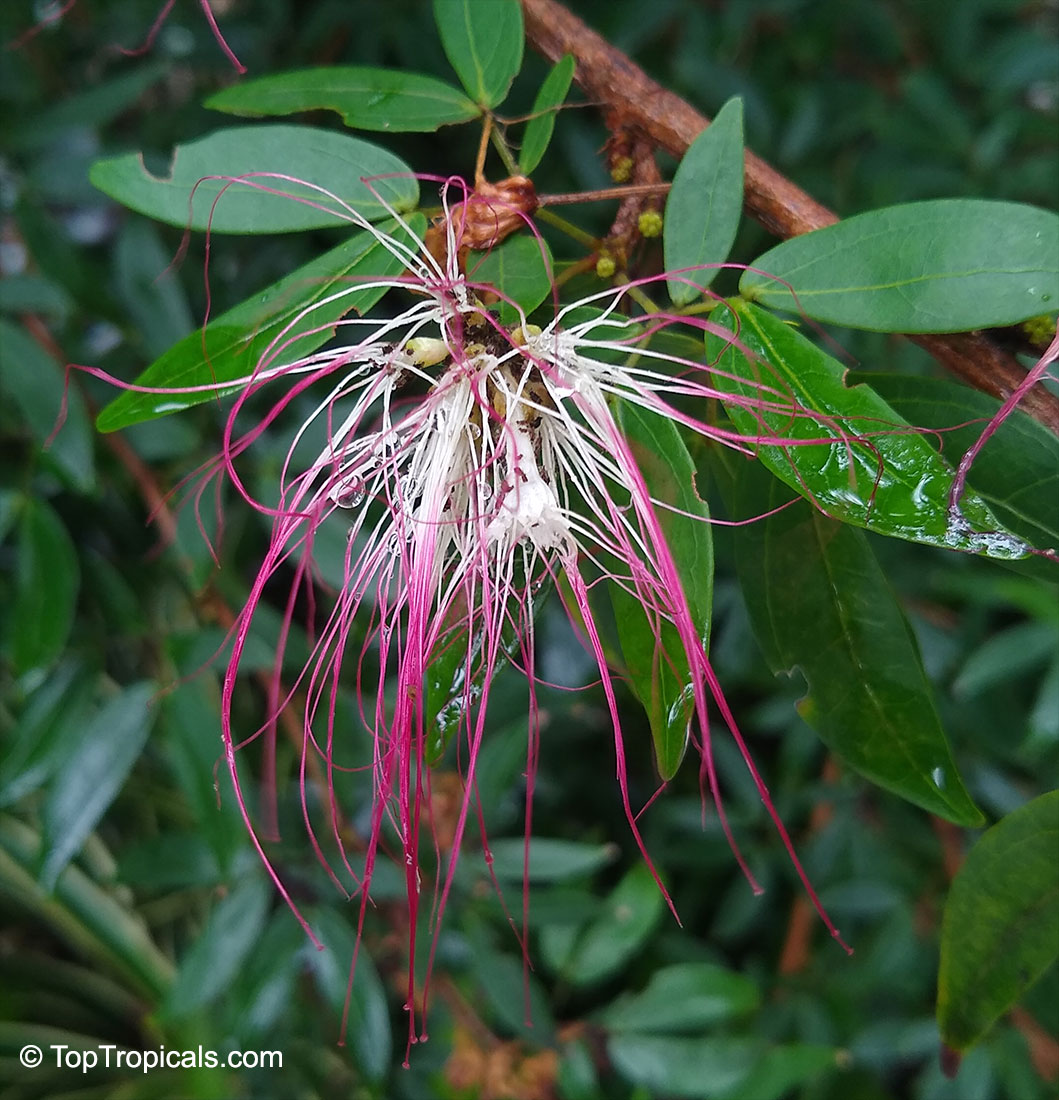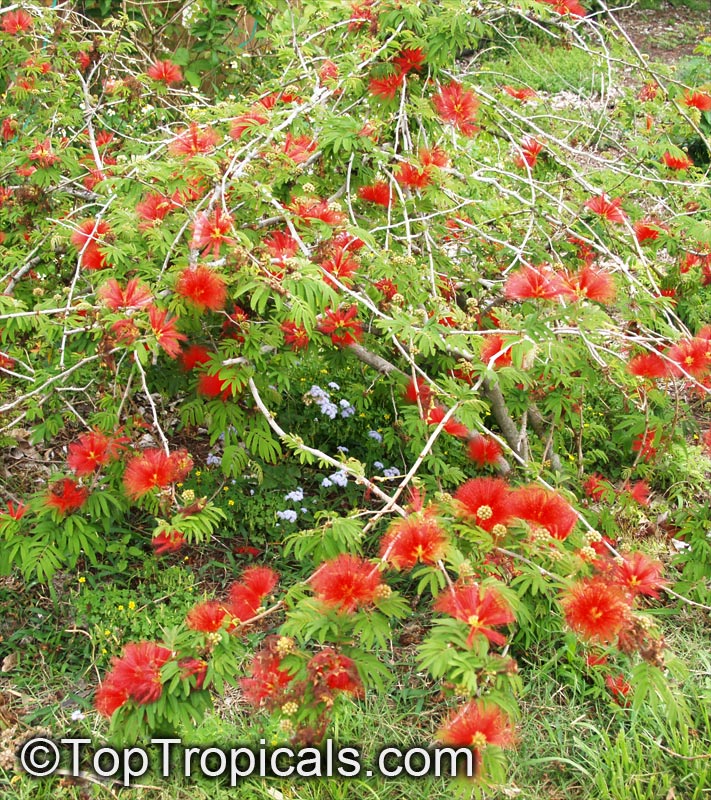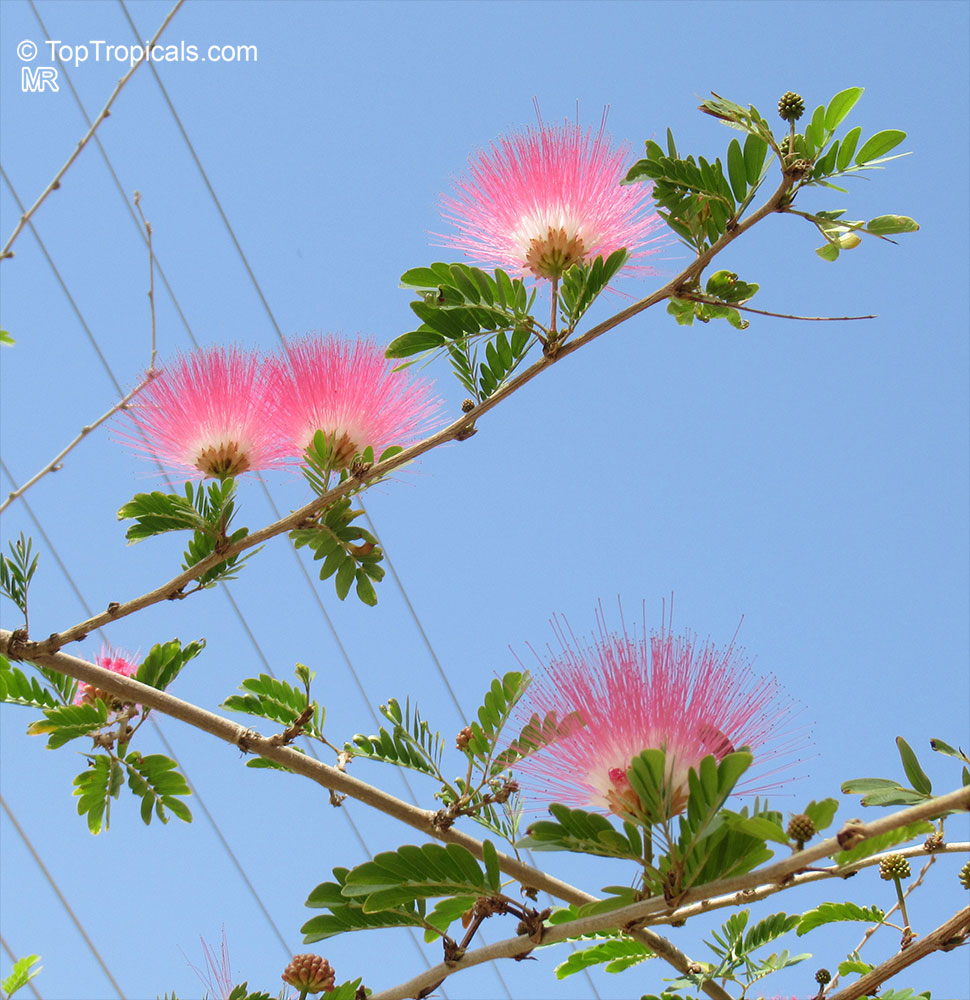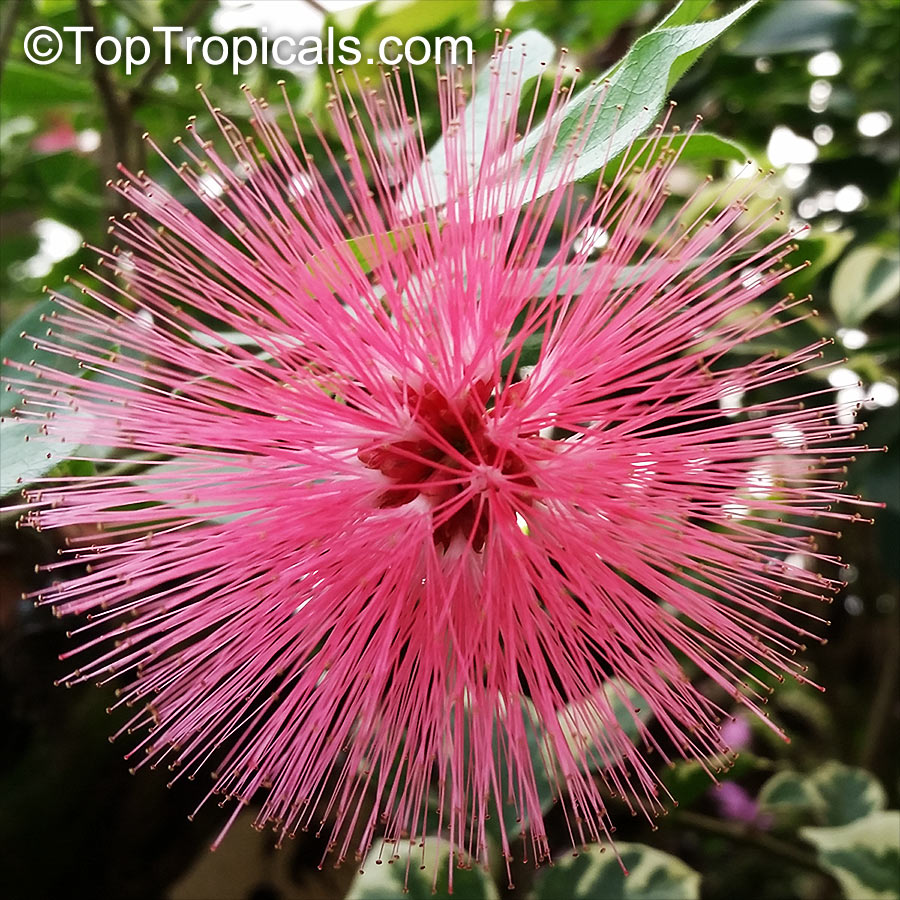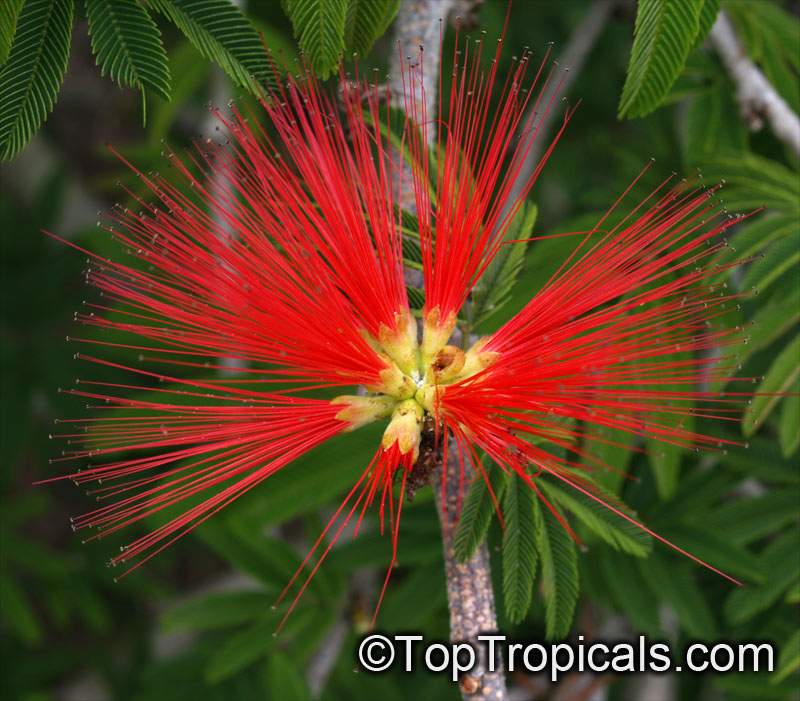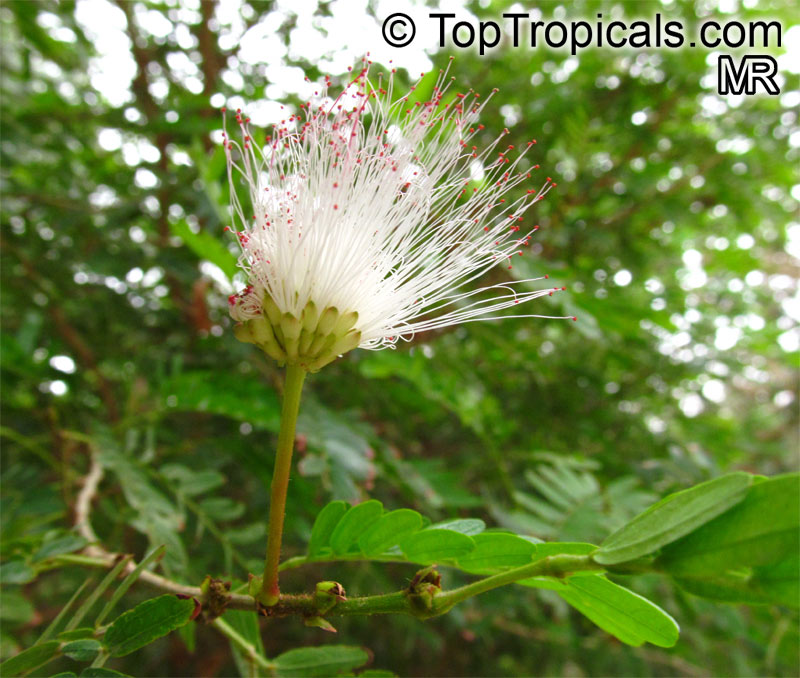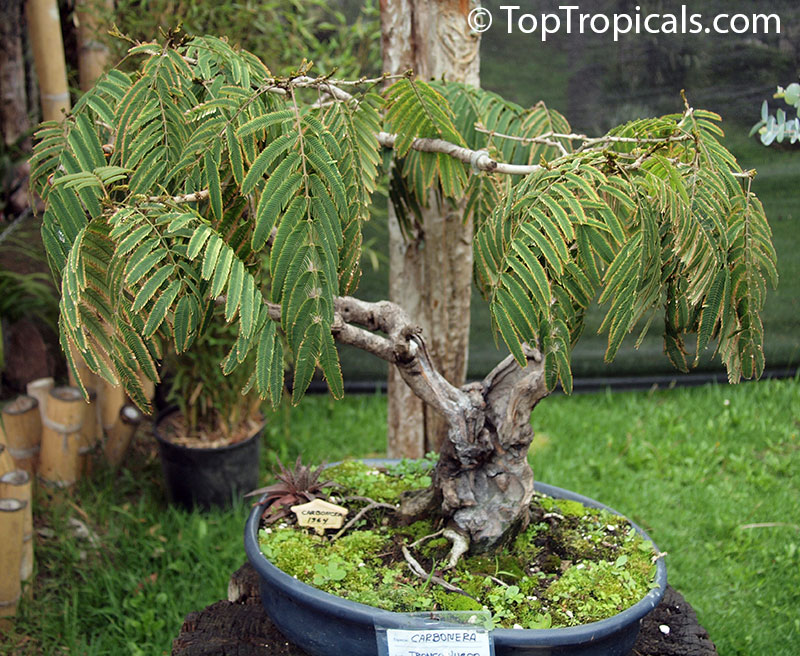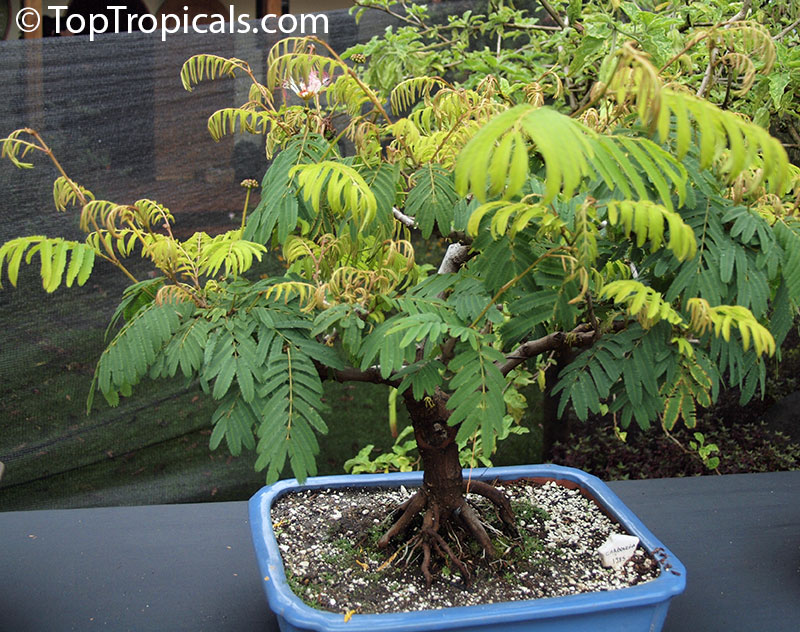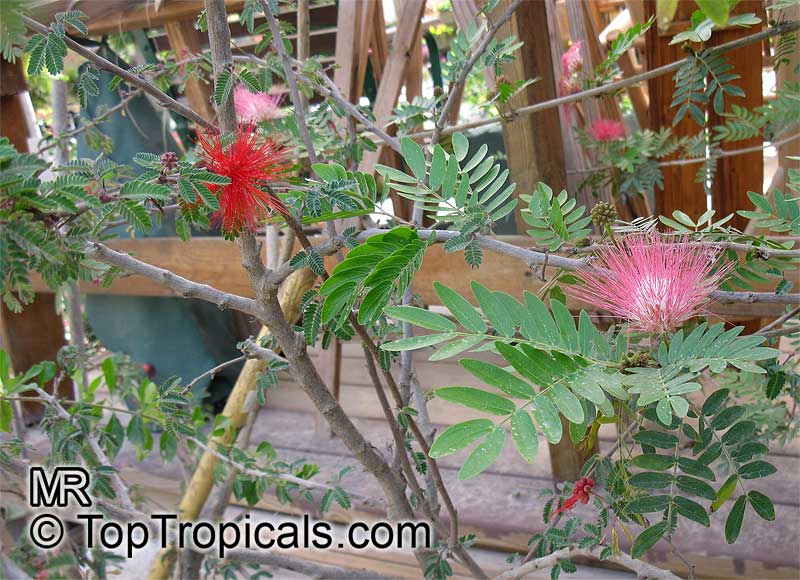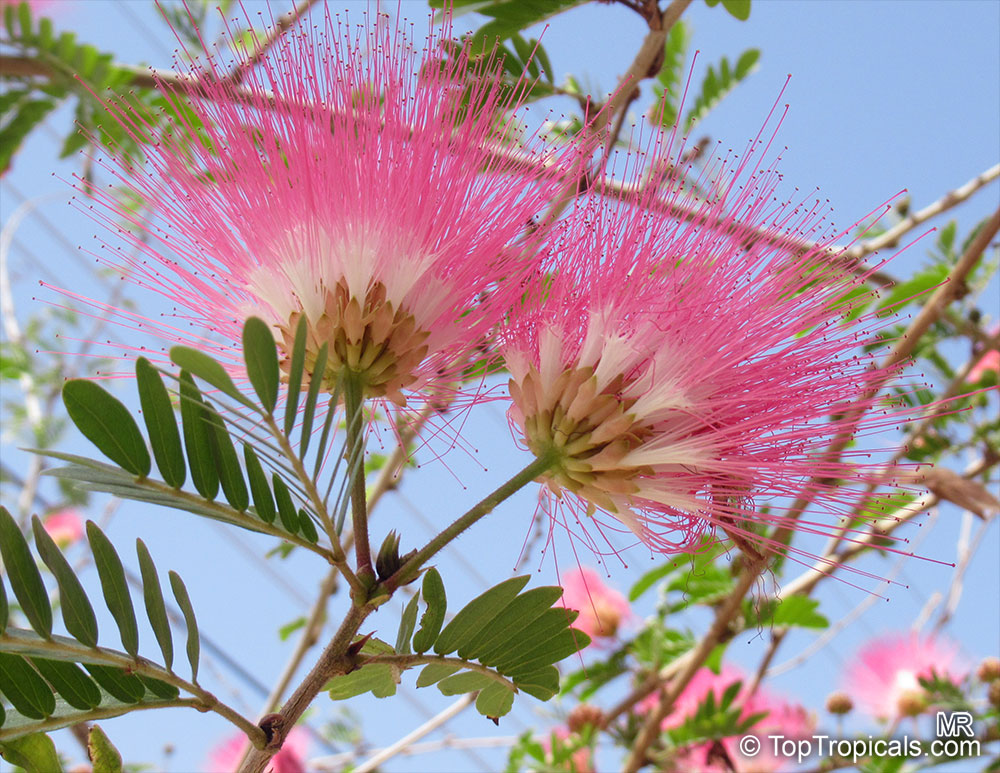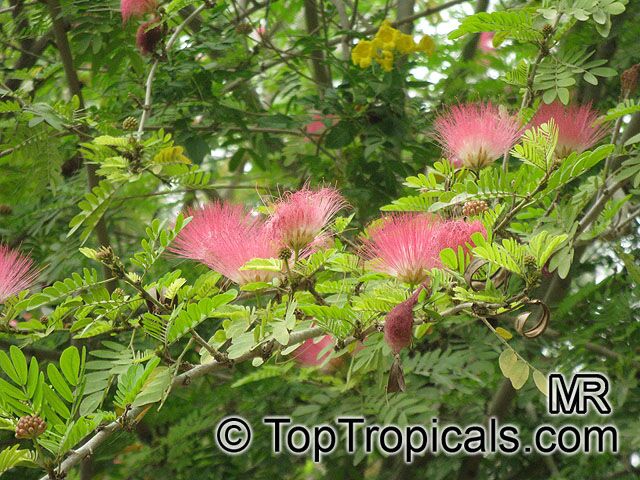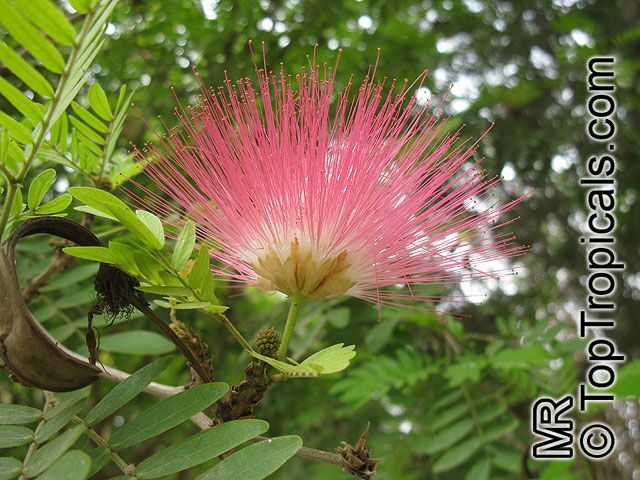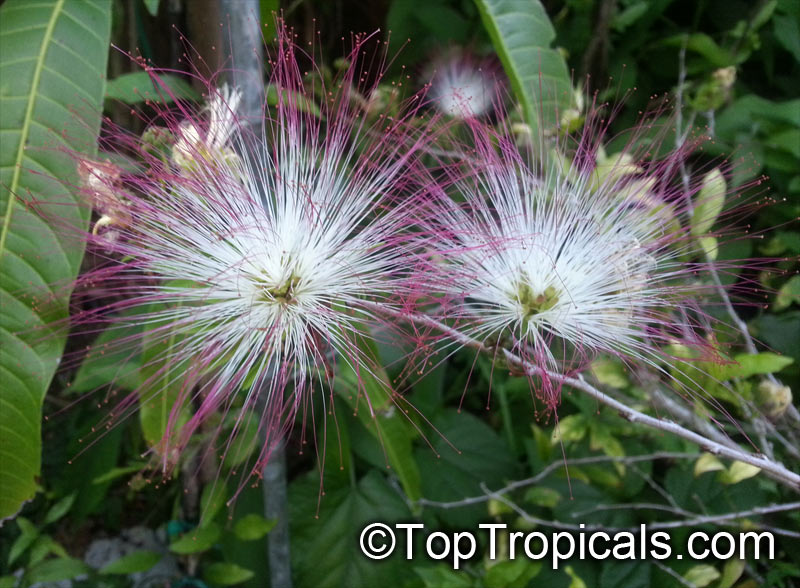Calliandra - Plant Encyclopedia Results
Top Tropicals Plant Encyclopedia
| Number of plants found: 13 | Next | 
|
Go to page: | 1 | 2 |
Botanical names: Calliandra angustifolia, Calliandra stricta
Common name: Bobinsana
Family: Fabaceae
Origin: South America






Bobinsana is a shrubby tree that grows 4 to 6 meters high that is usually found alongside rivers and streams in the Amazon Basin This water-loving tree is especially abundant on the banks of the Huallaga and Mayo rivers in Eastern Peru. Bobinsana can also be found alongside streams in the cloud forests and warmer valleys of the Eastern Andean slopes up to 1500 meters in elevation. Bobinsana produces pretty pink to reddish powderpuff-like flowers.
Botanical names: Calliandra brevipes, Calliandra selloi, Acacia selloi
Common names: Pink Powderpuff, Shuttlecock, Esponja, Esponjinha, Manduruva, Fairyduster, Mesquitilla, Mock mesquite, Quebra-foice
Family: Fabaceae
Subfamily: Mimosoideae
Origin: Brazil







Calliandra brevipes (Pink Powderpuff) is an eye-catching shrub that is native to Brazil, Uruguay, and northern Argentina. It is a robust deciduous shrub that is capable of growing to a height of 10-20 ft (3-6 m). This vibrant, medium to large-sized shrub has finely divided leaves and clusters of beautiful red powder-puff flowers. The petals are inconspicuous, yet the long, pink filaments of the stamens form delicate, pink balls, giving it a gorgeous fluffy pink appearance when it is in full bloom during the summer months.
Calliandra brevipes can be grown in both full sun and semi-shade. Its soil should be kept moist yet well-drained, and it requires moderate amounts of water. Moreover, the plant is a great way to attract butterflies, hummingbirds, and other beneficial insects.
This shrub is not just attractive; it is also hardy and capable of withstanding temperatures of at least 30°F for a short duration of time, making it suitable for cultivation in USDA Zone 9-11. Furthermore, Calliandra brevipes has a delightful and delicate appearance, making it a popular choice for bonsai.
One can easily grow Calliandra brevipes in a pot or container. To successfully do so, find a container that is big enough to accommodate growth and provide the plant with the necessary amount of soil and water. Place the pot in a spot that receives ample sunlight and ensure that the soil is kept moist yet well-drained. Furthermore, if you live in a cold region, it is recommended to bring the pot indoors during winter months or protect it from extremely low temperatures.
Recommended Fertilizer: SUNSHINE Megaflor - Bloom Nutrition Booster
Botanical name: Calliandra californica
Common name: Baja Fairy Duster
Family: Fabaceae
Subfamily: Mimosoideae
Origin: California, Mexico






Botanical name: Calliandra calothyrsus
Common names: Cabello de Angel (Angels Hair), Barbe Sol (The Suns Beard), Red Calliandra, Powderpuff
Family: Fabaceae
Subfamily: Mimosoideae
Origin: Mexico to Northern South America






It will tolerate full sun or semi-shade, but regular watering is a must. In cold regions, Calliandra calothyrsus is suitable for growing in a pot. Pick a pot that is two to three times the size of a root ball and has plenty of drainage. In cold regions, overwintering plants in a pot can be tricky, so it is essential to pick the ideal container. Opt for a large pot that can easily fit your plant and enough soil to insulate the roots. If the container is too small, roots may freeze and die, so it's important to pick the right size. Also, adding Styrofoam beads, mulch, and good insulation around the pot can help the roots stay out of the cold.
Calliandra calothyrsus is definitely worth growing, as it is an ideal plant to attract butterflies, hummingbirds, and other pollinators. Not to mention its showy red, crimson, or vinous flowers and large shrub reaching 5 to 10 ft in height. It is a plant native to Mexico to Northern South America and grown in USDA Zone: 9-11.
Recommended Fertilizer: SUNSHINE Megaflor - Bloom Nutrition Booster
Botanical name: Calliandra haematocephala x surinamensis
Common name: Dwarf Powderpuff Tree
Cultivar: Nana
Family: Fabaceae
Subfamily: Mimosoideae
Origin: Central to South America







Compact variety of Calliandra very close related to C. haematocephala (15 ft tall tree) and C. surinamensis (4-6 ft tall shrub), somewhat between these two species in size that can be grown as a small 7-10 ft tree or a medium shrub. Very dense beautiful foliage, leaves are somewhat smaller than C. haematocephala. Bright pink powderpuff flowers, everblooming. Makes excellent specimen tree or container plant.
Botanical names: Calliandra haematocephala, Calliandra inaequilatera
Common names: Rose cascade, Blood Red Tassel Flower
Family: Fabaceae
Subfamily: Mimosoideae
Origin: Nicaragua to Ecuador







Calliandra haematocephala, commonly known as the Rose cascade, is a popular tropical plant native to Nicaragua to Ecuador. It grows as a large shrub 5 to 10 feet tall and can also reach heights of 10 to 20 feet as a small tree.
This plant prefers to grow in full sun and moderate water, although it can tolerate occasional periods of drought. Calliandra haematocephala boasts clusters of dense, pink, white or off-white or red, crimson or vinous flowers, which appear in winter and spring. The flowers measure 2 to 3 inches in size and look like big red or white puffs. This plant typically begins blooming in late winter and continues until late spring.
To ensure healthy growth, it is best to trim the Rose cascade after it finishes blooming. Fertilize twice a year with a balanced slow-release fertilizer and water regularly to keep the soil evenly moist but not soggy.
This plant can be grown in USDA Zones 9 to 11. In cold regions, this plant will thrive in pot. The pot should have drainage holes, and it is a good idea to place a layer of gravel at the bottom of the pot to ensure proper drainage. The pot should be brought indoors during the colder months to protect the plant from frost.
A hardy and beautiful cultivar, Calliandra haematocephala makes a reliable addition to any garden.
Calliandra means "beautiful stamens", and several of the approximately 150 shrubs and small trees belonging to this genus are grown for their dense heads of pink or white silky stamens that appear on short stalks along the upper sides of the branches. The species name haematocephala comes from the greek for with blood-red head.
Recommended Fertilizer: SUNSHINE Megaflor - Bloom Nutrition Booster
Recommended Fertilizer: SUNSHINE Megaflor - Bloom Nutrition Booster
Botanical name: Calliandra houstoniana
Common names: Tree Calliandra, Red Powderpuff
Family: Fabaceae
Subfamily: Mimosoideae
Origin: Mexico to Northern South America
Hardiness: 30°F







Calliandra houstoniana is a fast growing small tree or large shrub with fine feathery foliage and bright red fine structured powderpuff flowers. This species is very close to calliandra calothyrsis, but the flowers open fully, unlike c. calothyrsis, where the flower opens gradually from the bottom to the top.
The genus Calliandra contains 132 species. Most are endemic to the Americas, but a few species are endemic to the South Asian subcontinent or Africa, including Madagascar. Most species are shrubs or small trees, although a few are large trees or herbs.
Ordering seeds info
RECOMMENDED SUPPLIES:
Seed Germination Mix #3, professional grade
SUNSHINE-Epi - Seeds and cuttings booster
SUNSHINE Bombino - Young Plant Booster
Botanical name: Calliandra parvifolia
Common names: Powderpuff, Pink Calliandra, Plumerillo Rosado
Family: Fabaceae
Subfamily: Mimosoideae
Origin: The Americas






Calliandra parvifolia, commonly known as Powderpuff, is a large shrub that produces pink flowers and can grow to be 5-10 feet tall. The small leaves on this species are white and off-white, and it blooms almost year round with clouds of pink-white powderpuffs. It is native to the Americas and is often grown in USDA Zone 9-11.
When growing Calliandra parvifolia, it should be placed in an area with full sun or semi-shade and should receive regular water. The soil should be kept moist but not soggy. In cold regions, the plant should be grown in a pot to ensure it is insulated from any cold weather and can easily be moved indoors during extreme cold. During the warmer months, it can then be moved back outdoors.
When planting this species, the soil should be well-draining, and the roots should be spread out in the hole. After that, give the plant a thorough watering, and make sure to check the soil moisture regularly. Once the plant is established, mulch can be applied, and it should receive regular feeding with a fertilizer.
Calliandra parvifolia is an attractive and hardy shrub that can provide many years of beauty in the garden. With its pink flowers and white-off-white leaves, this species can bring a splash of color to any garden.
The genus Calliandra contains more than 100 species, most of which are endemic to the Americas. Most species are shrubs or small trees, although a few are large trees or herbs.
Botanical names: Calliandra riparia, Calliandra schultzei
Common name: Dwarf Powderpuff
Family: Fabaceae
Subfamily: Mimosoideae
Origin: Southern Mexico, Panama, Bolivia










A dwarf variety, perfect houseplant, good for bonsai. Beautiful oriental looking plant.
Fluffy, pink "powderpuff" flowers that attract hummingbirds and butterflies.
Grows as a small, bushy shrub in pots but can develop into a larger, bushy tree when planted in the ground
Thrives in full sun to partial shade and becomes drought-tolerant once established.
A dwarf variety, perfect houseplant, good for bonsai. Beautiful oriental looking plant.
Fluffy, pink "powderpuff" flowers that attract hummingbirds and butterflies.
Grows as a small, bushy shrub in pots but can develop into a larger, bushy tree when planted in the ground.
Thrives in full sun to partial shade and becomes drought-tolerant once established.
Recommended Fertilizer: SUNSHINE Megaflor - Bloom Nutrition Booster
Last one
Botanical name: Calliandra sp.
Common name: Powder Puff
Family: Fabaceae
Subfamily: Mimosoideae
Origin: Tropical America
Hardiness: 30°F









Calliandra is a tropical or subtropical shrub or small tree native to the Americas, known for its fluffy, powder-puff-like flowers in shades of red, pink, or white. It has fine, feathery foliage and blooms profusely in warm climates. Fast-growing and drought-tolerant once established, it thrives in full sun and well-drained soil, attracting bees, butterflies, and hummingbirds.
| Next |  |
Use link to repeat this search:
https://toptropicals.com/cgi-bin/garden_catalog/cat.cgi?find=Calliandra&search_op=and&keyword_op=and&language=e&number=10
&no_change_lang=1&user=tt&sale=1&first=0
